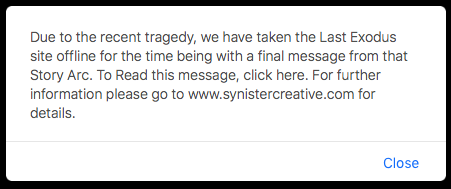The Last Exodus by Barudak
TLETISAOTTALD
Original SA post
Last Exodus the Interactive Story Arc of the Third and Last Dance is a roleplaying game from Synister Creative Systems published in 2001 and designed Sean and Joshua Jaffe. It’s a metaplot heavy, playing card deck using, religious themed urban grunge game. Unless I am otherwise notified it appears to be completely out of print with no digital versions available. Should this be incorrect I will update to include where it can be bought to give the original developers income.
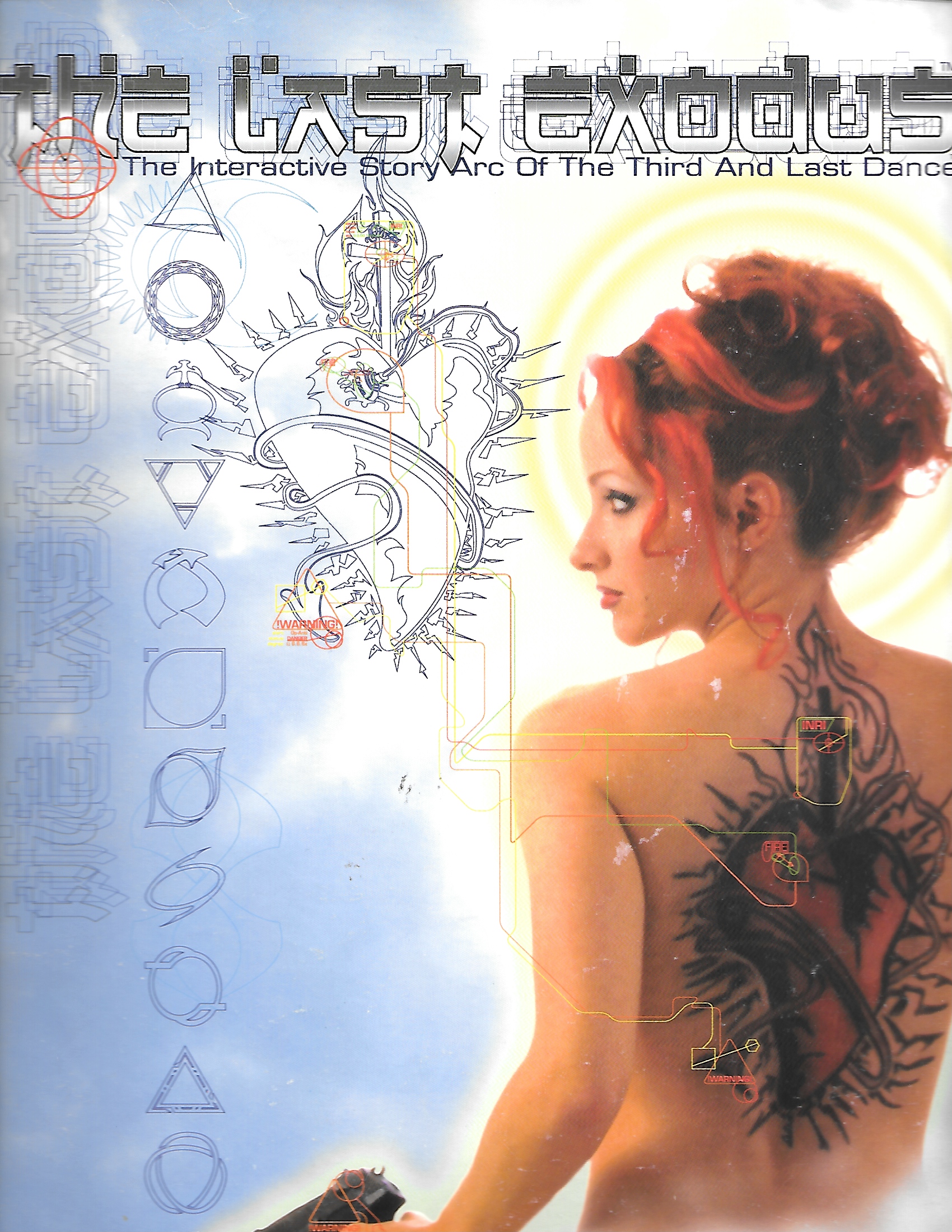
INRI does not appear in this game, so I don’t know what thats about on the cover
Model: Enigma / "Tattoo": Derek Stevens / Title and Design: Joshua Brain Jaffe / Sacred Heart Logo: Santino Alvarez, Frank B. Fallon, Joshua Brian Jaffe
Part 1: TLETISAOTTALD
For those curious, no, I didn’t make up that title, the full name of the game is in fact “The Last Exodus the Interactive Story Arc of the Third and Last Dance.”* There is no semi-colon in that title, it just goes like that.
So as we start our Third and Last Dance, lets check out the back of TLETISAOTTALD, because normally when you dig into a game reading the back of the book is illustrative of the sort of thing you’re getting into. The back of TLETISAOTTALD has little text, but starts with, “In 1981 the second coming of Christ was born a Muslim girl in Medugorje, Yugoslavia.”* You may notice that this sentence is both theologically stupid and culturally suspect on several levels and missing a word that would make the two sentence ideas come together properly**. Welcome to TLETISAOTTALD.
In terms of general overview TLE (I’m not going to stick to using its full name, and the game sure as hell doesn’t after the outside cover and first time it is introduced) is a painfully 90s game coming out in 2001. It unironically uses the word “metaplot” to describe its story, is about the whole world lying to you, and is filled with grungy, urban aesthetics about a corrupt world. It’s unique things as far as I can tell is abysmally terrible page layout and using playing cards for conflict resolution. Something else that will stick out like a sore thumb to any reader is that the book came out in early 2001, pre-9/11 and boy fucking howdy does that color a lot of this book.
The game is divided into 4 main sections, called “Testaments” which cover according to the game History, World, Character, and System. I won’t be sticking to one testament = one update simply because thats too much to cover in a post but we’ll be following the general structure of the book because I’m a firm believer that the way a book is laid out is part of the experience. See below for our first, worrying example of why book layout isn’t going to be this game’s strong suit.
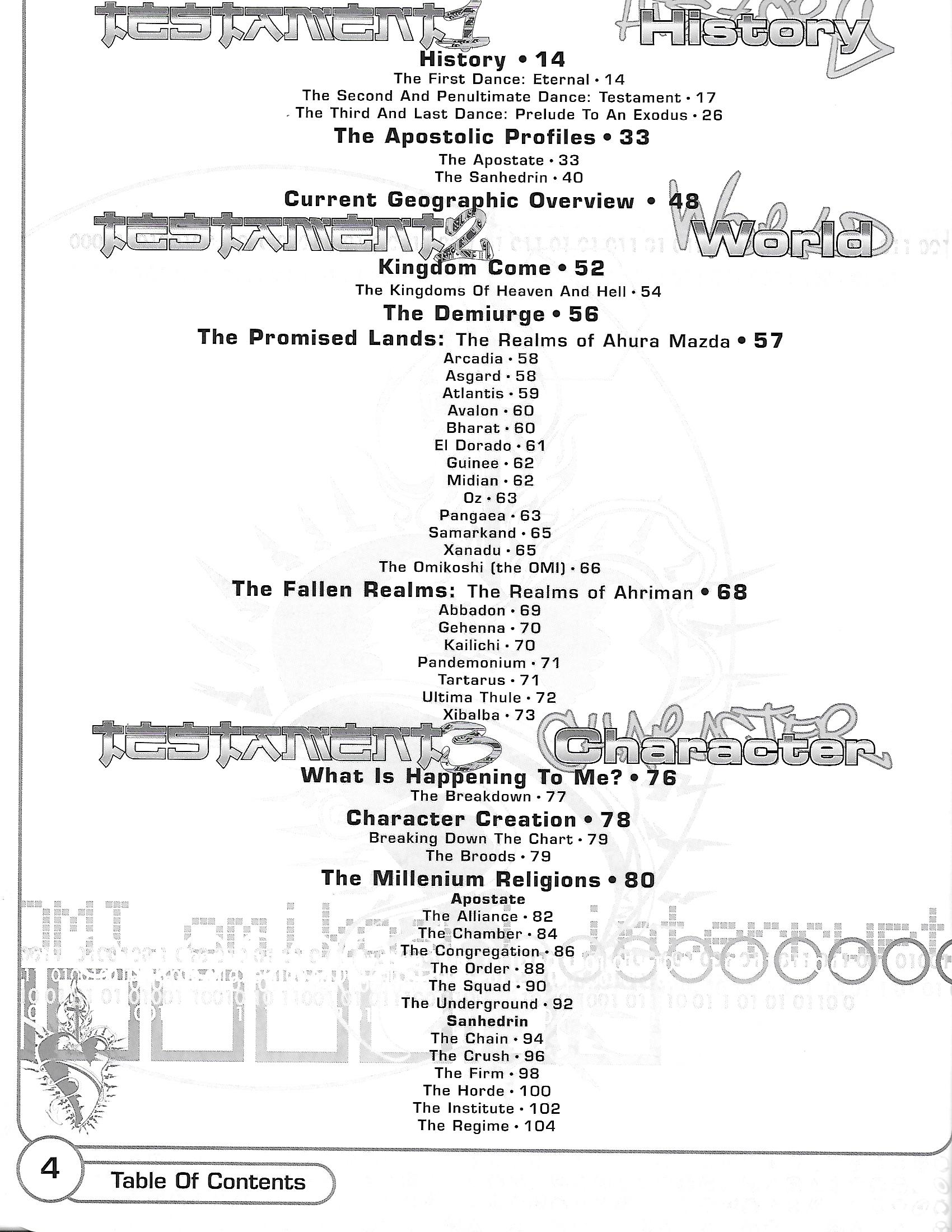
I’ve actually managed to cut-off the barcode and barf top of the page frame and overexposed the page spanning watermark image so consider yourself lucky.
In terms of content, more products were planned and they’re mentioned in a section called “Upcming Products”, spelled exactly that way, but this review will only cover the core book. In true tabletop fashion one of the “Upcming Products”* appears to have been intended to cover fully half of the game’s core setting and the mechanics therein, and the sales pitch description of the book does a better job explaining the game’s setting than the entire first 56 pages of this book. Further, the only information I could find on TLE with a cursory search was post convention reviews of the core book before it released so I’ve got a suspicion those “Upcming Products” might never have come out. One of the reviews did give it a 5/4 so I must really be in for a treat or the reviewer used the same editor that TLE used.
Since I couldn’t find any art from the game online, no joke searching the game name gave me other tabletop games with completely different names because Bing doesn’t know what the fuck, all the art moving into this is going to be my own attempts to upload this stuff and give credit based on the books credits page. Artwise, TLE is a complete and utter mess of styles with absolutely no coherent theme, but I’m pretty sure if you’ve read this far you’re not surprised. It also occasionally drops an errant secondary sexual characteristic into some of the work so I’m going to be selective in what I share.

Yes, the game has a fake film credits. Yes, half of those are real people and half are setting characters. Yes, there was a naked woman’s butt above this picture, so that’s why you’re only getting this part of the image.
Finally, in closing to our introduction, Joshua Brain Jaffe, I know that this book layout was done now 16 years ago but according to your LinkedIn you do this professionally still to this day so I just want to say please, do not include this in your portfolio of work or you will lose business. Your mustache also hurts those you love.
Next Time: Starting the Book, Badly
*For those wondering about typos, Gareth Michael-Skarka was the book’s sole editor, so presumably he planned to fix them about 7 years before the book went to print but never got around to it.
**If you are the first to correctly guess how this was supposed to read I will give you a shout-out in the form of an overly detailed song quote
Starting the Book, Badly
Original SA post
Preface: Last Exodus the Interactive Story Arc of the Third and Last Dance is a roleplaying game from Synister Creative Systems published in 2001 and designed Sean and Joshua Jaffe. It’s a metaplot heavy, playing card deck using, religious themed urban grunge game. Unless I am otherwise notified it appears to be completely out of print with no digital versions available. Should this be incorrect I will update to include where it can be bought to give the original developers income.
Part 2: Starting the Book, Badly
To kick off this part, please understand I didn’t intend to write so much about what constitutes about 6 pages of content total. Unfortunately for both of us, instead of getting to gobble up some dire metaplot, we need to work through the extremely bad way this game starts off and the frankly awful advice it gives new players. Worse for you, for some reason TLE uses non-standard size pages so it doesn’t play nice with my scanner so you’re just going to have to learn to deal with the image quality I can provide.
That out the way let’s start this game up and… slam immediately face first into a wall of gobbledygook. Ostensibly we open the book with an article written by an in-universe character named Nicholas Van Zant in an underground Zine called “Seig Heil Giuliani”. By the by, TLE is pretty self-serious and expects you to play every thing it presents very straight-faced.

I feel you, buddy
NVZ’s rambling article, as it turns out, is basically a cliche-salad. It’s about how the world is super dull and nothing interesting happens in it and everyone is a mindless drone and we were all promised super cool things like a world war and nuclear armageddon. Yes, the game compares “flying cars” equally with “nuclear armageddon” as things we were promised and denied by our lame real-world present*. In the last 3 paragraphs it finally sets up the premise of the game by saying that right now, thousands of messiahs are being born who will reshape the world.
We then, after jumping past the table of contents, get a disclaimer. Why this isn’t page one and instead after the table of contents I don’t know and I couldn’t tell you. I’m not going to copy it since it’s quite long and mostly concerned with saying that if you’re offended about their usage of religions to pass on this book, and that for those who don’t pass on it they hope experiencing and roleplaying this deep and mature subject matter will leave you a changed person. Hilariously though, the very first thing the disclaimer talks about, yes even before it discusses religion and its smug sense of self worth, is to make it extremely clear your characters are not meta-plot important.
Remember those thousands of messiahs the book led off with? That’s right, the game follows its tease of its setting by telling you in no uncertain terms you can’t be the important people or influence the story. This my friends, is the TLETISAOTTALD experience.
We then get another passage of pointless navel-gazing from NVZ, with some paragraphs appearing to be copied or earlier versions of the introductory fiction mentioned above. As you attempt to read this additional, confusing, metaplot conflicting word salad TLE interrupts with a breakout box to quote you some lyrics by Dream Theater with full and complete artist attribution and where you may note the name of this game was lifted from. This will be a recurring theme throughout the book down to each faction having a specific lyric and song.
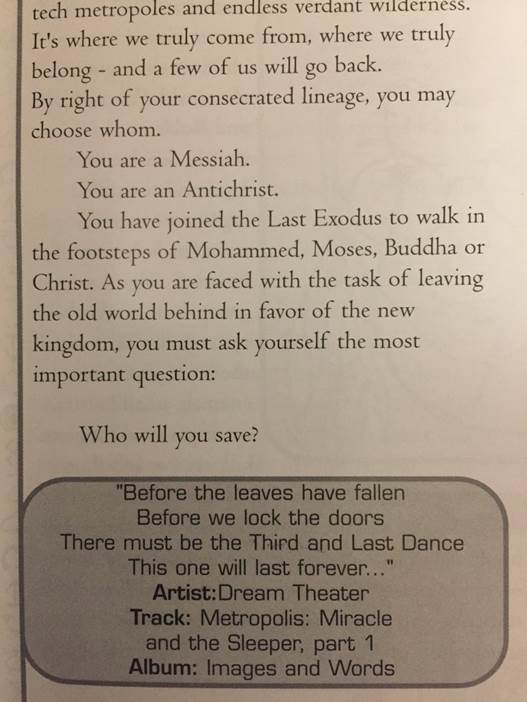
Turns out there are surprisingly few songs featuring noted cool person “some FUCKING LIAR”’s username
We are then introduced to the game’s three main annoying textual commenters at the same time as the game tries to introduce what this book is for. And I mean literally the same time, some of these text boxes overlap and interrupt each other and start at different elevations on the page so there is no good way to read this at all. The commentators exist to have different perspectives, chat dialogs with each other, and provide additional information by interrupting the flow of the text they’re talking about completely. The layout actually gets worse after this page, if you believe it.
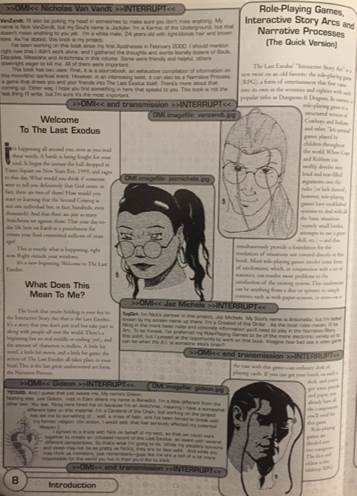
No matter where you choose to start reading, you lose
Art: Peter Johnson
The “what is this book” section that the commenters are yelling over states the book is for playing a roleplaying game, and then for no discernable reason then explains to us what a LARP is in detail even though the only rules for LARPing in this book are 6 paragraphs at the back of the book. The game helpfully points out that this book represents only the beginning of a story, not its middle or end and before that sentence even ends tells you that they are writing towards a specific ending. Following the Charlie-Brown-kicking-the-football of player agency, It then in a single sentence sums up how little TLE respects its players:
“This will allow you and the other players in your group to shape your own little corner of The Last Exodus’ continuing story or “metaplot”.”
After telling you that you can’t disturb their metaplot, what can you do in TLE? Well there are two kinds of roles to play, starting with a
After deciding which of your egotistical and cruel friends will be Director, time for a description of the other role, Players. Somehow, the game finds another poisoned well to dredge up some bad advice and says that within a story like the Matrix, Morpheus would be a Director controlled NPC. It then shames the guy in your group who can’t make it regularly by calling him Tank which, damn, cold. You may have noticed I’ve describe a bunch of jokey references to the Matrix but not mentioned what players actually do, but that’s because the book actually doesn’t either. It, in reference to what are a player’s responsibilities, says verbatim:
“[...] all the players require is the ability to show up.”
The game then explains a role-playing campaign as a concept. Despite the fact the game literally titles itself as THE INTERACTIVE STORY ARC it tells you one-shots are totally valid. Despite this, TLE contains no actual rules for one-shots and the rules all fully assume you’re playing a long, ongoing narrative based on their metaplot.
We need to stop for a moment now, and this is skipping ahead slightly, but I feel like I really need to call this out. This is normally the part where the book will tell you to play an ongoing narrative**, tee-up it’s metaplot, and really get you salivating at the prospect of reading 18 pages of not even comic-book level writing. The problem here is, TLE doesn’t contain even a single adventure or objective to kick off its INTERACTIVE STORY ARC so you actually can’t play the game’s story using the core book.
Lastexodus.com was supposed to complement this book and give you your metaplot updates from there, no need for setting books. In fact, even if they printed any of the listed “Upcming Products”, none of those books are adventures or story content. Somehow, this book contains 18 pages of pure metaplot backstory and 40 pages of setting detail and a set of throw-away, single paragraph-long suggestions for possible alternate campaign plots at the back of the book are more playable than the INTERACTIVE STORY ARC the game is named after.
We then get one of those one-act plays that are a description of play. During this description of play, the Director makes one of the players do a check which, when passed, reveals that there is nothing he could learn using that check with the note that the director is literally smirking in amusement at trolling his player by making him do a pointless check.
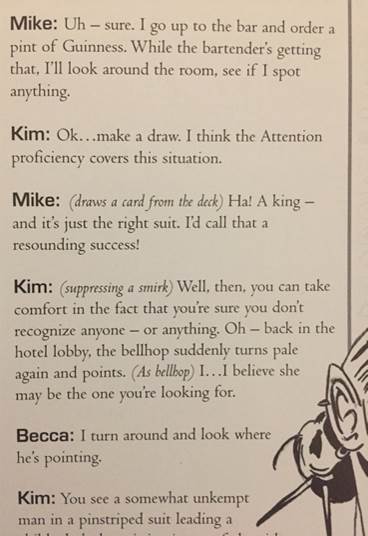
You can’t spell “My name is John Wick” without “Kim”
Art: Derek Stevens
In summary; TLETISAOTTALD
Next time: Adventures in Page Lay-PLOT AND BACKSTORY-out
*Spring 2001, you were so magical
**The game uses Casablanca as an example of a one-shot story. It uses a different example, obviously, for ongoing narratives like it is trying to cultivate. First one to guess correctly gets a shoutout in the next section.
Adventures in Page Lay-PLOT AND BACKSTORY-out Part 1
Original SA post
Last Exodus the Interactive Story Arc of the Third and Last Dance is a roleplaying game from Synister Creative Systems published in 2001 and designed Sean and Joshua Jaffe. It’s a metaplot heavy, playing card deck using, religious themed urban grunge game. Unless I am otherwise notified it appears to be completely out of print with no digital versions available. Should this be incorrect I will update to include where it can be bought to give the original developers income.
Part 3: Adventures in Page Lay-PLOT AND BACKSTORY-out Part 1
Here we are, finally at what the game is so proud of the Metaplot. Unlike other games of its ilk, there is no warning that this section is for Directors only or that players should only read select passages. No, this confusing, poorly laid out godawful mess is for everyone to read and it starts with probably the single worst laid out page in the book from a pure readability standpoint, but the book will make other less grievous unforced errors.
Before we are six paragraphs into our setting details, the the commenters are interjecting. And I mean that literally, as they break into the columns where the story text is located. Worse, they are explaining a term that hasn’t occurred yet, and in this case, doesn’t occur until after the second of the commenter interjections. This happens constantly over these 18 pages and completely derails what little story flow there is.
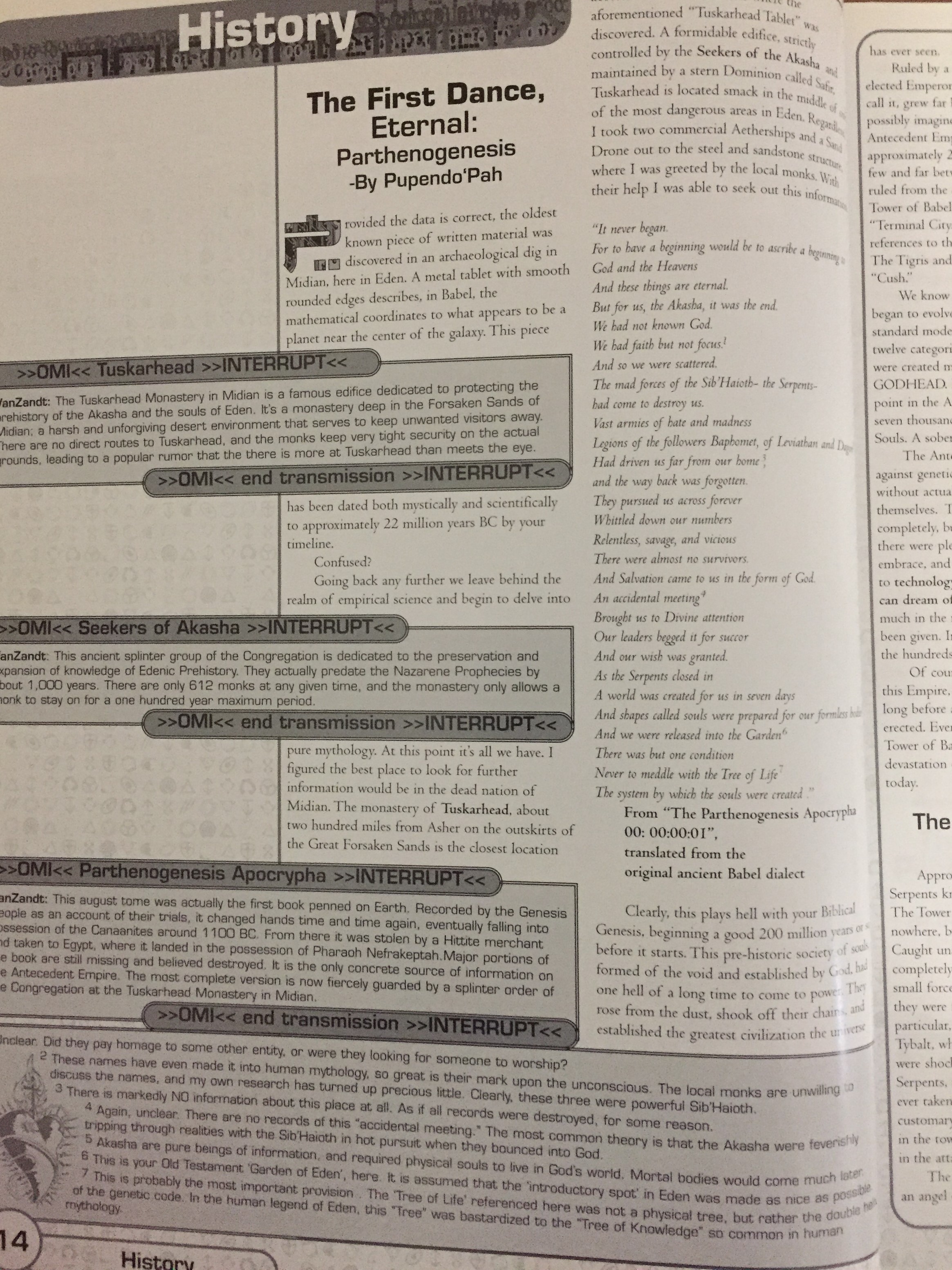
Very smart poster Evil Mastermind would never layout a page this badly. The plot series other than Star Wars it mentions? James Bond
Worse, TLE has a habit of forgetting that it is introducing new terms to you or that it’s using certain words at all. The words Midian* and Eden appear in the first sentence of the metaplot on page 14, but don’t get an actual definitions until pages 62 and 54 respectively. Midian doesn’t hardly gets referenced again until then, so it’s not like context clues can help you. Worse, TLE’s metaplot freely starts referring to characters by other names and assuming you inferred that they have another name.
For example, the least jarring of these the name “Ahriman” is used interchangeably with “GODHEAD” in the text. It does thankfully, shortly after tell you they're the same person, but then chooses to use the names in the most annoying way possible. It will use GODHEAD for several paragraphs in a row, switch to a new story, and then begin using Ahriman exclusively before switching back again. Not all of these multi-names are made clear, and there were a couple of times in this story that I re-read some of these passages trying to figure out who previously unmentioned characters were before jumping ahead in the book to the setting section to find out it was just another name of an already mentioned character.
The metaplot dump is structured into 3 major periods, called Dances, with no explanation as to why they’re called Dances other than the authors of TLE really liked Dream Theater**. There’s no overall timeline, but the game is constantly giving you dates in both BCE and it’s made up useless time-scale so it’s not a challenge to piece together but a little tedious. Amusingly, the game’s timeline tries to have a truly epic scope but ends up being absolutely hilarious when it claims the universe was formed 200 million years ago and then has the ovaries to say:
“Clearly, this plays hell with your biblical genesis, beginning a good 200 million years before it starts”
Anyway, this story is extremely convoluted despite almost nothing happening in it and not being very long. The entire metaplot of this game is only 18 pages which sounds like a lot but in a game that is 196 pages long and a genre where metaplots have a tendency to eclipse 30 or 40 pages it is genuinely brief. As is par for the course for this sort of 90s heartbreaker metaplot dumpster-fire, only about 3 of those plot pages will ever have any relevance to players sitting at a table. The whole reading experience is actively made worse because as mentioned before despite being 18 pages long it doesn’t tell you enough about the setting to play the game. You have to backsolve from the game’s rules to figure out how its setting is supposed to work, and I’m sure I did that wrong.
So, instead of diving into the games metaplot in this update, I’m going to give you a setting summary that does not exist anywhere in game based on what I’ve gathered.
- Our world “Earth” and another world “Eden” are in a video game light world/dark world relationship. You can travel from Earth to its parallel point on Eden, but not from anywhere on one to anywhere on the other.
- Messiah*** is the name for any soul that can at whim cross the boundary between Earth and Eden
- Earth and Eden have separate Gods who are both idiot children, but Eden’s God is human’s original creator and the story attempts to consistently portray them as the good shade of grey
- Earth God and Eden God have finally declared all out war on each other in the year 2000, and while they are the creator of their respective realms, they have forward operating bases in each others dimensions
- There is no discernable reason that anyone in the setting would be secretive, attempt to infiltrate society, or do anything really instead of going immediately as loudly as they could to rally their side for the war, but the game seems to be built on an underground grunge aesthetic ripped straight from White Wolf so they just do
- Not only is there no reason, the game doesn't even support the idea as there are no skills in any form of stealth, thievery, or impersonation but there are separate skills for your ability to sexually entice people and for the sex itself
- People have to take sides in this war to… do something that isn’t ever clarified.
- Eden explicitly does not have Oreos™
Lastly, let me include some digging by Digital Raven to round out the lack of thought put into the story of a game with the phrase INTERACTIVE STORY ARC in it’s title.
DigitalRaven posted:
I got curious because I couldn't remember seeing anything of worth on lastexodus.com when I first got the book (shortly after release). Sure enough, the Wayback Machine confirms it…
That's from May 16th. Skarka's involvement makes all deadlines impossible. So if you got the book at release, you had none of the promised updates for over a month.
The next update is post-9/11 (Wayback captured it in November 2001), and includes a link to the Red Cross and this pop-up:
I vaguely remember the site having advertisements for upcoming books in the meantime (and no metaplot updates), but I can't find any direct evidence of that.
I promise, next time we’ll actually learn this game’s stupid, stupid story.
Next Time: The Metaplot As She is Vomited Forth
*The book changes the spelling of this word at seeming random to Median. Thanks, Gareth-Michael Skarka
**If the first song introduced in this book gave it its title, the second song gave the book its genre inspiration. What film soundtrack is it from? Be the first to guess right for a shoutout.
***Fun Fact: The game explains this a scant 55 pages after introducing the term
The Metaplot As She is Vomited Forth
Original SA post
Last Exodus the Interactive Story Arc of the Third and Last Dance is a roleplaying game from Synister Creative Systems published in 2001 and designed Sean and Joshua Jaffe. It’s a metaplot heavy, playing card deck using, religious themed urban grunge game. Unless I am otherwise notified it appears to be completely out of print with no digital versions available. Should this be incorrect I will update to include where it can be bought to give the original developers income.
Part 4: The Metaplot As She is Vomited Forth
Finally, time to get to this game’s precious metaplot. TLE splits it into three sections, with only the third really having any bearing for players. Since my eyes glaze over whenever I try to read these massive blocks of uninspired text, and there is genuinely about 6 pictures across all 18 pages, let’s instead do highlights of each section.
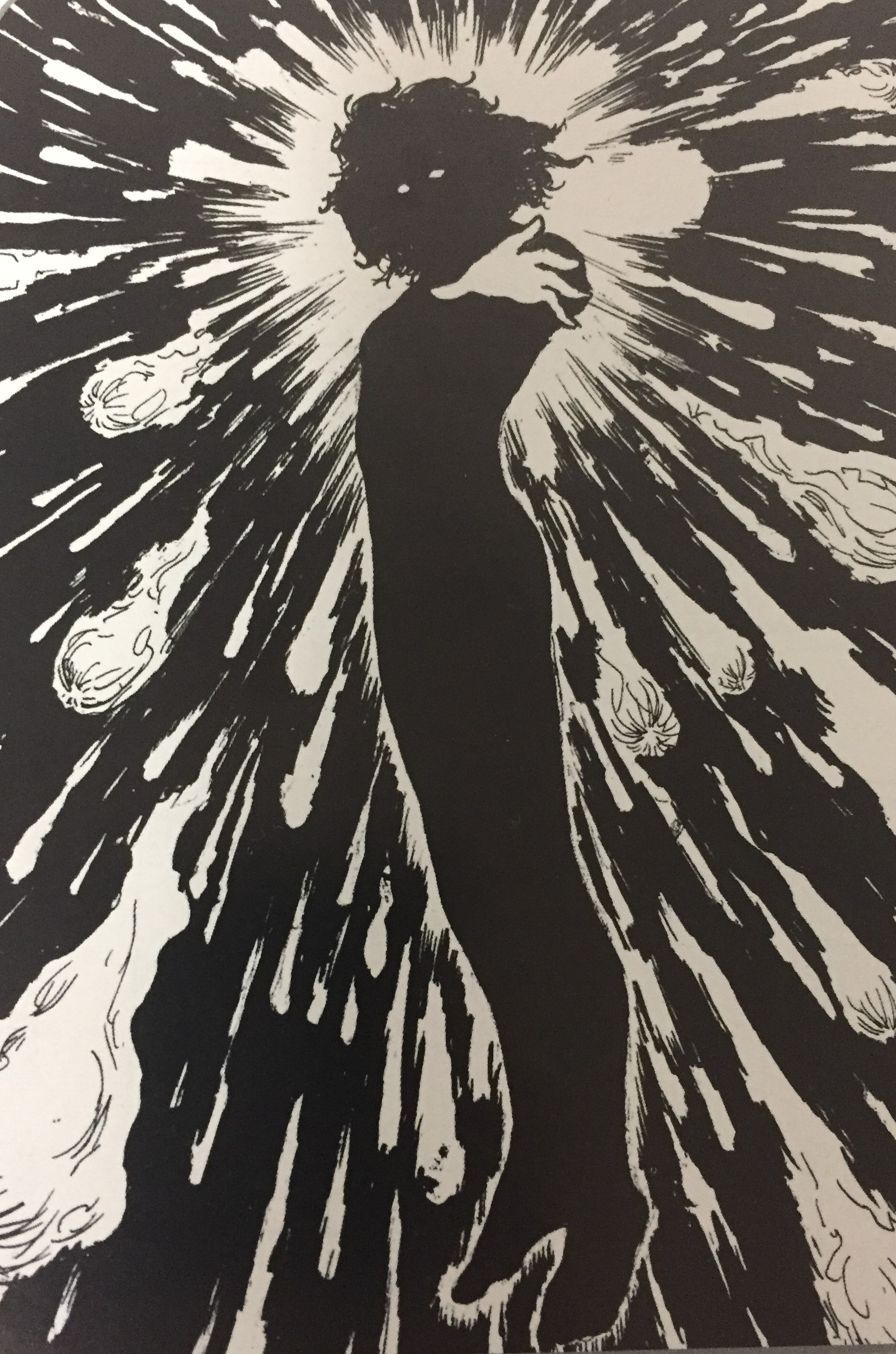
Pictured, literally Za Warudo
Art: Larry Chy
The First Dance, Eternal: Parthenogenesis
- Off the bat, Ahura Mazda is the one, true, creator God
- The game’s then “well, actually”’s itself by noting that that predating Ahura Mazda were evil snake men, a world that isn’t Eden, and unnamed sentient beings who petitioned the uncaring universe for help
- Ahura Mazda creates Eden for these unnamed beings to keep them safe and creates “souls” for them to live in which are immortal in Eden making the implication that Eden is itself a false reality and that Ahura Mazda can’t truly make life, only vessels for it to live in so he isn't a Creator God
- The game will never mention any of this after the next page and studiously ignores this massive question in its cosmology down to never once again mentioning the pure-evil snake men older than God*
- We jump ahead 195 million years to where Lucifer, an elected emperor in the Star Wars tradition, gets mad at Ahura Mazda for not doing enough to protect his people, “The Antecedent Empire” from disasters
- Lucifer decides that if Ahura Mazda won’t protect his people he’ll just clone god
- TLE states, and I quote, “[...]Re-create the genetic code of God. Thus began the GODHEAD project. “If this God won’t save us”, Lucifer reasoned, “we’ll have to create one who will””
- There is no explanation for how that works or what that means for the setting. Those questions are boxed up and packed away next to the snake men
- GODHEAD is always in all caps. It doesn’t stand for anything and the GODHEAD has 12 other names that get used interchangeably for it with no explanation**. It shouldn’t even begin to surprise you at this point one of those names is “Demiurge”
- GODHEAD blows up the Antecedent Empire when it’s finished growing(?) for reasons you never get to find out because the narrator of this story says almost literally :you’ll never know why or what happened”
- The Antecedent Empire, by the way, gets re-inhabited nearly immediately and Ahura Mazda rules from here for the rest of recorded time so blowing it up accomplishes nothing in the story except an excuse to write “18 million souls died instantly” in a comic book escalating body count kind of way
- Ahura Mazda sends GODHEAD to hell for this, but not uh the game’s setting of “Hell” because that’s in Eden but instead the hell referenced here is our Earth dimension
- Ahura Mazda also sends down to hell any “soul” that asked him to do something about the whole GODHEAD issue, for the crime of not trusting him enough. Great guy that Ahura Mazda
- Amaterasu, Nut, Na’Pui, and Proteus are called out as souls cursed to earth by Ahura Mazda.
- The GODHEAD, now in Earth, has a mental breakdown because it can create physical bodies to prevent the souls sent to Earth with it from dying, but can’t make the immortal souls Ahura Mazda can and Ahura Mazda won’t tell it how to do it.
- There is no indication of what happens to a soul when you die as a human, the only thing the game confirms is you don’t go to Eden just because you died. The game will never ruminate on what this means for its setting
- For those keeping record, humans in this setting exist not one but two layers deep into a fake reality, because the “good” god cursed immortal souls to go down from the second to third layer where they can die forever, as will all their descendents, all because they had the temerity to ask for his help
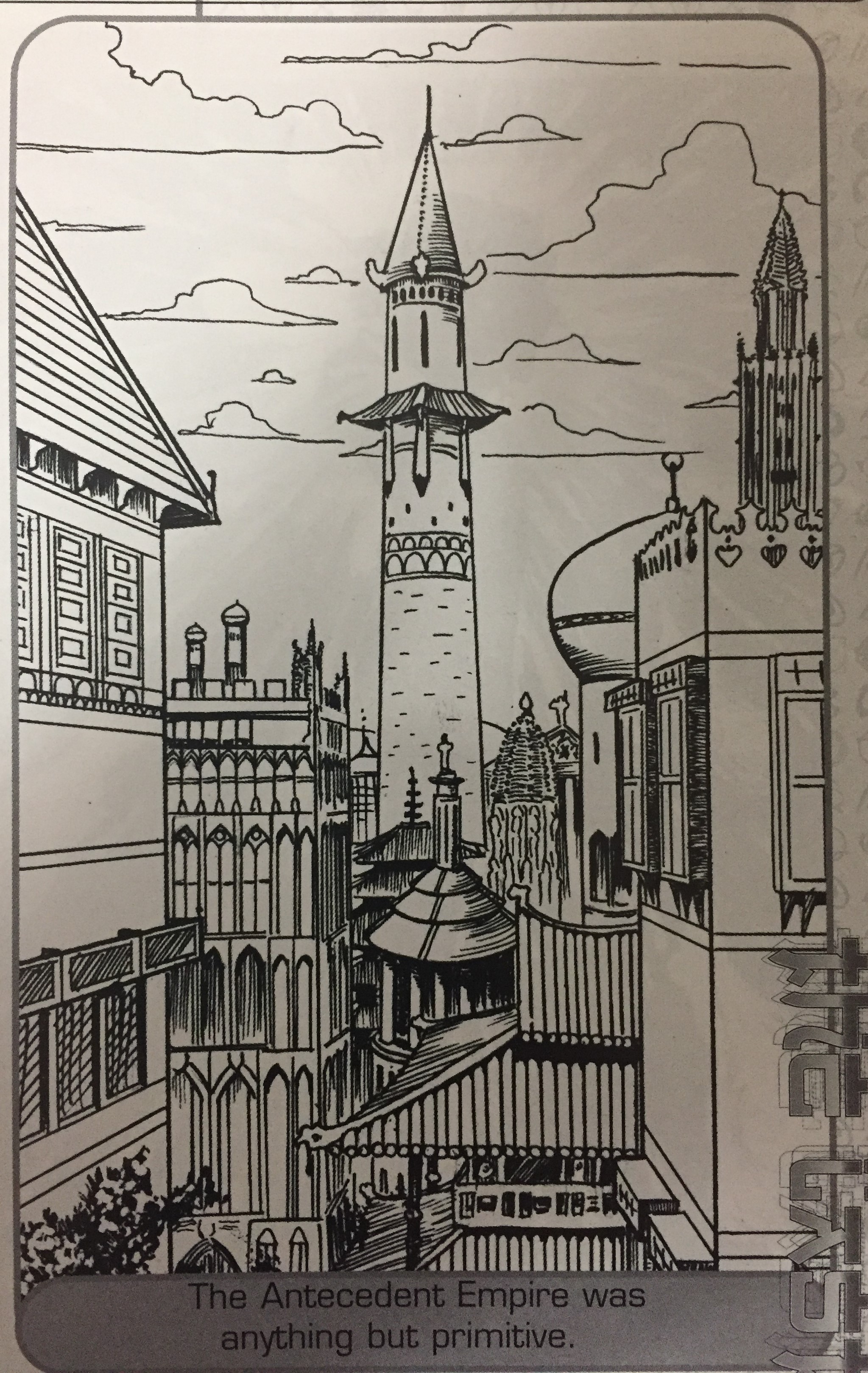
If they were so smart, why do they have so many obstructed view apartments?
Art: Larry Chy
The Second and Penultimate Dance: Testament
- In an extremely confusing section we learn that GODHEAD can have humans perform a ritual to rip the soul out of a body to leave behind only the shell, except GODHEAD is the inventor of human bodies which were empty shells he stuffed souls into so why does he even need this process?
- More confusing, the game says GODHEAD begins experimenting with free will in its creations now which makes absolutely no sense, as Free Will has never been implied to not exist to this point and GODHEAD explicitly can't make the souls that inhabit human bodies
- The game really, really likes splitting the Jewish biblical God’s role in stories between Ahura Mazda and GODHEAD. Here, it makes the plagues hitting Egypt alternate between the two deities as a show of power, even though the book just spent several paragraphs explaining how Egypt was fully under the control of GODHEAD and their entire religion was made up by GODHEAD
- Moses parting the Red Sea is smugly credited in TLE as being first miracle in the Bible. I’m sorry, TLE but you don’t get to be smug when you fuck up basic things like this
- The game compares the Jews wandering in the desert for 40 years directly to the holocaust and says Ahura Mazda did it to “Breed out their slave mentality”. Jews also explicitly give up on reaching heaven after GODHEAD kills Moses they instead settle for conquering all the lands around them. I’m not touching any of this shit with a 10 foot pole and the game flat out never discusses any of this again
- After the great ganking of Moses, Ahura Mazda takes a new track and has a baby with a lady to make Jesus Christ as the perfect messiah to lead humans back to Eden
- Scratch that perfect messiah bit, Jesus Christ gets given a bunch of pointless character assassination flaws like bipolar disorder
- Jesus, being part man which means he is inherently tainted by GODHEAD which you think Ahura Mazda would have thought through, didn’t destroy human sin but rather absorbed human sins into himself, and this process created an evil, I guess beardless, Jesus doppleganger called the Anti-Christ
- The Anti-Christ also arrived in Eden when Jesus died and tried to conquer it. He is an immortal unkillable jerk who keeps trying to conquer Eden and reincarnates on Earth a bunch, but is most notable as he can travel between Earth and Eden and lead GODHEAD armies between each so he sets up countries under control of GODHEAD in Eden called Hells
- To fix this mess, Ahura Mazda tasks the Angel Gabriel to incarnate as Muhammed***
- TLE dives into an abridged, sanitized, relatively accurate life of the prophet for two pages referring to him as Muhammed*** the entire time and then at the start of the seventh paragraph and for the rest of the time he’s a character refers to him as Jibril. TLE, I know that means Gabriel and I was still lost for several minutes
- Muhammed*** lead some humans back to Eden, and the game says he’s the first human to travel to Eden in thousands of years even though it explicitly said, to the point of only referring to him as Jibril, that he is the Angel Gabriel.
- Jibril then further proves he isn’t a human in contradiction to the text when he reincarnates multiple times to one on one fight the Anti-Christ
- You know how White Wolf, and most of its clones, have the good sense to not really touch who was behind the Nazis? TLE has no such qualms and the GODHEAD is not only specifically behind the Nazis, they are the perfect manifestation for its goals for Earth to the point where it renames all of its various territories it has conquered in Eden “The Eternal Reich”
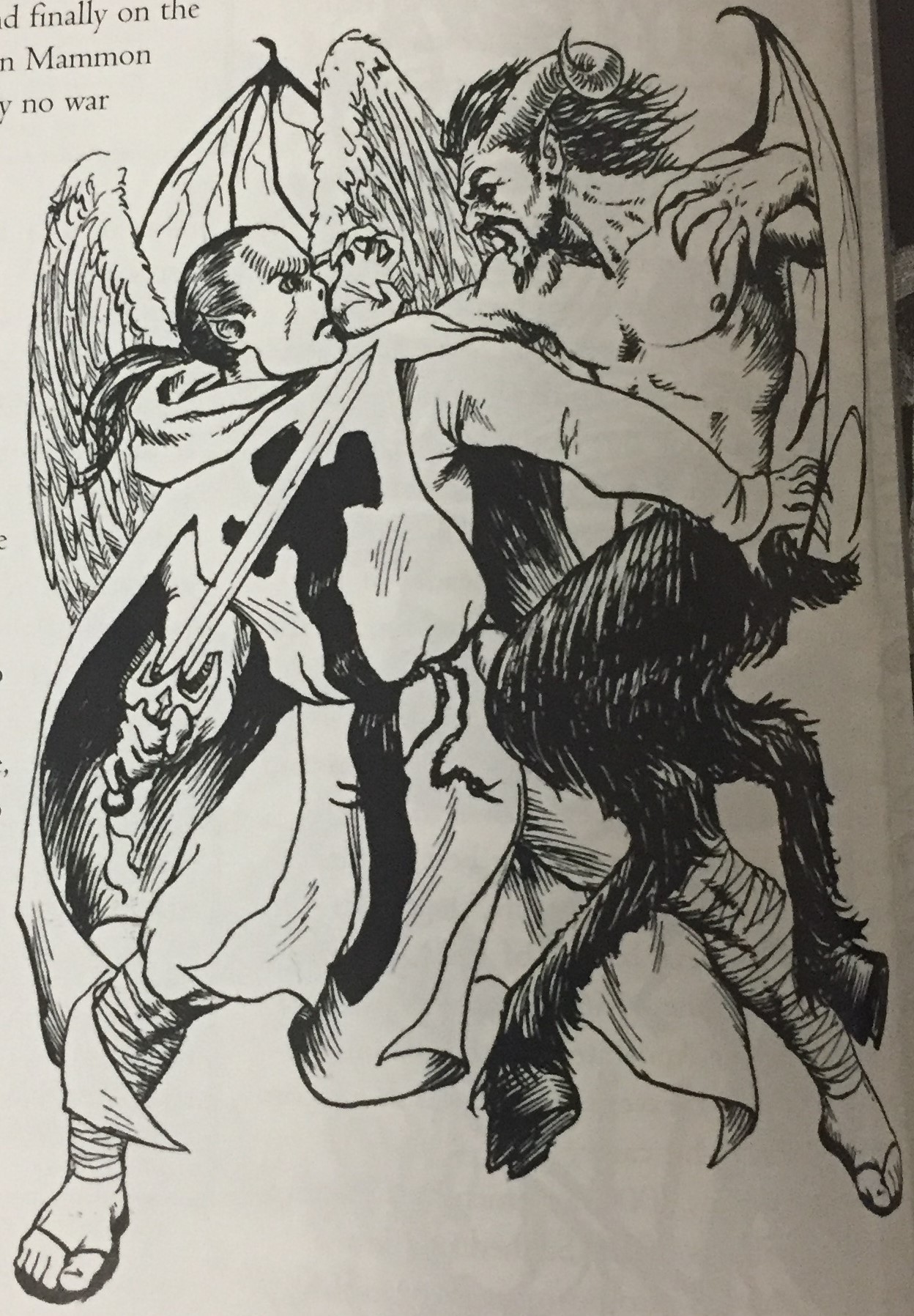
I’m not sure why this art is in this section at all. By the way, the second song was off the soundtrack for Blade
Art: Larry Chy
The Third and Last Dance: Prelude to an Exodus
- Why isn’t this section called “The Last Exodus”?
- So Ahura Mazda and the GODHEAD are having tons of children at this point, despite earlier it being mentioned that Ahura Mazda made a vow to never, ever do that again after the whole Jesus Christ evil-version fiasco
- No explanation for why Ahura Mazda has to have so many kids. Apparently, they can’t just birth the one it wants with the right qualities despite having done that earlier.
- We now get a fairly in-depth recap of the Bosnian War. And I mean in-depth; despite an entire side in the conflict being honest-to-goodness Ultra-Nazis, WWII gets maybe six lines total describing it where the Bosnian War gets about three pages
- The section on Muslims here and their defense groups and the Mujahedin and callouts on the West’s “terrorist” label being applied only to their enemies would have gotten a serious reworking if this game had released a month or so later, so it’s an interesting time capsule. Not worth actually reading, though.
- Mirjana Filipovic is the name of the woman from the back of the book who is Ahura Mazda’s perfect messiah to lead all humans back to Eden in the “Last Exodus”. She is not, as the back of the book claims, the second coming of christ. Back of the book, you had one job!
- Content Warning She is brutally raped and murdered in this section and ultimately so irrelevant to the game that she doesn’t even have an index or glossary entry
- Everything below this bullet are things actually relevant to the game players will play
- 12 people got super-magic mega powers in Times Square at New Years, 2000CE. They are referred to them as Apostles, and 6 of them are evil and 6 of them are good and 0 of them are playable characters.
- The Apostles control the world's 12 religions, one per religion, most of which don’t meet the qualifications to be a religion unless you believe that the Crips are an religion.
- The Apostles do metaplot stuff for metaplot reasons which are vaguely alluded to but never explained in the next section. In this section, literally all the 6 good ones manage to accomplish is a group meeting to decide on what their names will be
- The 6 evil Apostles are a bit more proactive, and take command of the Eternal Reich and declare open war on heaven by blitzkrieg bombing 3 million people to death in one of the provinces of Eden.
- Final reminder: this game is supposed to be White Wolf style hidden-in-plain-sight game of subtle influence and intrigue from the shadows
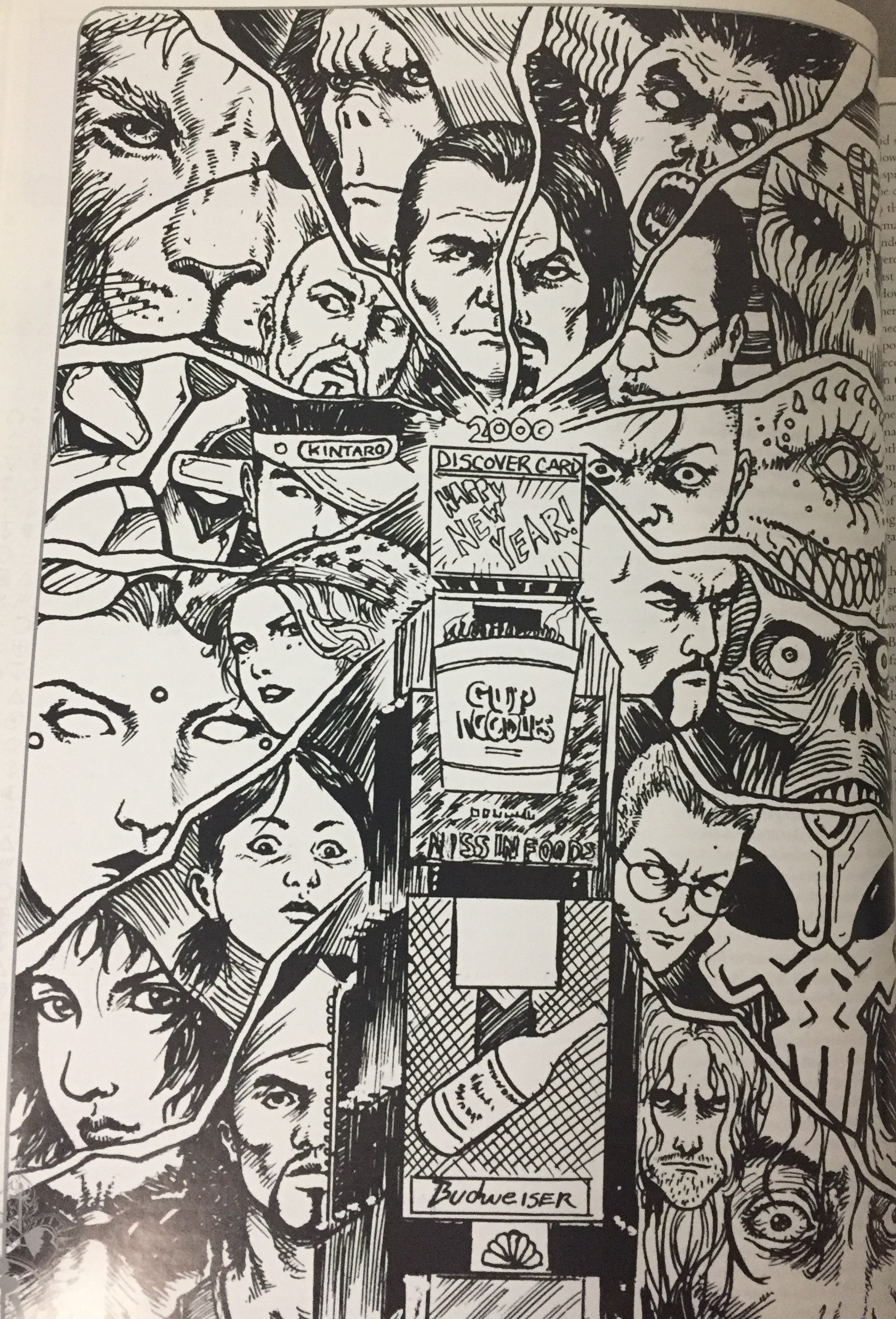
Pictured the 12 Apostles and their [insert anime power up form reference]
Art: Larry Chy
Now that we’ve finished the Metaplot you may be wondering “Why do I have to side with either Ahura Mazda or the GODHEAD? They both seem like manipulative, destructive, cruel idiots”. Well my friends, the answer is TLETISAOTTALD.
Next Time: These Characters Will Judge You
*The index confirms these three pages are the only pages these beings older than God and an enemy of all creation are mentioned
**GODHEAD could stand for a lot of things, really. I’ll round up any suggestions and include them next update
***ʿalayhi as-salâm/PBUH
These Characters Will Judge You
Original SA post
Last Exodus the Interactive Story Arc of the Third and Last Dance is a roleplaying game from Synister Creative Systems published in 2001 and designed Sean and Joshua Jaffe. It’s a metaplot heavy, playing card deck using, religious themed urban grunge game. Unless I am otherwise notified it appears to be completely out of print with no digital versions available. Should this be incorrect I will update to include where it can be bought to give the original developers income.
Part 5: These Characters Will Judge You
We now get to my absolute least favorite section of the book. It turns out I can churn through metaplot, read through asinine rules, and min-max how ugly my soul is to get minor bonuses to using both hands in combat but I can barely make it through a single one of these insufferable Apostle Interviews. I shouldn’t be burning out a scant 32 pages into a 196 page book but here we are, in a world bereft of dinosaurs.
This section of the book is twelve nearly un-interrupted interviews with all twelve of the Apostles even though it makes no sense they’d let someone interview them like this given that God wants them dead. The interviews use nearly the exact same questions for each one to the point of being narratively jarring in some cases and, as you’d expect, the authors of this book aren’t really good enough to provide twelve distinct voices. If you think, “Well Barudak, after that worthless metaplot, I’ll just skip this section” the introduction to this section ends with:
”These twelve men and women aren’t going to finish the Last Exodus, but they did start it. They are you leaders and advisors, your protectors and your guides. They have set the stage for you to complete the Last Exodus, and they’ll be watching you from here on in.”
The good six are called the Apostate and the bad six are called the Sanhedrin. The game provides art of what they look look like as well as what their soul’s true form looks like (the game calls that your Deiform). Note, I’m using “good” and “bad” here because while the game layout treats them that way the actual writing tends to undermine that. The questions the interviewer asks are basically what is your name what religion do you lead, what do you think of your enemy, what is your end goal, and for no reason other than to show off the Jaffe brothers’ musical knowledge what their favorite music is?
Since theres so much jawwing with these mostly dull as dishwater characters, let’s do like we did with the metaplot and just focus on highlights, starting with a general summary:
12 Apostles
- 9 male 3 Female
- 4 Non-white Caucasian (one hispanic, one east asian, two AA)
- 7 are born in the US, but only 3 aren’t U.S. Citizens
- 10 are heterosexual, 1 is bisexual, and 1 is a nine year old child so I will punch you if you ask
- 12 live in New York City now
- 2:1 dead to living wife ratio

Yes, brother, Les Lionceau Terribles
Apostate
- Jedediah Bronson - White South African Mercenary who undoubtedly lived through apartheid and loves killing. Owns a PMC, and the game mentions he has committed at least one atrocity personally, so congrats Apostates on getting this guy on your side. Deiform is a screaming buff lion man with no shirt and a gun. Owner of dead wife #1
- Emily Vasquez - 9 year old child wise beyond her years with AIDS, you get the sob story drill here. Deiform is an adult woman who only has a skeleton for the chest, but flesh everywhere else. In game mechanics, she probably shouldn’t be able to have AIDS much less die of it as the healing rules note that traveling to Eden cures you of all disease, infections, and regrows organs. She a charming revenge story where she mind controls a man and forces him to cut off pieces of himself and feed it to shelter dogs until he passes out from bloodloss, whereupon she keeps cutting him up until nothing is left. Haha, so precocious
- Srdjan Dragomir - Your prerequisite priest who lost his faith but is now finding it again. Owner of dead wife #2. Deiform is a generic angel of death. This guy has nothing interesting about him so let’s just end this here.
- Tomohiko “Dexter” Tenchikashi - Japanese rave DJ hacker whose Deiform is a Gundam with subwoofers and turntables. I believe I have a bingo
- Tane “Maintane” Jackson - Urban black guy whose religion is his street gang. Has been to prison, loves rap battles, and has a girlfriend he refers to as his baby momma. I swear to god his Deiform is best described as “What if Blade was played by Rick James?”
- Ursula Tango - She is your passionate artist bohemian. Her musical taste that is supposed to be eclectic comes across more as “top 40 from the 80s and 90s”. The game refers to her as hispanic later, but the character box and her bio says Caucasian. Despite her supposed free nature, unconventionality, artistic nature and bisexuality, her deiform is a sexualized white woman clad fully in fishnet stockings and high heels with an expensive electric guitar

G-Gundam would have rejected this design. G-Gundam!
The Sanhedrin
- Madison Vaughn - Is basically a trust fund baby family fuck-up turned leader of the Hells. He is like a cooler, hipper, slightly more eloquent George W. Bush. His Deiform is a boring generic demon, just like his musical taste which is Thrill Kill Kult, KMFDM and Ministry.
- Evan Rutherford Powell - This is TLE’s crazed uncontrollable ultra-edgy spree killer all the other Apostles are afraid to interact with whose terrifying deiform is the same thing he is normally; a 30 year old white dude rocking the grunge look with sandals. If you haven’t figured out by the third paragraph his gimmick, he states his hobbies as “rape” and “murder”. There is absolutely no good reason any of the other Sanhedrin would ever hang out with him but they do because [error: reason not found]
- Franklin Talbot - Does not belong in the Sanhedrin. Like, flat out, the dude is by far the coolest of all the apostles from the fact that his “revenge” story he tells is using his massive wealth to financially ruin racists and buy back and destroy the icons of his degradation at their hands to the fact that his Deiform is undead Sun Ra in a business suit. His interview admits that that while he has the wealth to do unspeakable evil he’s not interested in that at all and funds the arts and sciences instead. The guy even reaches out to the Apostles for business partnerships on the regular because he is a successful businessman first, death of Ahura Mazda distant second
- Virginia-Mae Buchanan - Remember how cool Franklin Talbot was? That seems so long ago already. Virginia-Mae is the leader of the ultra KKK and her Deiform is a dragon because, *sigh*, get it? She's probably the most mysterious of the Apostles, not because of her goals, motives, techniques, or backstory but because she wastes nearly the entire interview getting madder and madder that the interviewer won’t say that he’s Jewish. Im also not sure how racism works when everyone involved knows tour body is a ashell and we all have equivalent souls that can be any shape color or design we can imagine. Further, remember how there is no reason any other Sanhedrin would ever would hang out with Evan? Franklin Talbot is black
- Dr. Alistaire Stone - Look at that spelling, this guy is obviously from the UK. He’s our mad-scientist trope, and so of course his Deiform is a four armed ninja cyborg straight from a RIFTS fever dream. Huh, that doesn’t seem right. Anyway, he has a clone of the Apostate hero Dexter from earlier saved to his hard drive that he makes do his evil empires tech support which is frankly hilarious and I love it
- Captain Maxemillian Stayne - ACAB and to drive it home, his Deiform is a gooey, blood Nazi with a trident. It’s at this moment the writing decides to fuck up everything because despite the fact his soul is a blood nazi, he’s actually a decent guy and probably second to Franklin on the good scale. He comes across as painfully earnest and square rather than evil: his goals are to protect the freedom of Americans to live their lives and he wants to uniformly enforce their rights and protect them from a list of threats that includes most of the other Sanhedrin along with the Apostates so like Franklin, why is this guy here. He’s so by the book his religion’s special gift doesn’t even work if you treat someone unfairly for crying out loud. In closing; he would like you to know his wife is alive, and he loves her very much, thank you
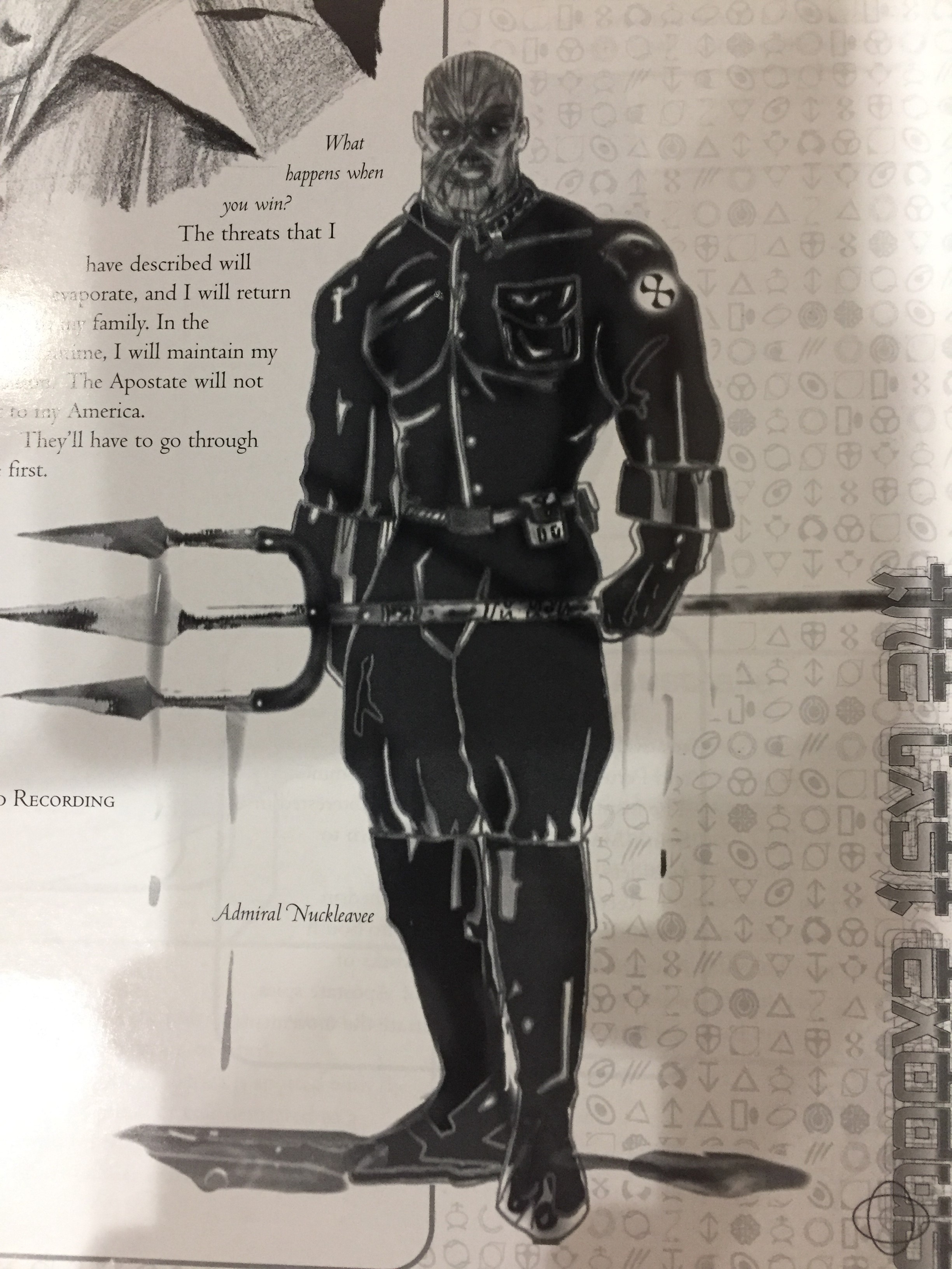
Stayne believes in good copy / gooey cop
And with Stayne finished, the section just ends. There are two more pages in this part of the book, but they’re about world geography and the very next section with a splash page break and a separate chapter number is world geography so I’m not sure they’re actually supposed to be here. The good news is the next section is the last before we begin discussing actual game mechanics. The bad news is the next section is a bunch of fantastical places that aren’t interesting at all unless you find it fun to ponder the question, “What does Satan need with a strip club?”
Next Time: Honestly, Here Could be Dragons
Honestly, Here Could be Dragons
Original SA post
Last Exodus the Interactive Story Arc of the Third and Last Dance is a roleplaying game from Synister Creative Systems published in 2001 and designed Sean and Joshua Jaffe. It’s a metaplot heavy, playing card deck using, religious themed urban grunge game. Unless I am otherwise notified it appears to be completely out of print with no digital versions available. Should this be incorrect I will update to include where it can be bought to give the original developers income.
Part 5: Honestly, Here Could be Dragons
Welcome to the “World” section of the book. It gives us details about the various realms of Eden, their associated Millenium Religions, where on Earth they overlap with for travel purposes, and what their economies are based on. Why they need a functioning market economy with export goods is never really explained, especially in light of it turning out that they have literal limitless clean energy.
There is no discussion of the state of Earth in this section despite being called “World” and Eden soon explained to explicitly not be a world, so TLETISAOTTALD. There are two pages at the end of the previous section that have a whole thirteen* paragraphs describing the status of the entire Earth. Don’t worry though, since the “Upcming Products” don’t actually contain a single book describing Earth in any more detail so whatever you make up off the cuff is just as valid as what the game developers intended. Overall, there’s really nothing interesting about this world map other than a) North America is the most spiritually active place on the globe b) Australia is home base to the Nazis and c) they waste one of the thirteen paragraphs describing Earth on a single sentence saying there is nothing in Antarctica.
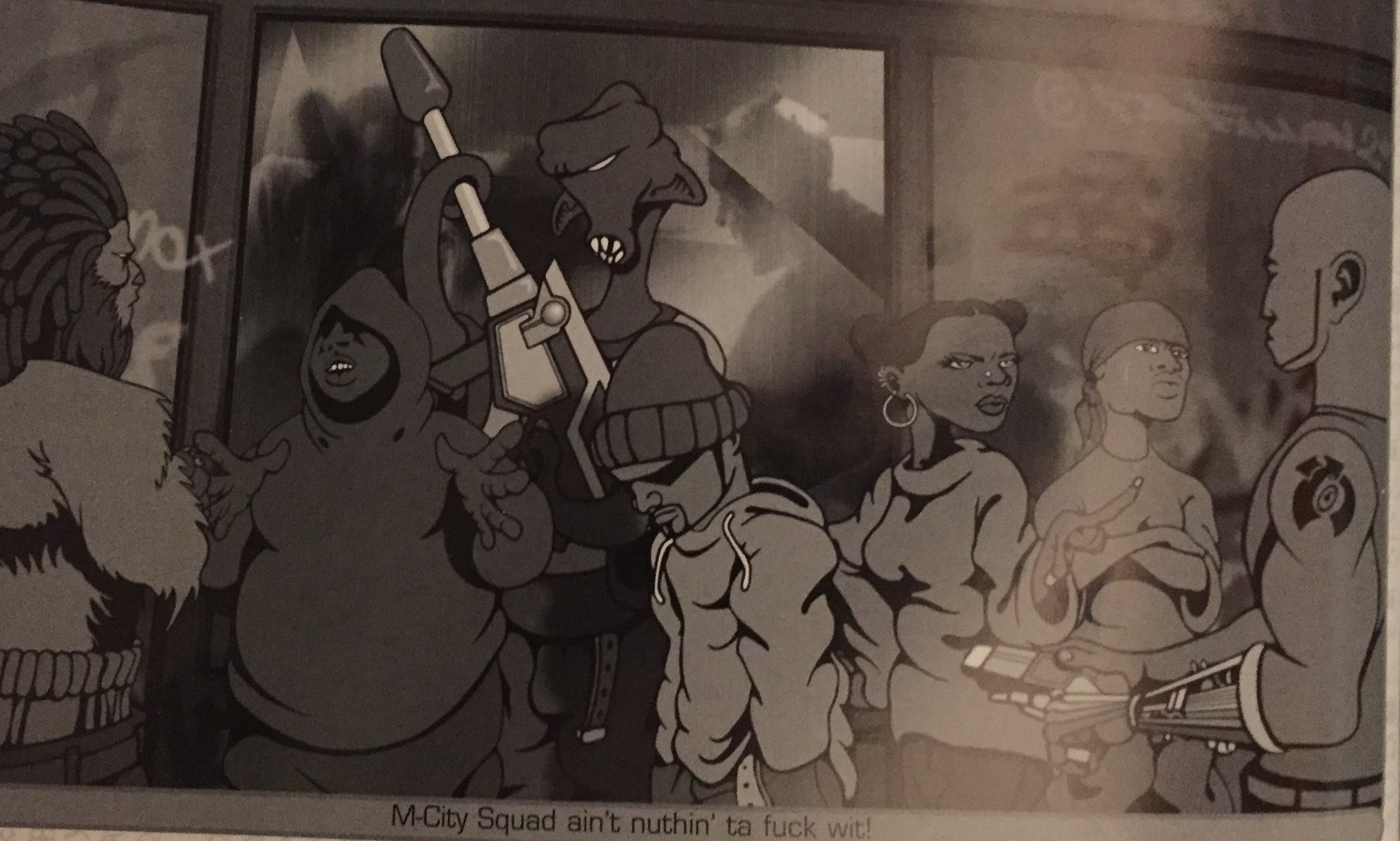
I’m sorry there’s no joke here because seriously just read that caption
Art by: Frank B. Fallon
Now in the “World” section proper, we finally, 52 pages into this book, get told the most important thing the game has to convey to us, and I quote,
Only then did I look down at my body. “These are not my boobs.” I said.
After that masterclass in writing we learn that a Messiah (or Scion, the book keeps changing the word at random) is special because they can shift freely between Eden and Earth. We then immediately learn this isn’t true and they need a ritual to do it, described later in the character creation process with each Millenium Religion having its own unique process. Also, the game will then try to declare its metaphysics and have it be like a jar of different grades of sand mixed in a jar, all matter overlapping and comingles between Eden and Earth, but the actual rules of the game really, really strongly disagree with this notion.

You’re looking awfully smug for someone wrong about both how Eden and Earth overlaps and their own boobs
Art by: Ross Rosenberg
The next thing we get is an overview of just how Earth is crappier than Eden. It turns out that crimes still occur on Eden they’re just more rare, and in something that game hilariously calls positive, Eden is so rife with advertising in its major hubs that every hub appears like a tokyo/hong kong night market. That’s the game’s own description, so way to go Ahura Mazda, doing a real bang-up job. Instead, what makes Earth so much crappier than Eden is that GODHEAD actively tries to piss off all humans on Earth with little annoyances like making lines to checkout groceries really long or making you lose your glasses and keys in the hopes that things like this will cause humans to snap and kill each other, or in the games owns words “fuck a child”. I don’t think you could write a more revealing example of unexamined privilege if you tried.
Lastly, we get introduced to a concept that in seven paragraphs blows up chunks of the game’s setting and character progression system. See between Eden and Earth, there is a raging storm called Limbo. The only way traditionally to travel from Earth to Eden is to die, no fancy messiah rituals here, and in the metaplot the only way to travel from Eden to Earth is to have Ahura Mazda incarnate you into a human body personally, something he does for only one character in the entire metaplot. Except, in true TLE fashion, it turns out that no, actually, if you jump off any point of Eden into the Limbo storm after about a day you wake up on Earth. Further stupefying anyone reading this, you actually retain all your memories, and in fact the game calls out the only thing you can’t remember is your time in the Limbo storm. Congratulations TLE, you’ve undermined one of the core setting rules of your game and the singular reason why PCs are special.
To make this dumber, there is an optional chart included in here to make the fall to Earth punishing but it doesn’t work. Using its list of punishments, realistically you only have about a 1/14 chance of something bad happening you can’t deal with alone while having a 1/27 chance of gaining a massive chunk of powerful magic that otherwise is painfully slow to build with XP and or off limits to you. Since killing yourself or being killed transits you back to Eden and neither Ahura Mazda nor GODHEAD care about team kills or suicides, and being in Eden heals you fully of any physical ailments you had, the best way to get powerful in TLE if you use this chart is to have players take turns continuously suiciding themselves on Earth and then jumping into an eternal roiling storm in Eden to get flung back to Earth where they kill themselves again.
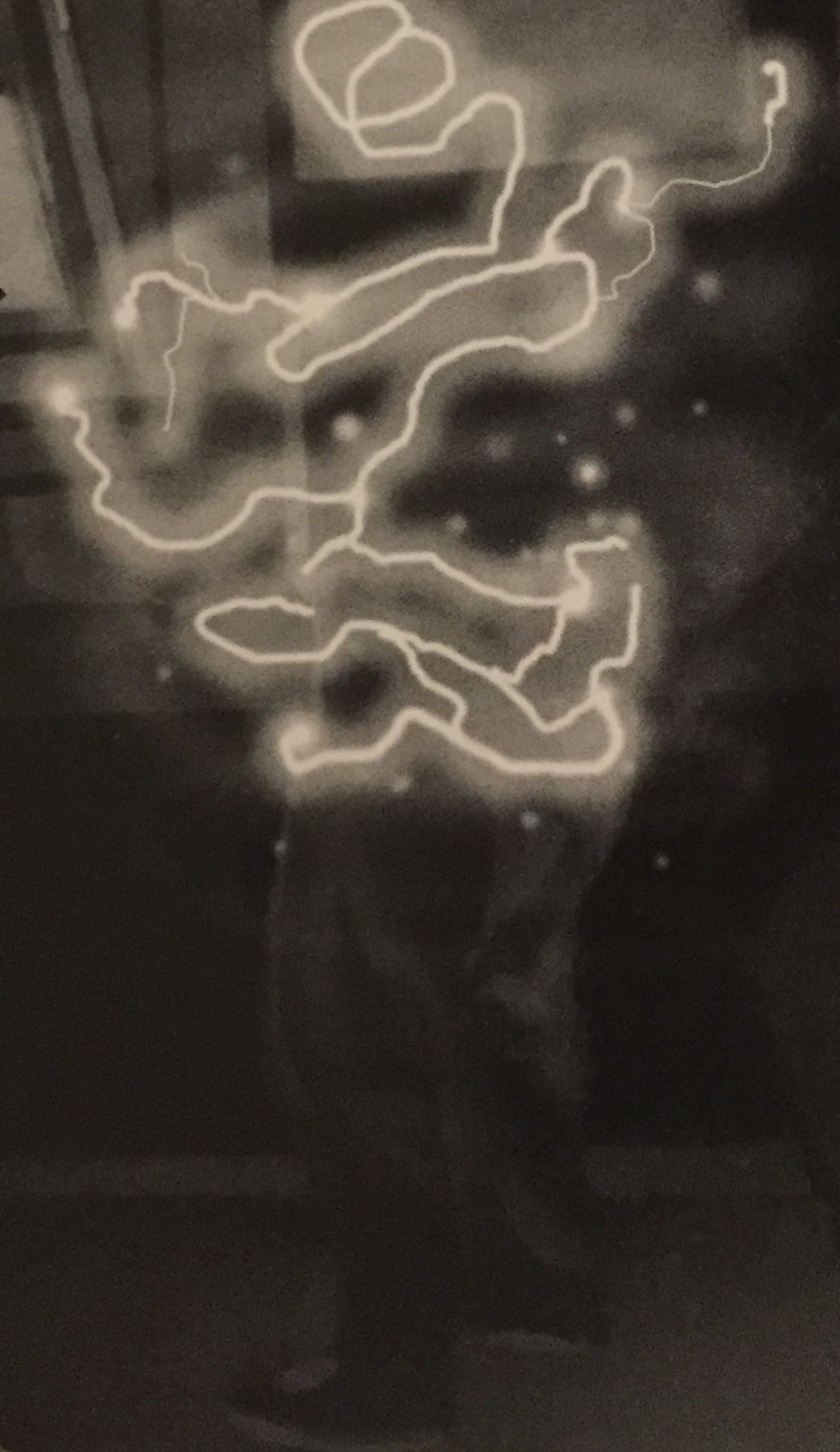
Pictured, power-leveling a pair of pants
Art by: Dennis Calero
After that uncomfortable bit of emergent gameplay, we get introduced even more to Eden. We’re now finally told after 54 pages told that it isn’t a single world, connected piece of terrain. Rather it’s a series of floating continent realms above the clouds of the Limbo storm, and none connect to each other. Not only do they not connect, they can’t be reached by flight or other powers even if you can see another realm of Eden, because geography and reality are strange here with colors changing at will, multiple suns appearing, and other oddities. Except of course, this incomprehensible dreamscape follows a rigid 24 hour day night cycle and has a currency and banking system, and recently thanks to Dexter the Apostle’s religion, internet connection between the realms (internet is Ahura Mazda Eden exclusive).
Hells**, its then explained, are realms of Eden that the GODHEAD has tainted. These tainted islands fall down into the clouds to encounter a severe writing error. Either the game forgot that Hell singular means Earth not these pieces of Eden or somehow parts of Eden itself can fall and be forced to manifest in our world but be completely undetectable and never again referenced by the game so pick your favorite option. Further, it’s not clear if GODHEAD’s “annoy all humans with minor inconveniences to have them kill each other” plan also operates here which you would think would be an important thing to mention because otherwise going to Hells might be an improvement in some people’s lives.
With that, let’s for no sensible reason talk about money in this game because the game does so now. In Eden, money is a natural energized byproduct of your soul and you get one soul-dollar every day meaning there is undiscussed endless inflationary cycle of 100% every single day in Eden. This money can also be converted into power for anything in Eden, but it doesn’t seem to get used up; the example is one soul-dollar powering a massive project for eternity. It also used to be you carried your money in a halo around your head that radiated to the world how wealthy you are, but everyone now uses basically angelic credit cards. Now that you’ve mastered the fundamentals of the games money-system, I feel like it’s a good time to reveal to you there is only one thing in the entire game with a given price, and it is done in $USD. TLETISAOTTALD.
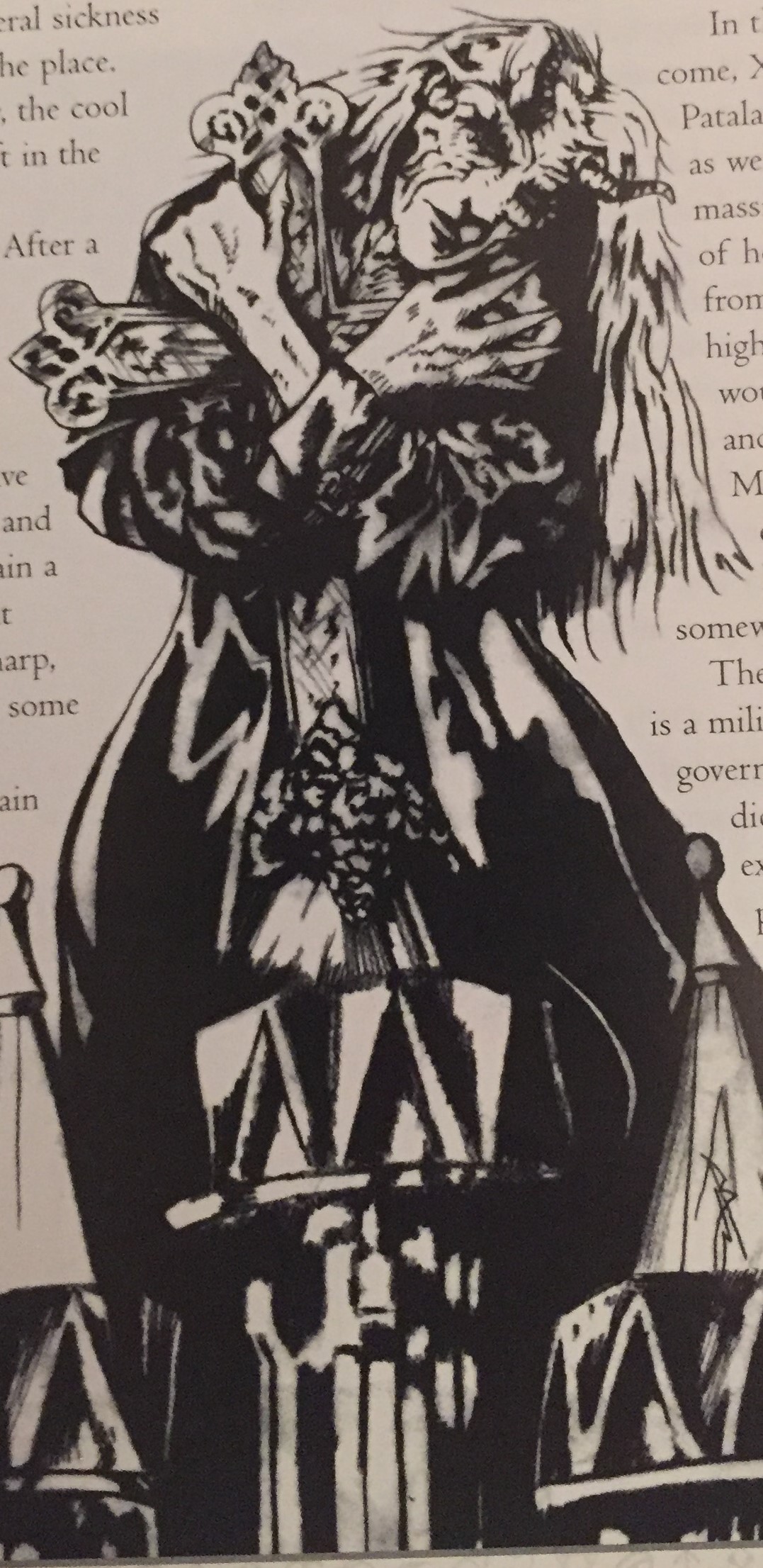
I hope your masquerade’s got some money to pay for that if you break it
Art by: Joel B. Telacko
The game’s rules go in order of Ahura Mazda parts of Eden then the GODHEAD parts of Eden. Each realm is given a name, where on Earth it overlaps with, when it was made if its a Hell, geography, culture, trade, and predominant religious sects. The places it overlaps with Earth will be very useless almost immediately because the author’s don’t know how to explain things with well defined borders so lots and lots of territories overlap. The religious sects is even less helpful because it never references real religions nor does it usually reference the Millenium Religions that are in the game. No, these are all new appearing for one sentence religions like Anshardim***
We’re not going to follow the books order because the Realms of Eden are getting their own update because one of them undermines the premise of the game so fully that the rule book should be considered the 10 paragraphs dedicated to just that section. Since that part is so destructive to the game as, well, a game I’ll need some space to get appropriately mad at it.
Phew, let’s get back to when things made sense and we were reviewing Gnosticism 101 half-remembered by a C student. It’s time now, to talk about the various realms of Hells**. Interestingly, the Hells have a functioning non-cash, trust based economy just like Eden and have something Eden doesn’t have. Anywhere in any of the Hell realms you have full cellular phone service, a feature not present in Eden since at the time of this book’s publishing VOIP, like smartphones, didn’t really exist. Not only is there phone service in the Hells, that service actually works in Eden, but can’t call any other Eden realm, just the Hells, because I Ahura Mazda refused to allow that cross Eden relay tower to be built. See, it turns out Franklin Talbot is so goddamn good at being a businessman he got Eden and the Hells on a single voice communication protocol and operates and introduced fully functioning trust-based cash-less economics to the Hells despite having been able to visit them for about one year.
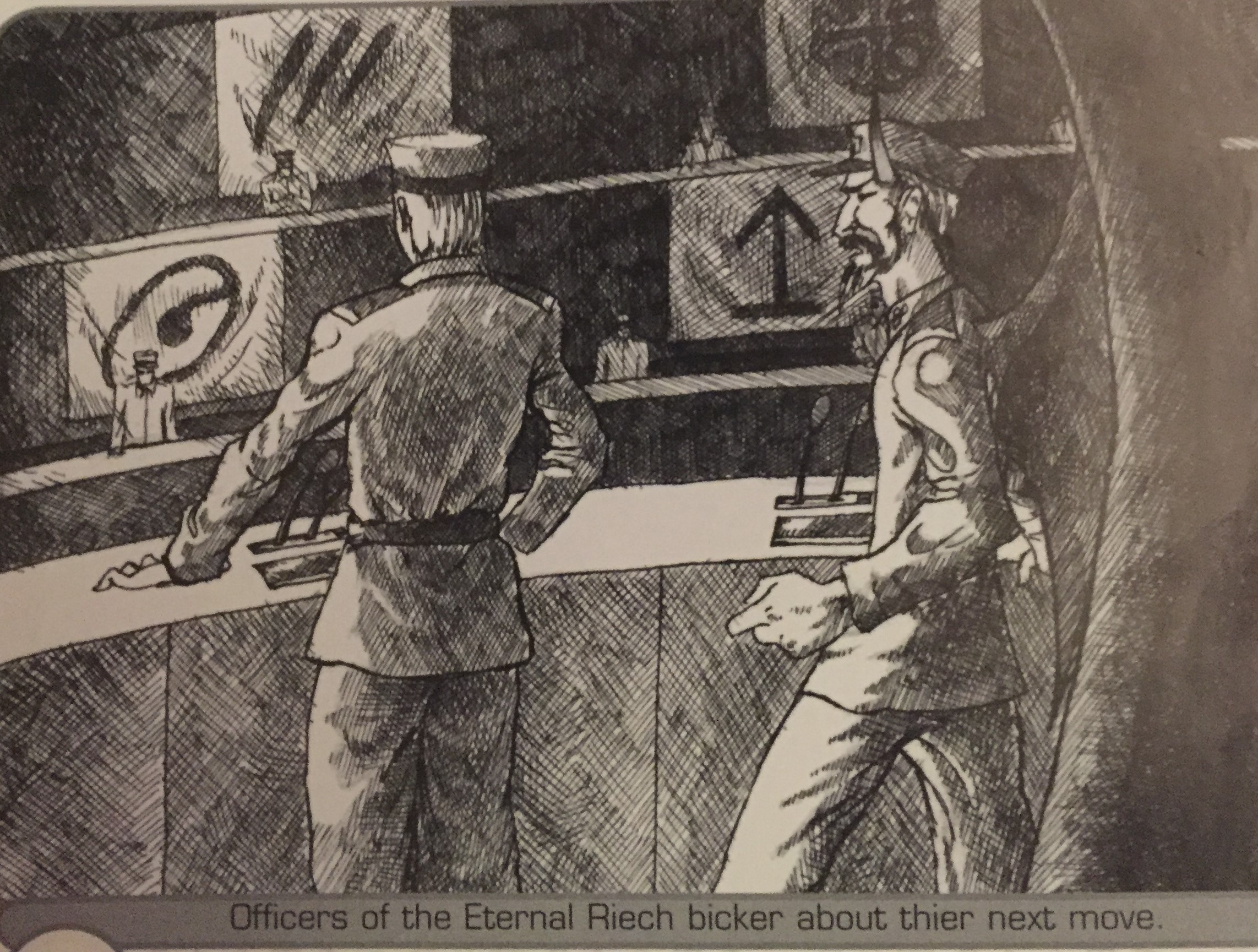
I hope your next move isn’t knocking all my shit off my desk with your wings again, Kenneth
Art by: Edward F. Jewell
Realms of Hell (not Earth, the Other Kind)
- Abbadon - Overlaps with Eastern Europe, Yugoslavia through Macedonia. It was made during the crusades but didn’t become a powerful hell until it got a huge boost during the Bosnian War. The game describes it as what most people think of hell looking like so it’s the second most phoned in realm of the Hells.
- Gehenna - It’s a realm stretching from Poland to Austria, so I double dog dare you to guess what this one is based on and how non-tastefully this is handled. Sampler: “Occasionally some enterprising clerical worker gets the idea of making something out of the skin, hair, or bones of the Souls”
- Kailichi - Amritsar to Cambodia, with a detour in Thailand, this realm was made by the Khmer Rouge. It’ll be a running theme in this section that almost all the Hells are from 20th Century conflicts which is almost disappointing when you have all of history to look for atrocities. This realm specializes in, no joke, being very dirty and spreading disease. You’ll start noticing a very unpleasant undercurrent especially when we get to the Ahura Mazda Eden realms
- Pandemonium - It’s the Congo to Somalia, so its huge and it also reveals the authors didn’t bother to look up a single African religion to get a concept of Hell to name this after. This realm has GODHEADS biggest mining operation in the ever shifting land of madness and senselessness. Do want to mention they have an actually funny cult in here, The Weakest Children of Silence, monks dedicated to the pursuit of complete uselessness who the game notes “Its unclear how successful they are”.
- Tartarus - Russia, they dance around it, but it’s Russia. Created by Stalin, this realm is mostly about ratting out other souls for perceived to have betrayed the GODHEAD to the point where the game states trust can not exist in this realm as though it had rules for trust. Also, WHY IS THIS A GREEK WORD
- Ultima Thule - Arctic circle, and wait holy shit, is this an actual plot hook??? Remember those Snake Men? They actually show up here and the game’s index didn’t realize it. Turns out nobody has any record of any great calamity here so why it’s a Hell** is unknown. The book then posits that if the Snake Men were to return, this is probably where they would show up so Eden and GODHEAD are taking interest in monitoring this area more closely
- Xibalba - Look, TLE, I’m glad you finally used a culturally relevant word for a realm created by Cortez killing the natives, but maybe it should include parts of Mexico? How about even just Mexico City? I’m just spitballing.
Next Time: What Does God Need With a Compiler?
*I counted. I count all these paragraph numbers I quote in this review because I want you to understand I am not exaggerating at all
**Hell is Earth except when it is plural and refers to these places, also called fallen realms also called GODHEADS provinces in Eden also called Hells. Sometimes though Hell singular is these places. GMS’s fantastic editing strikes again.
***I believe they venerate actress Ann Sheridan
What Does God Need with a Compiler?
Original SA post
Last Exodus the Interactive Story Arc of the Third and Last Dance is a roleplaying game from Synister Creative Systems published in 2001 and designed Sean and Joshua Jaffe. It’s a metaplot heavy, playing card deck using, religious themed urban grunge game. Unless I am otherwise notified it appears to be completely out of print with no digital versions available. Should this be incorrect I will update to include where it can be bought to give the original developers income.
Part 7: What Does God Need with a Compiler?
Let us know venture into the realms of Eden controlled by Ahura Mazda, otherwise known as the promised lands. Here, we’re hit directly with the authors’ complete inability to understand theme naming; while the Realms of Hell are all named after different cultural words for a Hell or a near equivalent, Edenic realms are a mishmash, mostly named after kingdoms in fantasy stories but not even necessarily particularly utopic ones. And when I say mishmash, one of them was a continent formation that shouldn’t exist in this game’s timeline and one of them is just straight up a city you can visit right now on Earth and 500,000+ people call home.
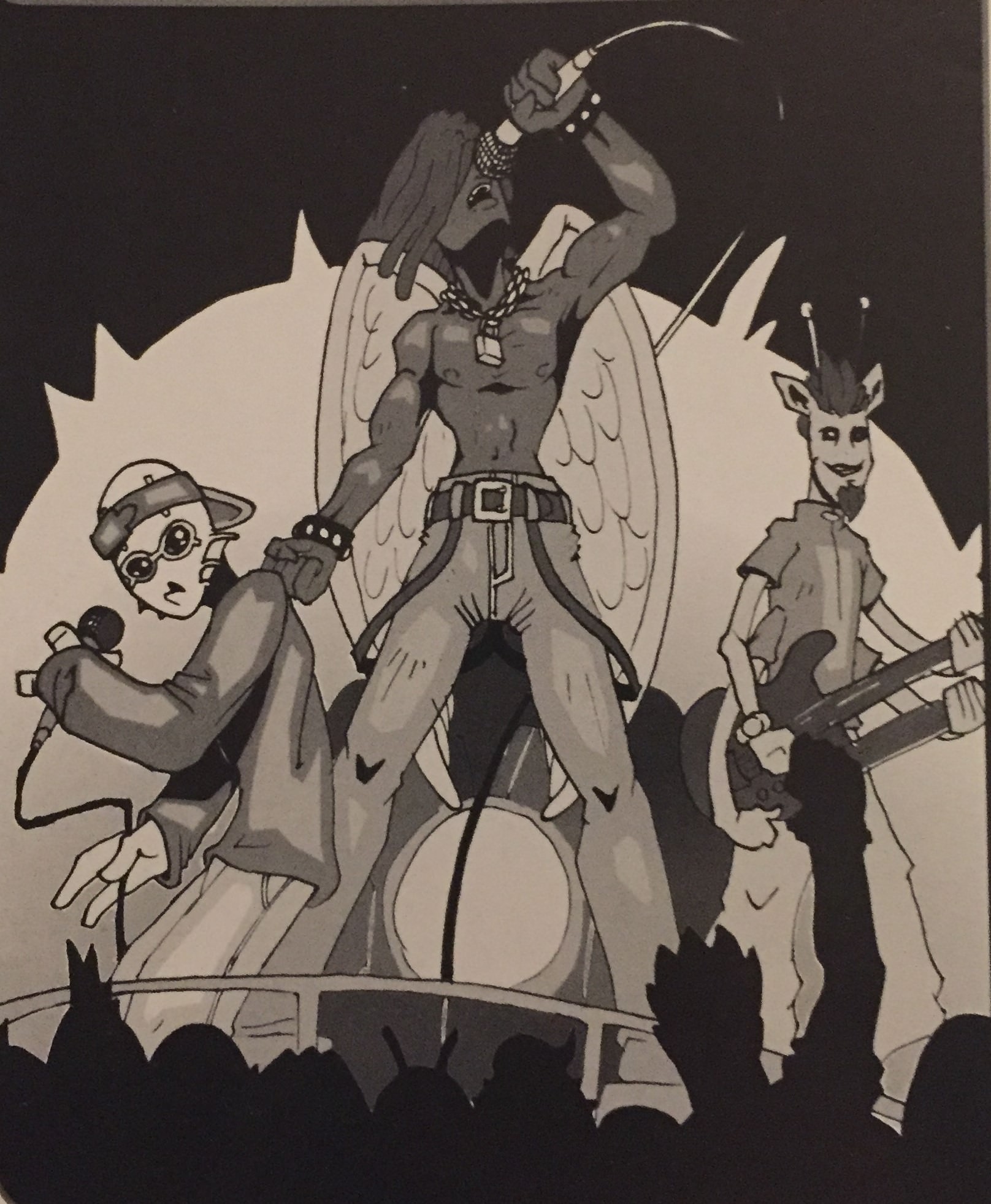
Scientific proof some people’s souls have no taste in facial hair
Art by: Clayton Graham
Realms of Eden
- Arcadia - Covers the entirety of Europe to Siberia, except the UK because apparently even in Eden there has been a poorly thought out Brexit. The layout of the realm is basically any medieval European fairy tale of hamlets and somehow dark forests full of adventures and secrets. This realm existed for 195 million years before evil existed and nobody investigated the place? This is what you get for having a realm of heaven follow monarchs who are fae folk
- Asgard - Covers “Scandanavian Countries to Germany” with no explanation for if that’s as the crow flies or around the baltic or an apology for retconning the geography of Arcadia. It is otherwise an unremarkable land consisting entirely of Viking culture stereotypes, down to having so much fighting some “darker souls” can be overlooked among their number and Odin is their leader. This makes the second realm ruled by Ahura Mazda where evil is just allowed to exist for no real reason
- The Commonwealth of Atlantis - This covers the majority of the Northeastern United States and contains the capital of Eden where a great host of souls from all over Eden come to make decisions as a group. Remember, though, there’s no way to directly traverse from one realm of Eden to the other without jumping into a raging spirit storm, traveling the Earth, and then killing yourself in the right spot so coordinating travel for these meetings must be hard. For a fun pre-9/11 bit there is a great ruined tower of Babel here bombed out by GODHEAD, but there are two new towers guarded by Ahura Mazda called the World Financial Plaza.
- Avalon - This is the smallest realm in the game, as it only covers the British Isles, and consists of a single, 10 mile square castle. Are there doors in its North Ireland portion that open to nothing, dropping you straight into Limbo? We’ll never know because this section is tiny and mostly concerned with telling you that this is like the exact same realm as Avalon, except here there ruler King Arthur, who is apparently a real person, is missing
- Bharat- This is India. It is the oldest part of Eden so why Ahura Mazda moved to Atlantis is unclear. The people here are described as deeply spiritual pacifists following countless traditions who make great cloth, so obviously a lot of effort went into this section.
- El Dorado - Mexico and Central America, this realm is nothing but ruins in jungles and a massive casino known as El Dorado. Their ruling government is made up of “Dons” and is called the Junta. I don’t like this road you’re going down, TLE.
- Guinee - The parts of Louisiana that Britney Spears isn’t from and some Caribbean Islands. Somehow in a world where God directly creates all matter and also explicitly isn’t George W. Bush, their capital city sank underneath a lake and Ahura Mazda shrugged it’s shoulders and told the inhabitants to work it out. Further, this actually might be a Hell (not Earth, the other kind of hell) and to further cement this fact the leaders of this place have known connections to the Hells. Despite this fact Ahura Mazda’s followers don’t investigate it and there is somehow a tourist economy, so I’m beginning to suspect Ahura Mazda is easy to bribe
- Midian - Israel, Palestine, and parts of Egypt. Was a Hell during the Crusades but now has been brought back into the neutral column. They used to be ruled by a group called “The True Sanhedrin” but aren’t anymore probably because that's really confusing to have two completely different groups that aren’t actually Sanhedrins in your game
- Oz - The game uses 40 words to define the borders of this region instead of just saying “The U.S. Midwest”. This whole region is just Frank Baum’s Oz with some geographic changes so TLE can claim that Frank Baum got inspiration for his book from this section of Eden through a process not discussed and that would probably undermine even more gameplay mechanics. They are ruled by a W.I.Z.A.R.D. and this time, unfortunately, the acronym stands for something; World Israel Zion Associated Research Directory. Yes, the secret Jew conspiracy is alive and well in a little old land called Oz
- Pangea - You know, I was glossing over your weird undercurrent of uninformed stereotype racism and Jewish global conspiracies but are you kidding me at this point, TLE? I can’t believe they published this realm that is the entirety of South America and Africa. It’s capital city is listed as “none”. Its culture is listed as “eat or be eaten”. It is paternally protected by souls from other Edens to keep it from ever progressing so that it can remain “wild and free” forever. It’s predominant religion are people in the jungle in “crackpot tribal sects”. In summary: Fuck You, TLE
- Samarkand - Remember how Xibalba the hell didn’t include Mexico City? This realm doesn’t include Samarkand, a real, actual city that half a million currently living human beings call home. Instead, this area is the middle east not covered by Midian, but the countries listed don’t include Iran or anything west of Iran, so they actually not only failed to include the actual city in this realm but also all of the cultures directly associated with it historically. Congrats, TLE, on being that terrible at geography. The rest of the description of this region is basically a highlight reel of Edward Said’s nightmares and the inhabitants are destroying their region by mining the lucrative resources that pour out of the ground.
- Xanadu - You know what, I’m still really mad at you TLE about your weird racism. I don’t care that this area covers the entire Pacific Rim, you literally just made your Africa analog a backwards place of no importance where the only economy is big game hunting. Who gives a shit that this place’s primary export is technology, or is ruled by Kubla Khan or whatever you want me to think about.

I’m so glad CGI art has improved tremendously since 2001. Seriously, guess what this is supposed to be
Art by: Brian Bradley
I want to take a break now, not just because I’m mad at the simmering undercurrent present in TLE, but because now we come to the part where the game falls apart. In about ten paragraphs the game invalidates the other 195 pages of writing, see below for the final sub-realm of the game:
- Omikoshi - Technically this is part of Xanadu but it’s broken out in TLE as a psuedo-realm all by itself for good reason. Remember how we recently found out any soul can freely travel from Eden to Earth and that kind of sorta undermines the game’s core conceit? What if we just went whole hog and wrote something that didn’t undermine our setting so much as undo it? The rest of this update is how much I hate Omikoshi.
The Omikoshi is a virtual representation of Eden written in the quaternary language Shingon* to communicate with the the scripting language which Ahura Mazda and Eden are made and defined by. By editing the Omikoshi you can make any change in Eden that you want at any time, with the sole exception of changing or deleting another soul. Souls can travel to the Omikoshi and treat it like an MMO so there is a completely parallel, equally real Eden that you can live in if you want that can also edit and modify the actual Eden.
Not only can you make edits at any time, you can make anything you want in the simulation and from there export it back to Eden. To repeat, the only thing Omikoshi can’t do is edit souls, but it can make literally everything all of the economies of Eden operate on, more land, change the properties of all matter, and anything else you want. The game doesn’t even make a mention that you can’t edit Ahura Mazda, in fact instead explicitly pointing out he’s written in the same code language Omikoshi runs on.
If the ability to kill Ahura Mazda with a quick registry edit wasn’t powerful enough, you can use the Omikoshi to instantly travel from Eden to any device on Earth that has internet access. The game then starts a paragraph telling us that non-messiah souls can’t make it to Earth this way without dying, but later ignores that and says all souls can hang out in cyberspace on Earth and control most data hardware and can be copied out of the devices by anyone on the other end with the requisite skill so I think player characters are actually worse at traveling between the two worlds than the average soul with a decent internet connection.
By the way, we’re not done yet with how broken Omikoshi is. See, it turns out that Earth runs on the same code base, it just has encrypting or hashing or something that prevents easy editing. Immediately after introducing this limitation, the game states that Omikoshi still works well enough to edit pretty much anything on Earth temporarily before GODHEAD restores the area to last known working version after about a week or two and that the researchers who work on the Omikoshi have made solid progress into GODHEAD’s code changes and will soon be able to change Earth at will just like they do Eden.
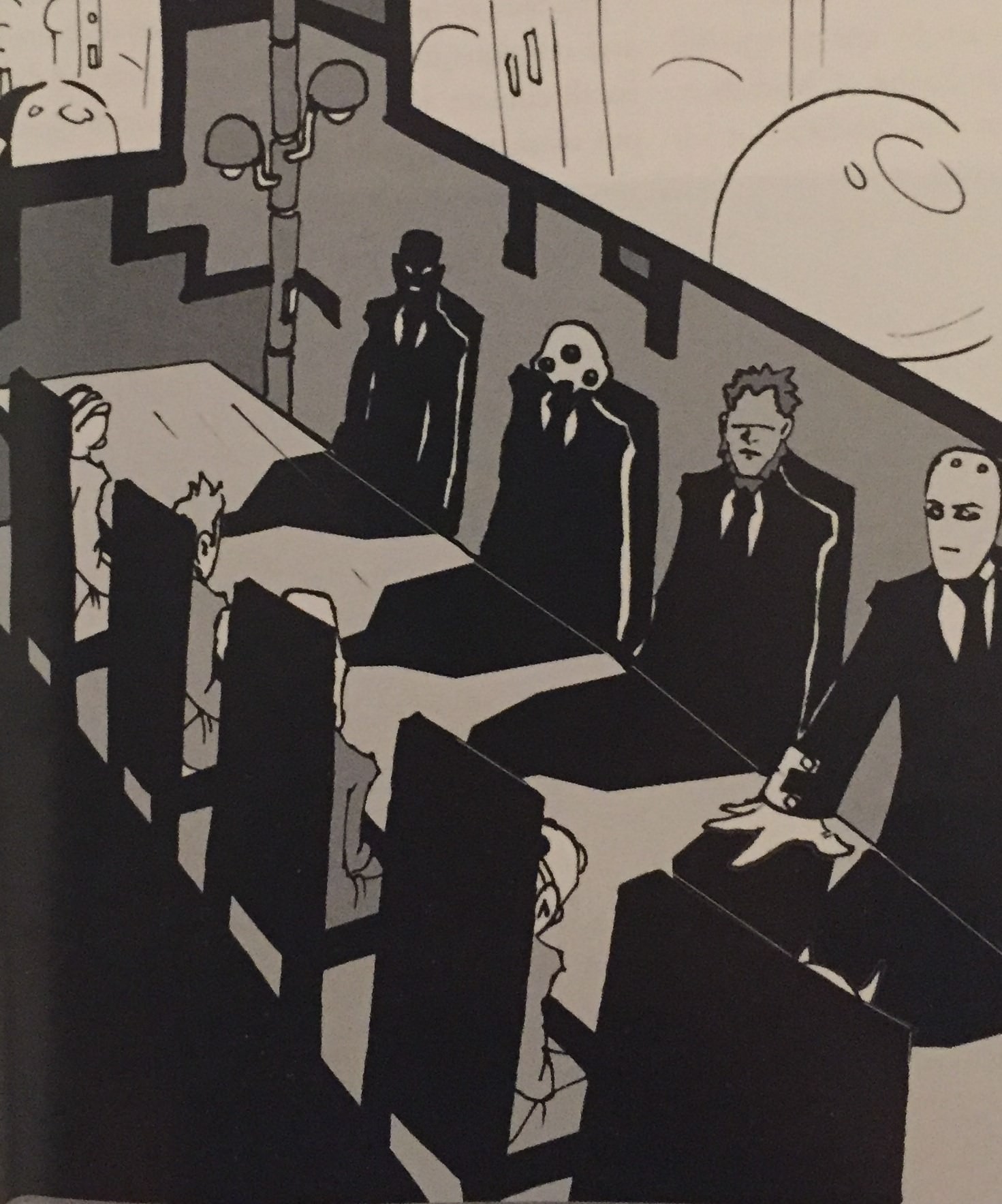
All in favor of ignoring the Omikoshi?
Art by: Clayton Graham
What is even the point of the entire game if the Omikoshi exists? With it, in Eden alone, you can do the following things
- Toggle off Ahura Mazda
- Delete all Hells, instantly dumping the entire army of GODHEAD back into Earth
- Disable all incoming souls on whatever ports you no longer want available
- Route all soul traffic as you see fit
- Build anything you want from literally nothing
- Travel back and forth from Earth freely and instantly
- Build infinite Omikoshis to crack Earth’s encryption scheme, then delete GODHEAD
In my time I’ve seen dumb settings, and I’ve seen dumb things that undermine settings. We are all aware that Heartstaker games tend to have problems where hiding in the shadows is sometimes nonsensically enforced, splats can’t do the thing they’re designed for, inter-party mind control crops up, and sometimes the best arrow for your bow is a Jumbo-jet airliner. This is just a whole new level where there is no point in attempting to interface with any of the games systems because they’re meaningless in setting, and it is not possible to construct a problem within the games established framework that can/should not be resolved with the Omikoshi.
For the rest of this review I’m going to actively ignore anything to do with the Omikoshi, because otherwise the review would just stop here. It helps a little, though, that the writers of this game are terrible because very little in the game directly references Omikoshi moving forward, and almost none of it has specified rules.
In closing:
Next Time: Stop Making Your Character and Sit Through Bible School
*The authors’ know possibly less than nothing about programming
Stop Making Your Character and Sit Through Bible School
Original SA post
Last Exodus the Interactive Story Arc of the Third and Last Dance is a roleplaying game from Synister Creative Systems published in 2001 and designed Sean and Joshua Jaffe. It’s a metaplot heavy, playing card deck using, religious themed urban grunge game. Unless I am otherwise notified it appears to be completely out of print with no digital versions available. Should this be incorrect I will update to include where it can be bought to give the original developers income.
Part 8: Stop Making Your Character and Sit Through Bible School
Finally, with a heavy, fetid sigh of relief and ignoring as much as the previous section as we possible can, we can come now to the part of the game where we can start building our characters. The first thing that we see is a literal 14 point checkli--, haha I lied! We actually have more rules hidden in fluff that should have come about 30 pages ago. These are mercifully short and basically just recount a bunch of things we've already learned from context clues already. The only new things we get here is that 1) miracles are an actual class of abilities we can learn at character creation and 2) if your character background isn't that you came from a single parent household, one of your parents got cucked by God*.
Ok, now we get to the 14 point checklist of how a character is built. I would offer to try and build a character in this system based on suggestions, but as you might have gathered from the only two available parent stories there isn't a lot of narrative leeway in character creation. I'll also be doing by best to avoid it, but rules in this section aren't so much as laid out as "strewn wildly wherever the authors could fit them" so for instance rules about things you can point buy and the rules for how points are spent and how many points you have are often 10+ pages apart, and not all point buy rules are near each other nor do they all follow the same rules. TLETISATTALD.
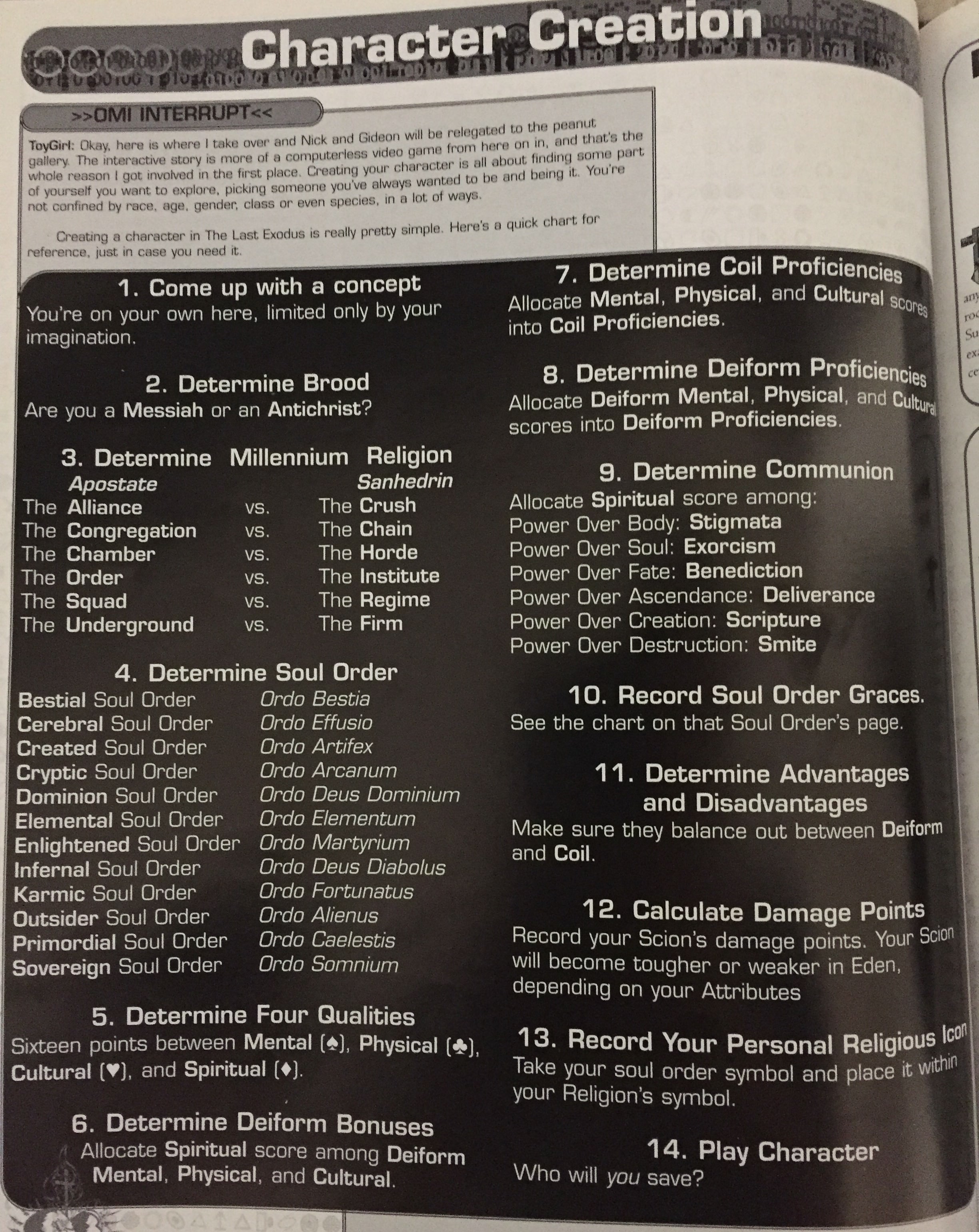
Step 13 has the same number of sentences here as it does in the section explaining it
The first step is unsurprisingly a good bit of advice and tells us to design a character concept that we’ll build throughout the process. This might work in a game where we have any idea what we’re supposed to be doing in it but here it is almost actively harmful because with character rules buried throughout this section if you have something in mind the first time you’ll miss the dozens of rules. Once we’ve done that, you pick if you are a spawn of Ahura Mazda or GODHEAD. You are thinking now thinking, wouldn’t this go disastrously if my player party were half Ahura Mazda and half GODHEAD players so we should talk about this beforehand so we know what kind of game everyone wants? Don’t worry, I’m not psychic**, it’s just obvious.
Remember now, and it’s ok if you don't because I barely do, that around 80 pages ago in this book they introduced the Millenium Religions? Well now you have to choose one of them to swear allegiance to. This isn’t optional, and this is the first time we’ve actually gotten a description of any of these. Each gets a two page long write up for a total of twenty-four pages and despite being smack-dab in the beginning of character creation contain 0 game rules other than the ritual your religion uses to travel between Eden and Earth. That ritual, by the way, is typically a one to two sentence description so it’s not even immediately obvious those rules are buried in the text. The Millenium Religions, as it turns out, barely even begin to qualify as religions, not the least of which is because the largest of them has 300 members total worldwide. Let’s do like the book and bring character creation to a halt and do rundown of all the religions because I promised it, shall we?
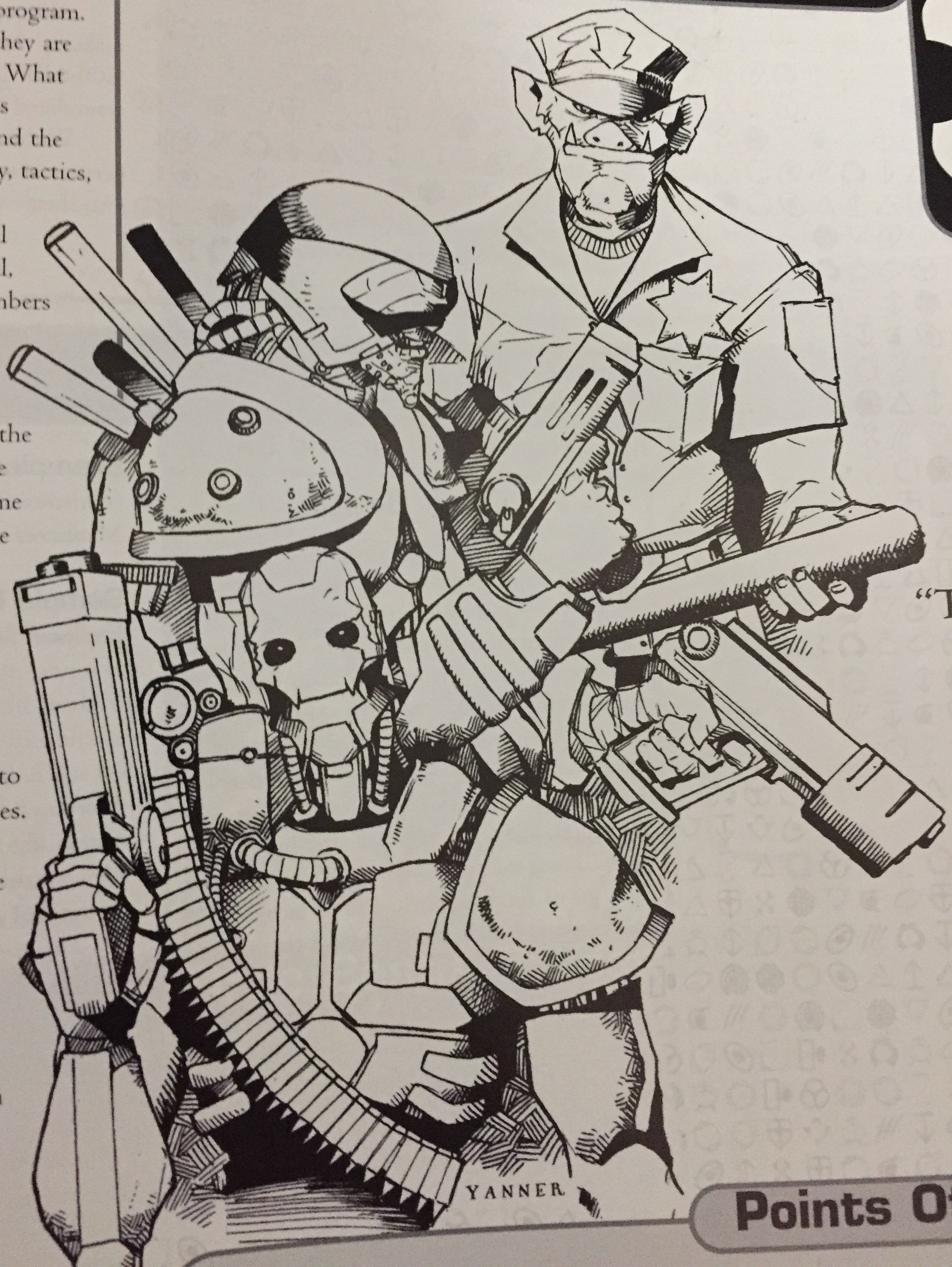
Look how happy the evil pig cop and evil death robot are. They look like fun dudes. Pig Cop and Death Bot, the funniest program in two dimensions returns this fall!
Art by: Kieran J. Yanner
Apostate Millenium Religions
- The Alliance - This is Jedediah Bronson’s religion, he the white south african who has knowingly committed atrocities so I’m sure his organization will be on the up and- “The Alliance reasons that they will do what they must to prevent the Sanhedrin’s atrocities, and should they have to commit a few of their own to stop their enemies so be it”. As if that weren’t enough, the Alliance has started running prostitution and drug rings to “try edge out the GODHEAD on some of its own turf”. WHY ARE THESE GOOD GUYS?
Cross to Eden By: Recounting a tale of horrendous personal trauma that they survived, and it has to be raw because you need the emotion of trauma to cross over. Do note it doesn’t need to be fighting for a good cause or anything morally upright, because I don’t think their membership could make that work.
Song Choice: Veteran of the Psychic Wars by Blue Oyster Cult
- The Chamber - This is Emily Vasquez, she of family so this group is all about listening to an unquestioned voice in your head that tells you to do things like eat the Triboro bridge. Yes, the Chamber is basically everyone who got rejected by society for being different and now lives in the sewers and talks to voices. Good news, because in a hilarious bit of hindsight is 20/20 the voices told the Chamber to rig the 2000 presidential election to elect George W. Bush. That’s right, Al Gore was a plot by GODHEAD and George W. Bush really does talk to God.
Cross to Eden By: Having the voice tell them what to do. There are no rules or limitations other than they can’t cross until they complete what the voice tells them, so good luck eating that bridge.
Song Choice: Criminal by Eminem
- The Congregation - This belongs to Dragomir and is basically just generic religious types in a pile. It goes out of its way to call out things like wiccans and Rastafarians are among the ranks but remember, there are only 250 members. There aren’t Rastafarians, theres only Andrew. Anyway, their goal is to unite all the world’s religions but aren’t openly telling them about their ability to transport people to another plane of existence because I guess that would be too easy? Also, we find out Dragomir explicitly resents Ahura Mazda for not saving his wife so why is he here?
Cross to Eden By: Praying really hard to God. It’s not clear due to nebulous use of plurals if all 250 members have to pray simultaneously to send someone to Eden, but it might. Ask your Director.
Song Choice: One Child by Savatage
- The Order - This is the ninja raver coder club run by Dexter. The requirements to be a member are both “be one of the 300 best hackers in the world” and “be an accomplished artist, preferably in music”. They actually throw raves to recruit hackers which means that I assume they are populated solely by Silicon Valley startup bros. Surprisingly, despite all being artists they detest Earth and none of their members reside here. Unsurprisingly they all plan to merge with the Omikoshi since they think Eden is a fraudulent heaven. Wait why are these Good Guys again?
Cross to Eden By: Running an app on their PDA. It only works for them and only works if they have that PDA, but again, transcending the plane of reality needs less than 512kb of ram.
Song Choice: Kooler than Jesus by My Life With the Thrill Kill Kult
- The Squad - This is Tane Jackson’s squad, and is in a way that tried very hard to be progressive for 2000 CE, a religion entirely of hip-hop artists and gang members. They are the platonic ideal of a street gang, however, in so far as they keep kids in school, reinvest in their communities, and don’t allow drugs which should put them in direct conflict the Alliance but that goes unmentioned. By the way, remember Blood-Nazi Evil Cop, Captain Stayne? The Squad has a truce with his religion so that they can play 5 man B-Ball tournaments against each other.
Cross to Eden By: Getting really, really, really mad about injustice. TLE recommends yelling at random people about injustice so I think these dudes are honest to god literal Social Justice Warriors.
Song Choice: Big Black Boots by Ice Cube
- The Underground - Off the bat the game assigns this to the wrong person for that good old fashioned Gareth-Michael Skarka editing seal of quality. It is supposed to belong to Ursula Tango and this is the underground artist commune. They take all types of artists (fuck The Order, stop stealing our DJs) and their goal is to disrupt GODHEAD through art which is frankly sad and very confusing in a setting where theoretically normal people don’t know the truth of the world. The game lists Kevin Smith as a member which I won’t dignify with a joke.
Cross to Eden By: Creating an original artwork and channeling their creativity into it. If you realize that this takes considerably more time and effort than “I use an app on my phone” congrats, you aren’t a writer for TLE.
Song Choice: Anybody Listening by Queensryche
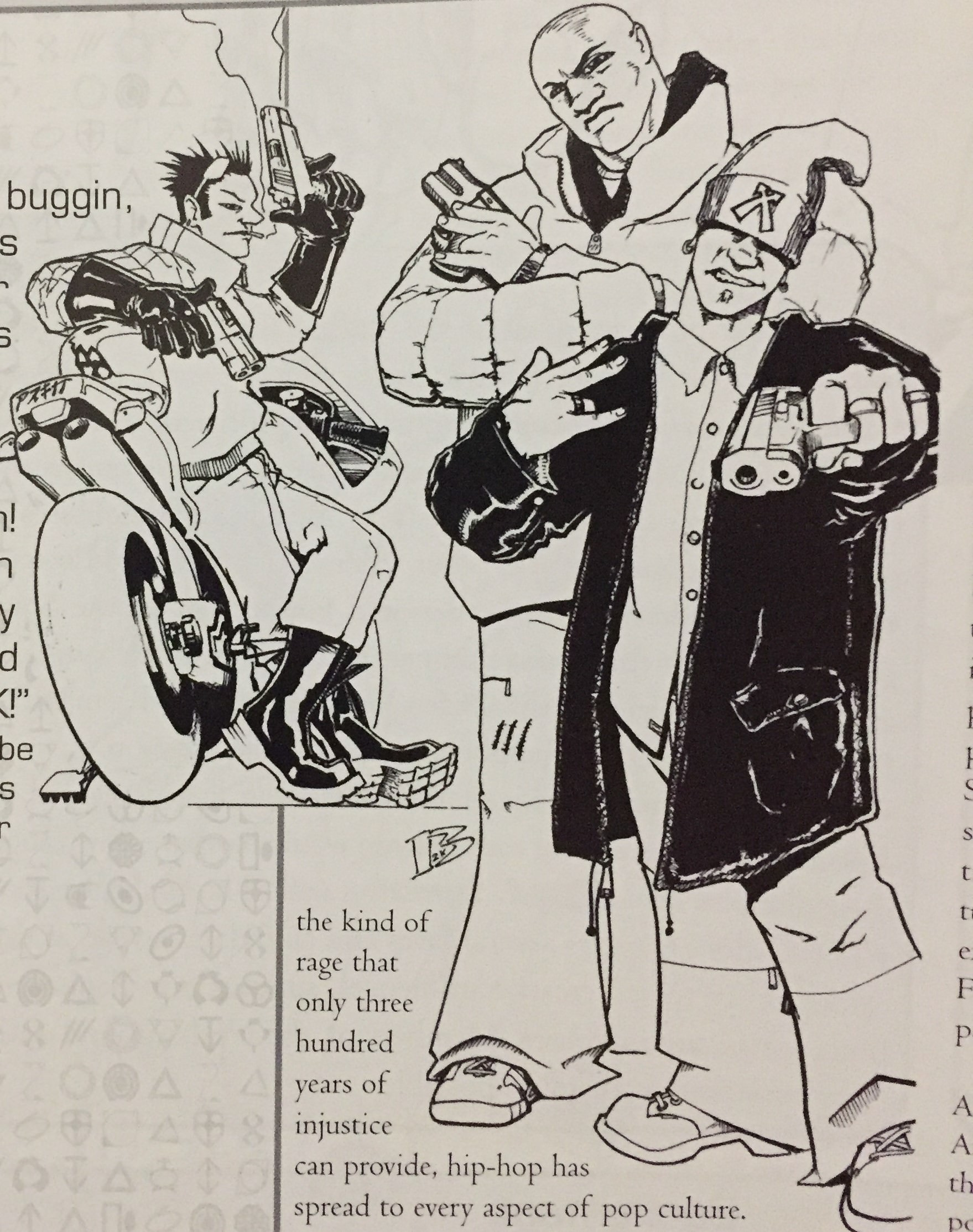
Read the sentence fragment in the picture and then try to figure out how that paragraph started with a statement that the squad includes all races and, it’s words here, “sometimes whites”
Art by: Kieran J. Yanner
Sanhedrin Millenium Religions
- The Chain - Belonging to Madison Vaughn, this religion is your generic “I want more power” religion where they push social order to forgive their crimes and transgressions. Stupidly, you have to murder a close personal friend, family member, or lover in cold blood to join. Intelligently, they’re the only group of people in this entire gameline whose goal is to kill Ahura Mazda and GODHEAD and replace them so I think they may be the actual heroes of the game. Their base of operations is the Luxxor Hotel which is frankly hilarious in a saturday morning cartoon villain way.
Cross to Eden By: Killing something at the end of a personal occult ritual, which must last longer than thirty seconds. There are no specifics on what has to be killed, so I think antibacterial soap might work.
Song Choice: Lucifer’s Flower by My Life With the Thrill Kill Kult***
- The Crush - Run by Evan Powell, their tagline is literally “Kingdom Cum”. They try to play up that their scary murderers, rapists, and torturers who live on passion and demonize behaviors like homosexuality to make their perversions more powerful somehow but seriously, their tagline is “Kingdom Cum”
Cross to Eden By: Must finish a “sex act”. The game notes it need not involve another person so presumably a lot of teenage boys can travel to Eden.
Song Choice: I by Black Sabbath
- The Firm - This is Franklin Talbot’s religion. In addition to being an insanely successful business-man, for $10 million he will tell you the secret to all reality and how to safely transfer between Earth and his private section of Eden which is a super luxury vacation place. Franklinfinancial system works across Ahura Mazda and GODHEAD realms, can convert from Eden currency to Earth currencies, and is so integrated with all finances and business he and most senior employees have diplomatic immunity from Ahura Mazda. They are unaligned with the GODHEAD or Ahura Mazda and their only interest is continuing to do business and employ more people so they can do more business. If you thought maybe they paid badly or worked employees to death, the game actually lists their entire benefits package and it’s fantastic. Heck, the game even calls out they donate large sums to charities, including those run by their supposed enemies the Apostate.
Cross to Eden By: Calling the service number on the cell phone they get for being a member and instantly warping to Eden. It costs $150 bucks per person to use each time, so it’s literally the only thing in the game with a defined price. I need to point out that this power explicitly works for groups, even for those who aren’t members of Franklin’s religion, making it the only way to travel to Eden all at the same time and without tons of individual character roleplay vignettes.
Song Choice: Step Right Up by Tom Waits. Franklin gets the best taste in music too, apparently
- The Horde - Run by Virginia-Mae, the KKK member who can turn into a dragon this group is going to give racism a punchable fac--- GOD FUCKING DAMMIT TLE. It turns out that The Horde in TLE is a mind-parasite that infects people and makes them ultra-racists and controls their actions to the level of preventing them from hurting each other even if they should want to. Remember what I said back at Pangea TLE? Here it is again: FUCK YOU!
Cross to Eden By: You have to cut yourself and bleed from it. Don’t want to play a brain-parasite racist who self harms to try and kill God? Is it 2 Edgy 4 U, you baby?
Song Choice: Down With the Sickness by Disturbed****
- The Institute - Run by everyone’s favorite 40k Elves/RIFTS Power Armor Love Child, Dr. Stone, this is your crazed evil science cult. Except, in a game where you can clone god it’s not particularly that insane to want to figure out how, exactly, that works. They aren’t given any real “torture for no reason” quirks, they’re just portrayed as detached “science for science’s sake until we can clone god and/or kill god” labcoats. They, importantly, have proven some dogs go to Eden, but do not have enough evidence yet to confirm that all dogs go to Eden. The research continues.
Cross to Eden By: Getting really, really, really high on drugs. It’s a unique cocktail for each member and you can only get it injected at an Institute run location, but it’s straight up ultra-drugs.
Song Choice: Army of the Pharaohs by Jedi Mind Tricks
- The Regime - This is Captain Stayne’s religion and again, we encounter some issues with these guys being evil. Yes, they absolutely are all about militarism and help train the armies of Hells***** to defeat Ahura Mazda. They are, however, also the police force and tolerate according to the game no racism, criminality, or excessive lust for power and explicitly, by name, hate ½ of the other Sanhedrin religions and will not work with them. Their closest allies are the Institute which supplies their technology and… the Squad. They have mandatory cross-team training programs and provide free, high-security housing for their members families. There is actually not a single mention of them committing atrocities or war crimes or brutality of any kind in this section, unlike the Alliance. WHY ARE THESE PEOPLE BAD GUYS?
Cross to Eden By: Winning a fair contest of some kind of physical skill. You read that right, the big evil soldier guys can’t travel between Eden and Earth without community outreach, open and fair rules, and consent between parties. WHY ARE THESE PEOPLE BAD GUYS?
Song Choice: War Ensemble by Slayer
Finally, we’re done with that and can actually build a character next time.
Next Time: One Stat to Rule Them All
*”Cucked by God” is just such a beautiful phrase.
**I can only read your mind
***I get it, you like MLWTKK, you like acronyms, we know.
****Frankly, there is nothing else it could have been
*****Not Earth, the other ones
One Stat to Rule Them All
Original SA post
Last Exodus the Interactive Story Arc of the Third and Last Dance is a roleplaying game from Synister Creative Systems published in 2001 and designed Sean and Joshua Jaffe. It’s a metaplot heavy, playing card deck using, religious themed urban grunge game. Unless I am otherwise notified it appears to be completely out of print with no digital versions available. Should this be incorrect I will update to include where it can be bought to give the original developers income.
Part 9: One Stat to Rule Them All
After that grueling 24 pages that could have been 12 paragraphs, it’s time for the next step in the process of character creation, which you guessed it, is just a raw slurry of more fluff mixed with a light touch of actual rules. This entire section is staggeringly labyrinthine, and as confusing as it can possible be, with rules laid out wherever they can and naturalistic language failing every single place it possibly can. The word “regular” without any appendation or explanation is the enemy of all things gaming and TLE loves it.
Let’s get down to it though, after picking what “religion” of 250-300 people we join it’s time to pick our characters Soul Order. It turns out that GODHEAD organizes all souls into 12 orders that describe both the Soul’s nature as well as some abilities they usually have. The game then mentions that Eden uses the system even though it’s from GODHEAD because [error: reason not found] and that Eden actually has thousands of Soul Orders so these 12 presented aren't inclusive of all the options in the game. In one of the Soul Order descriptions it then fires another volley at the core conciet of the game by a) introducing Heaven as a real place that isn’t Eden and b) noting that Heaven-Eden-Earth are but one of literally infinite sets pocket dimensions with their own clone-able Gods that can be traveled between so why does literally anybody give a shit about choosing to support GODHEAD or Ahura Mazda?
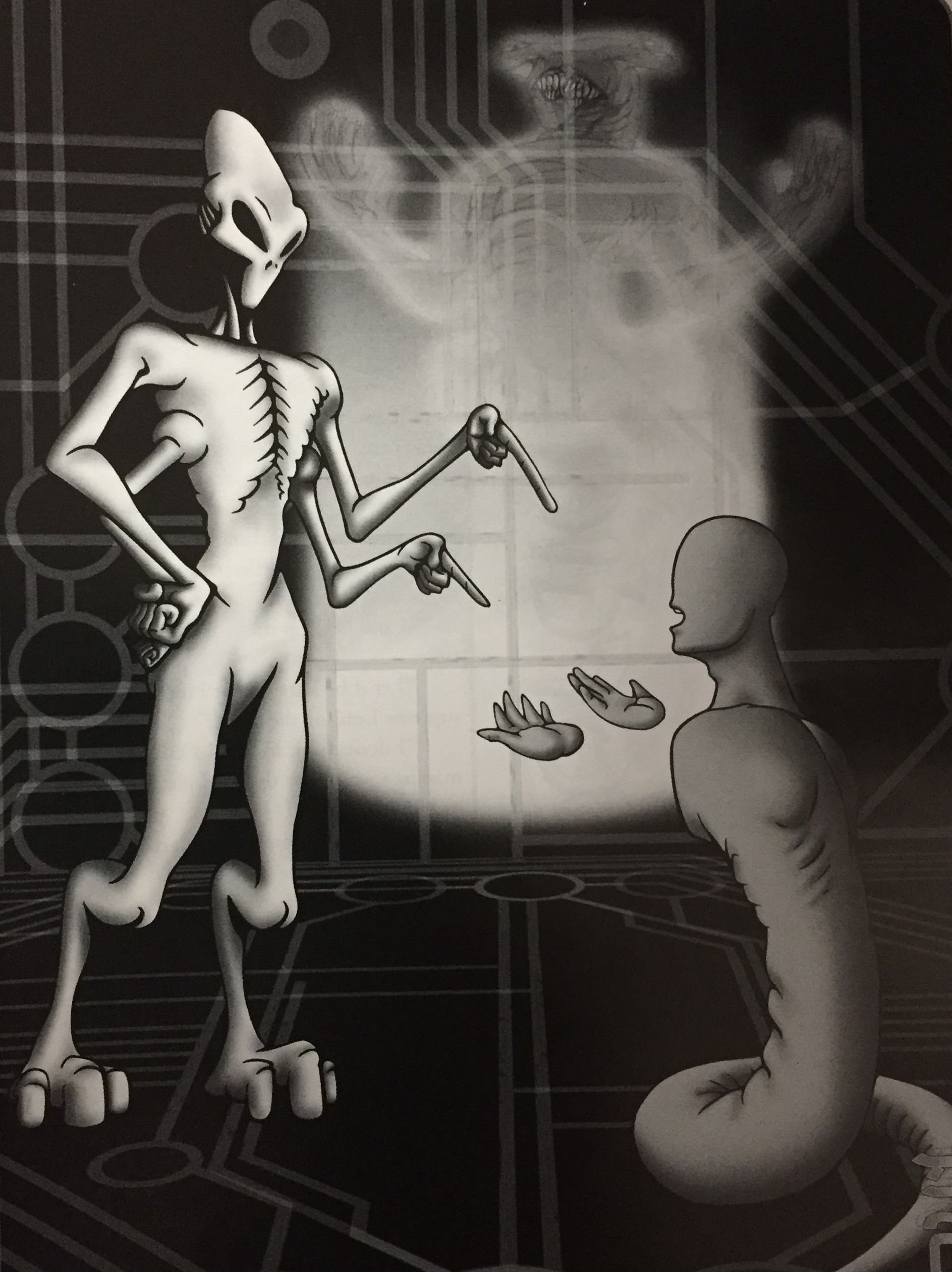
I told you, if we got you a pet you’d have to take it for walks
Art by: Frank B. Fallon
These Soul Orders, mechanically, have lots of overlaps with each other, designed so that each overlaps about 90% of its content with three other Soul Orders and has one unique to it power. Since there is no progression to these powers and you can pick a Soul Order’s unique skill at character creation you better pick a Soul Order with a kick-ass one. Compare getting items from a list of "onboard weapons" when no such list exists against becoming immune to all "regular" damage in a game where that isn't a defined term so presumably everything does regular damage, do so instantly at will, do so with no time limit on the ability, and with no indication you can't attack while using it.
By the way, you won’t find out until fifty seven pages from now but the game as written doesn’t ever let you buy more of these skills, so you need to pick right at character creation. See XP can give you more points but the game notes those points can only be spent during character creation so I guess sit on your points like a points dragon. You might further be wondering, hey, if I buy these graces, what points do I buy them with? Well you use the stats that aren’t introduced until after this section, then cross reference a single paragraph that occurs forty pages after the introduction of Soul Orders and sixteen pages after introducing stats, in between two short sections covering things that have no relation to Soul Orders.
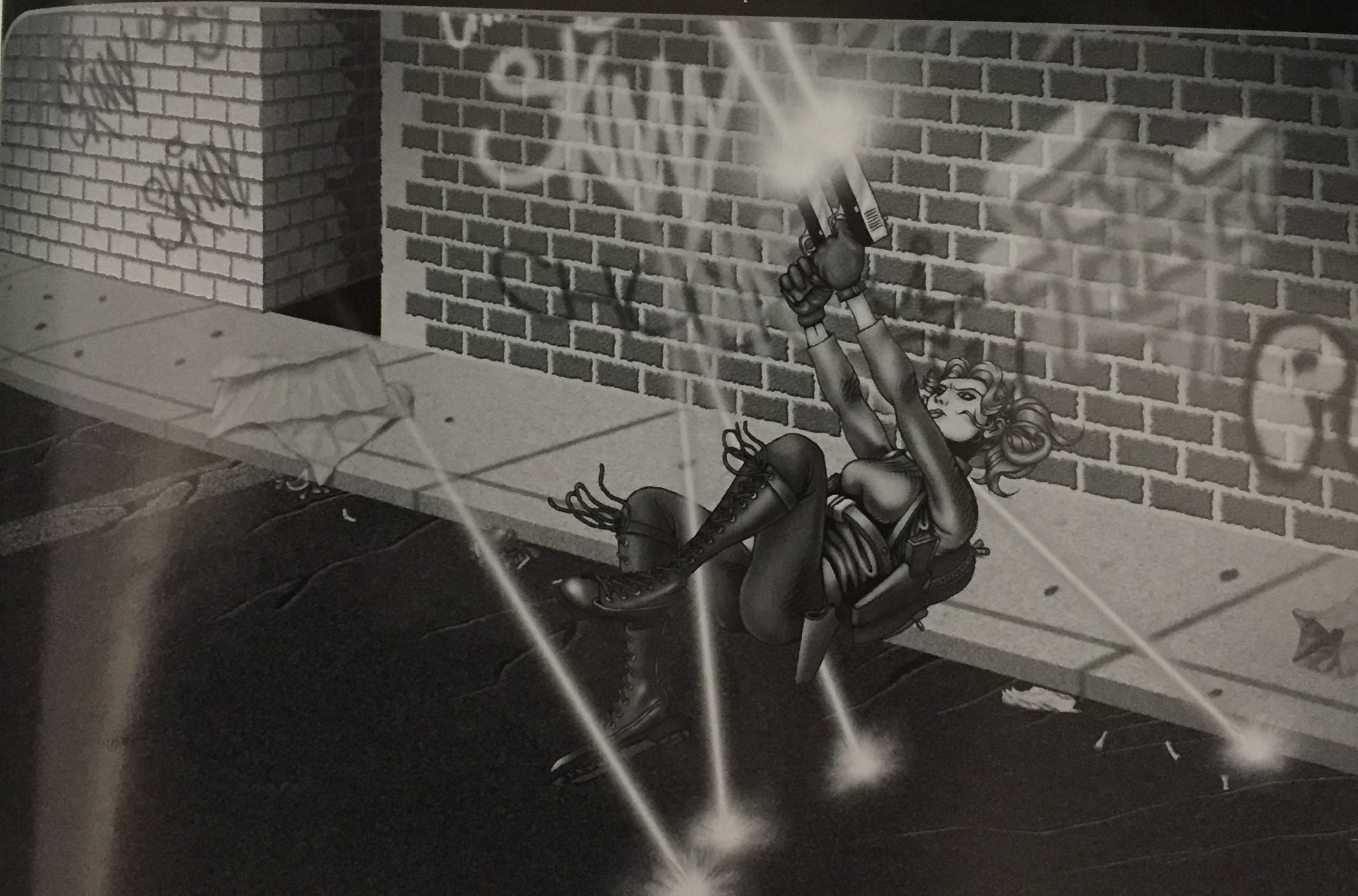
Where are you dodging to?
Art By: Frank B. Fallon
Finally, though, it is time to alot our character stat points. In TLE, you have 4 stats; Physical, Spiritual, Mental, and Cultural. Amongst these 4 stats you have 16 points to split among them any way that you please with a 1:1 point per stat increase, with a cap of 10 in any given stat. The game doesn’t mention it right now when it should, but there are some derived scores from these such that if you don't point any points into physical you'd have 0 HP and would instantly die and go to Eden where if you have 0 points in Spiritual you double die and your character is dead forever instantly.
If you curious what these stats do or how high you should reasonably be putting them, don't worry, you're 30+ more pages away from finding out what the game’s resolution system is not that it works there either. You're also about 10+ pages away from finding out that those 16 points only reflect your stats on Earth. To determine your stats on Eden, no real math is required, you just add you score in that stat + your Spiritual stat. Remember how most Hearstakers make Dex the God stat? TLE’s Spiritual stat is about to cordially invite them to eat it.
I’m pulling from across the book, but let’s end this part by taking a look at everything the Spiritual stat counts for.
Spirit Stat Influences
- It determines you score in the Spiritual Stat*
- Is added to all of your other scores when in Eden to determine your stats in that realm
- Is added to the calculation for all derived scores from stats in Eden
- Only your Spiritual score is used to determine what skills you Deiform knows in Eden, all other scores are only for Earth
- Is the only stat used for determining what spells you know and how good you are with spells on Eden and Earth**
- You can only buy bonuses from your Soul Order equal to your starting Spiritual score
- You can only buy ranks in Miracles equal to your starting Spiritual score
- Spiritual controls any checks involving Soul Graces, prayers, miracles, resisting all magics, double resisting some other specific magics, traveling between Eden and Earth, among other things
- Once per combat encounter you can use you Spiritual score to attempt to avoid all damage you would take
The only reason you wouldn’t just shovel your points into Spiritual is because you plan to run a game that only takes place on Earth, and even then you need to put one point into it so that when you die on Earth you don’t instantly double die on reaching Eden.
Next Time: Proficiency: Sex
*Duh, but still, it does it
**You do need the other stats to determine if you can use those spells on Earth, but since you take an immediate 50% penalty to all attempts to using spells on Earth and requires you spending very limited points on that it’s a trap option of the finest sense of the word.
Proficiency: Sex
Original SA post
Last Exodus the Interactive Story Arc of the Third and Last Dance is a roleplaying game from Synister Creative Systems published in 2001 and designed Sean and Joshua Jaffe. It’s a metaplot heavy, playing card deck using, religious themed urban grunge game. Unless I am otherwise notified it appears to be completely out of print with no digital versions available. Should this be incorrect I will update to include where it can be bought to give the original developers income.
Part 10: Proficiency: Sex
Picking up where we left off in character creation; after putting your initial 16 points into the 4 primary stats you need to choose what skills your character will specialize in. Skills are grouped under the four primary stats but are noted in the game as not being a complete list. In the case of Spiritual there actually aren’t any skills under it, just a note on all the types of check in the game that will fall under Spiritual. The total number of points you have in a stat totals how many unique skills you can have of that stat's type or how good you can be at those skills. So, for example, if I have Physical 5 I could take one point in athletics, drive, exertion, fight, and melee each or I could put five points into “sex”. Yes, in a game that says its skill list is incomplete it found time to make that a skill, and yes, it is separate from Exertion which is a different Physical Stat skill and Seduction which is a Mental stat skill, so good lovemaking has some multi-attribute dependency and point buy limitation issues.
Next step in the process is... not doing this all over again for your Deiform. Or maybe you do? The game is so badly written here I’m not actually entirely sure. I’m assuming you don’t do this process again but with your Deiform stats and instead you're supposed to just ignore the fact that the list of stat skills we just used only ever uses the term for things that can only be used on Earth. I sort of back-solved to get here, basing my assumption on the 3 stated NPCs in the game, but I'll note they're built incorrectly according to the rules we just covered on how you buy skills for a stat so frankly I have no goddamn idea. As a counter to my interpretation, the skill “Dream” notes that in some rare cases using it allows you to travel to Eden from Earth implying that a) this skill only works on Earth and that b) the game has once again undermined its setting by allowing another way to shift without using a millennium religion and being a Scion.
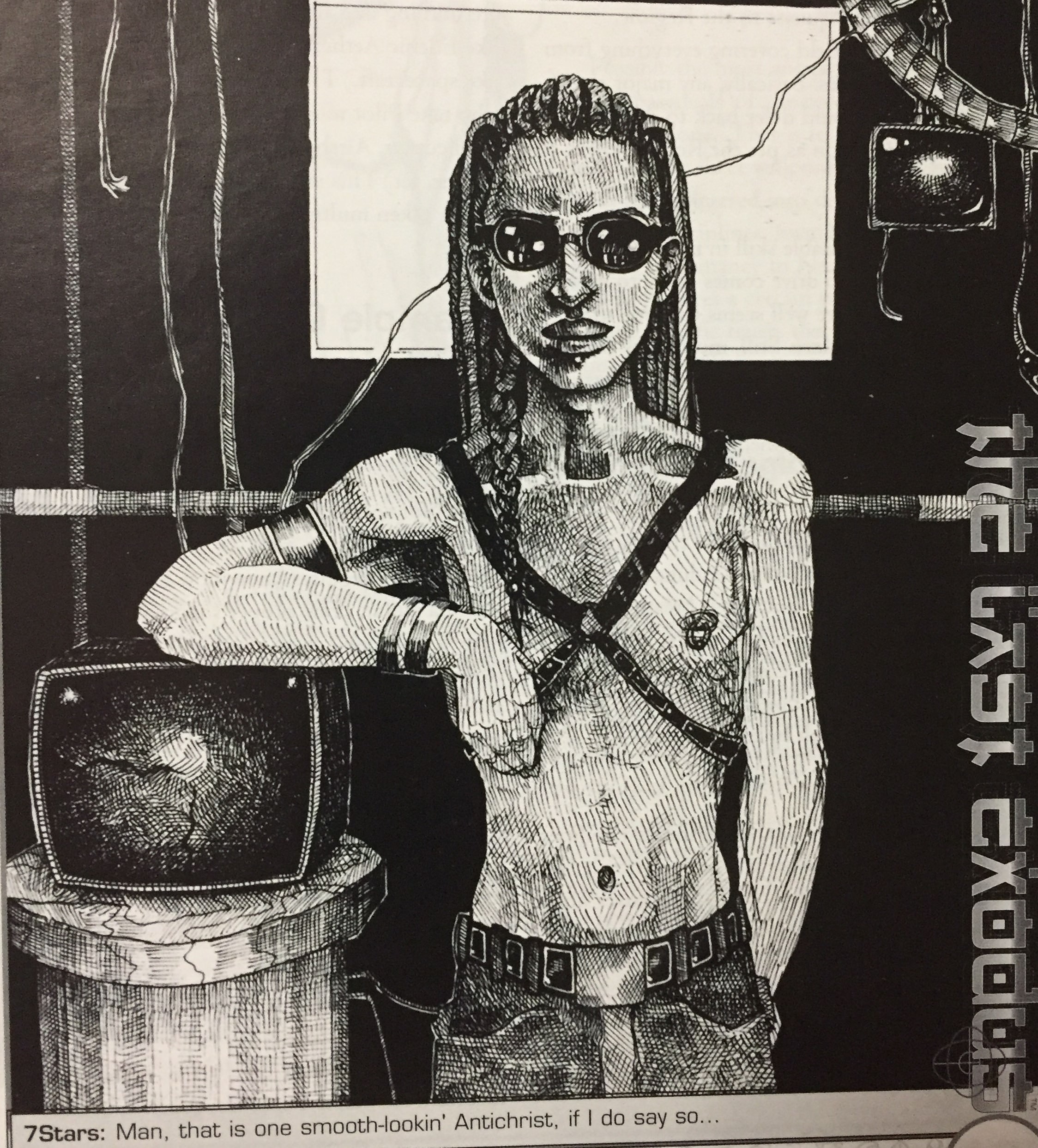
Did “smooth” mean something else in 2001? Did it mean unable to afford functioning televisions, possibly?
Let’s just assume that you don’t do this process again and instead just keep the skills you had on Earth. This means, rather explicitly, that Deiforms which can be things like “a corpse of a dragon” and “A
Next up is magic. There are three schools of magic, one for each major stat excluding Spiritual, and magic can be used on Eden or on Earth with some penalties. It uses the same rules as the skills, where you score in the matching stat controls how many skills and how good you can be with them. Except, guess what, thats not true at all and it's based off only your Spiritual stat. All that the associated Mental, Physical, or Cultural stat skill does is determine how good you are at using those specific pools of spells while on Earth. Note, you face a 50% penalty to your attempts to use magic on Earth and can only use skills half as strong as what you can use on Eden, and getting better with magic on Earth competes for the exact same points you could be spending on skills so it’s an obvious massive trap option to be a magic user on Earth. It is in fact such a terrible trap option the game itself recommends you not do this.
We then get given the lists of magic, divided by what Earth Stat controls them, and all of which get a paragraph describing them. Each then only gets three spells and because the rules are completely indecipherable you may or may not need to take any previous spells to take others in the same pool. There is, unsurprisingly, absolutely no cohesion to any of the spell effects within an overarching Stat’s pool of magic. I also have to talk about the art in this section where we are describing inhuman wonders of magic 2/3rds of the art pieces are a woman with at least one breast exposed and zero magical things happening.
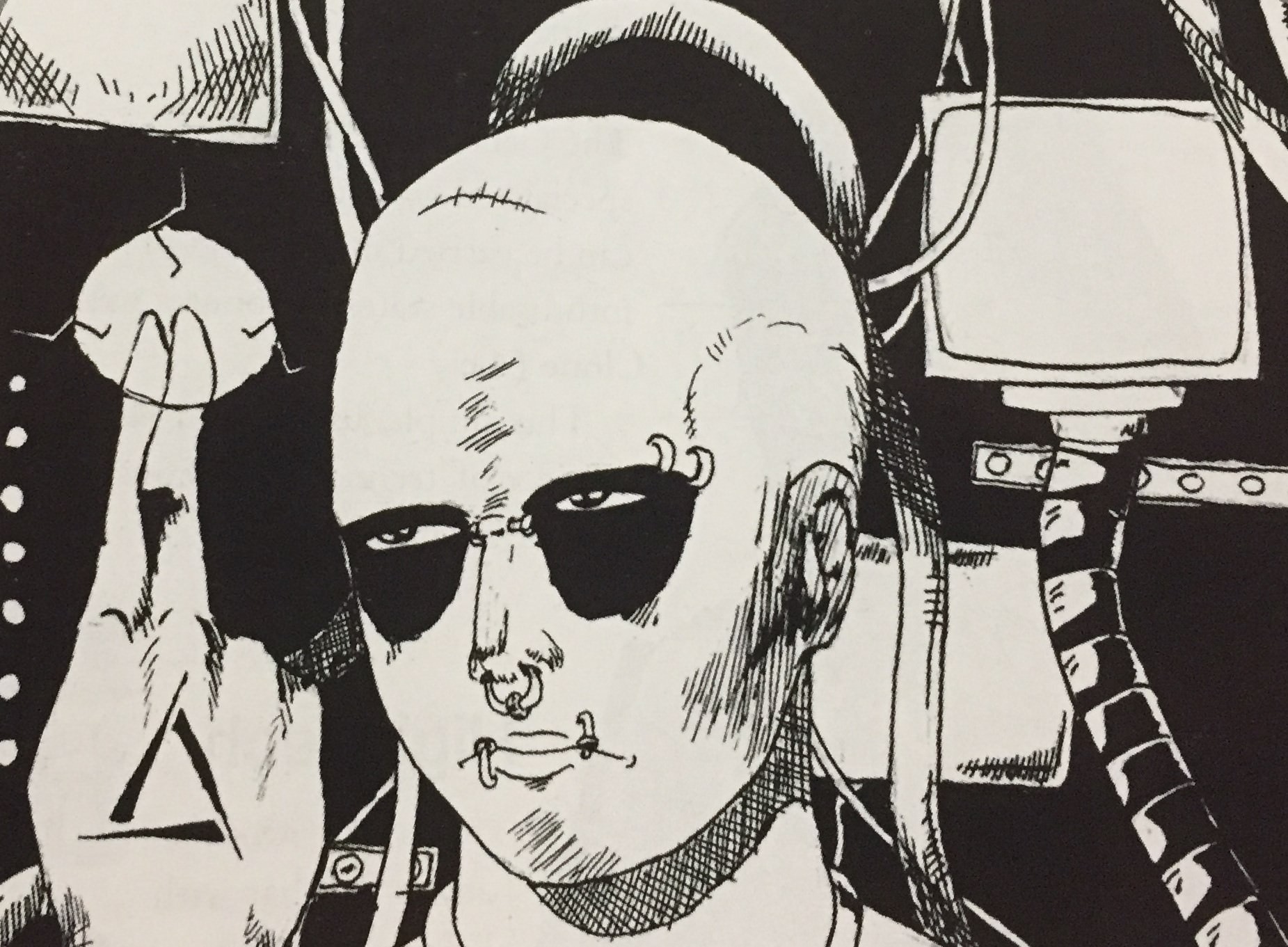
TLE boldly allows your character to be twice as powerful as E.T.
Art By: Peter Johnson
The spells are as badly thought out as you could possibly imagine:
The Many Failures of TLE’s Magic Spells
- Spells that are purely director fiat like how much gold is worth or scrying the future,
- Spells which mechanically don’t do anything because the game has no rules for it like “turn your opponent into a newt” or “stun your enemy”
- Spells which are confusing because the games mechanics are terrible like anything to do with healing because the game has three separate health tracks or “[MOD] damage”
- Spells which replace equipment and the need for the Physical stat like infinite magic blasts stronger than guns
- Spells which are supposed to be passive and weren’t noted as such so you can infinitely boost all of your stats to maximum
- My personal favorite, Spells which invalidate the setting like ones that let you summon any soul you want to Earth immediately and without fail or ability for that soul to resist
In closing on the spells section, let me leave you with this quote:
”The technician can “MacGuyver” things like making a laser out of some panties.[...]Subject to Director approval
Whats that, a direct invitation to screw over someone who invested literally their entire character into “can create mundane things from seemingly unrelated mundane things?”. Why if that just isn’t TTLESTIODASDSDF.
Next Time: It Truly is a Miracle
*Only if they’re spiritual though, since that adds a huge bonus to all stats while in Eden. If they aren’t they can only have mediocre sex. SO SAYETH YOUR GREAT AND BENEVOLENT GOD, AHURA MAZDA!
It Truly is a Miracle
Original SA post
Last Exodus the Interactive Story Arc of the Third and Last Dance is a roleplaying game from Synister Creative Systems published in 2001 and designed Sean and Joshua Jaffe. It’s a metaplot heavy, playing card deck using, religious themed urban grunge game. Unless I am otherwise notified it appears to be completely out of print with no digital versions available. Should this be incorrect I will update to include where it can be bought to give the original developers income.
Part 11: It Truly is a Miracle
After Spells come Miracles because apparently TLE is the Dark Souls of bad games. These are a special categories of not-spells that are based off, once again, your Spiritual stat. When I say these are special, I mean unlike spells they can be used freely on Earth as well as Eden with no penalty, without followers* you can only carry one at a time, and they aren't just damage or healing; they are all game-destroying roleplay effects. That isn’t hyperbole, one miracle lets anything you say be true without any limitations. The game even includes examples that are extremely broad in scope, impossible for players to achieve on their own merits, and without any time condition to them so there is far as I can tell no reason a player couldn't say "We win the game" and just go home.
Miracles, due to their powerful nature, are supposed to have severe limitations which the game promptly trips over down a staircase made entirely of other, smaller staircases to trip down. Miracles are supposed to be extremely hard to gain, take a long time to cast, extremely difficult to earn a second casting, and are sense-able by other scions and thus counterable by them. Well in the description of how to earn them it notes that earning one is the very first thing all new player characters would be expected to do as a rite of initiation. The game forgot to give them any casting time so as written they’re all instantaneous. TLE does remember they should be hard to gain back and makes it so earning a fresh casting takes completing an entire story line of play sessions, but then it says you also should get one every month that passes in game. Lastly, only one miracle has any listed counter-miracle, and since that one miracle is the one that lets anything you want be true, guess what it’s no longer counterable.
There is one last “check” on using Miracles all willy-nilly. The game notes miracles can be used in good or evil ways, but sadly it’s up to your Director to decide how you used it. Use miracles too much against your alignment and you undergo a “Secondary Apotheosis”. If you’re worried about that, there are six miracles at the end of this section that are considered neutral, but surprise surprise one of them notes it is intrinsically good because editing is hard. The game provides some examples of using a miracle for good or evil, and for evil TLE provides using mind control to have sex with a minor so, hey FUCK YOU TLE.
So what is Secondary Apotheosis, exactly? In TLE it’s a fancy term for switching between being an offspring of Ahura Mazda and a offspring of GODHEAD. Congratulations, TLE, you’ve created a mechanic that undermines your setting while simultaneously blowing up a player’s written backstory and character motivations. If it’s not obvious, other than destroying fluff there is absolutely no mechanical impact of this change other than opening you up to another Secondary Apotheosis in the other direction. If I sound like a broken record at the moment its because also, obviously, there are no rules for indicating what triggers a Secondary Apotheosis mechanically, so it can never actually occur no matter how incorrectly you use your miracles unless your Director decides it does.
That all said, let’s highlight one specific miracle for being more poorly thought out than the one that lets you instantly win. There is a miracle in the game that requires the investment of a scant six points of Spirituality that lets you create new souls. Yes, that is right, with less than half your starting stat points your character can have the power that makes Ahura Mazda the creator God of the setting. TLE in a rare moment of cognizance recognizes this is absolutely insane according to its own story and has a callout that points out that not even GODHEAD can do this and being unable to do so is a major reason why it rebelled. If you thought that it would do something about that, never fear, there’s no sentence after that. TLE points out to you that this ability ruins its own setting and then paragraph unceremoniously ends, never to be referenced again.
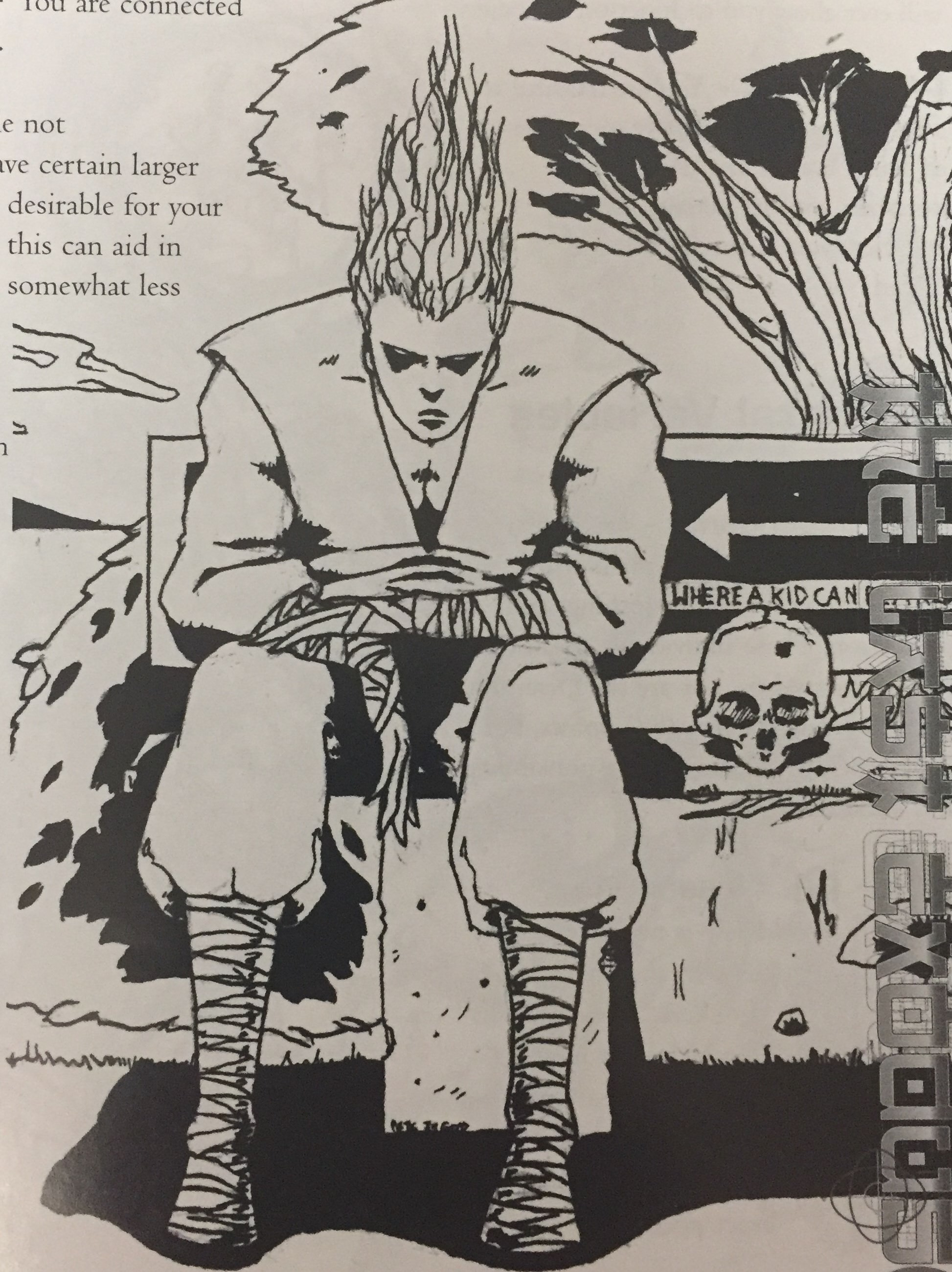
Alas poor yorrick, we have to ride the bus.
Art By: Peter Johnson
Finally, you know what the most mandatory part of any Heartstaker is? No, it is not supernatural things hiding from society at large and attempting to mesh their opposed experiences; it is a point buy advantage and disadvantage system! TLE, of course, takes it to the same level of excess that it has done everything else with. Here, you balance your human body advantages with your Deiform disadvantages and your Deiform advantages with your human body disadvantages. Reminder, the entirety of present day Earth gets thirteen paragraphs so maybe take that into consideration when deciding which of your forms to dump all the penalties onto.
I don’t think anyone is going to be surprised that very little here has any actual mechanical significance, either because the sentence has no qualification or because such rules don’t exist in the game. We’re talking “people view you as more truthful” and “you have a good relationship with a business” kind of useless. Of course, on the flipside a few of these 50 or so advantages are completely brokenly good and mechanically defined. We’re talking for the price of talking funny, treat every combat roll as though you have 5 more points in that skill in a game where 10 is the natural maximum a character can have. There’s also some rather obvious editing errors, such as repeating section headers for different sections.
I want to also mention that an annoyingly large portion of these are purely cosmetic things which until we reached this section I’d assume we’d have gotten to choose when the game said “imagine your concept”. If you want to be 6 foot anything or older or younger than about 35 you have to take an advantage/disadvantage. Want to be a little doughy, have a sonorous voice, or ambidextrous? Time to pay for the privilege.
Of course, beyond sabotaging your character concept. what would a section like this be without a mixture of embarrassing, unpleasant, and actively detrimental options? If you’re that creepy weirdo at the table, enjoy taking the perk "well endowed". If you’re an actively shitty person you can role play as a bigot, or get points back for being a sexual and ethnic minority, or combine all three if you really want to make your table ask you to leave. If you’re not here to play the game and have fun, you can choose to have your character be bound without free will to a powerful soul.
Honestly, let’s just copy the absolute most egregious one:
”Doomed - You’re gonna die. Badly. Time is running out for your character, and you know that at some point very soon something Godawful is going to happen to you and the best you can hope is that your friends don’t get caught in the crossfire. The Director can feel free to put the screws to you with unholy glee.”
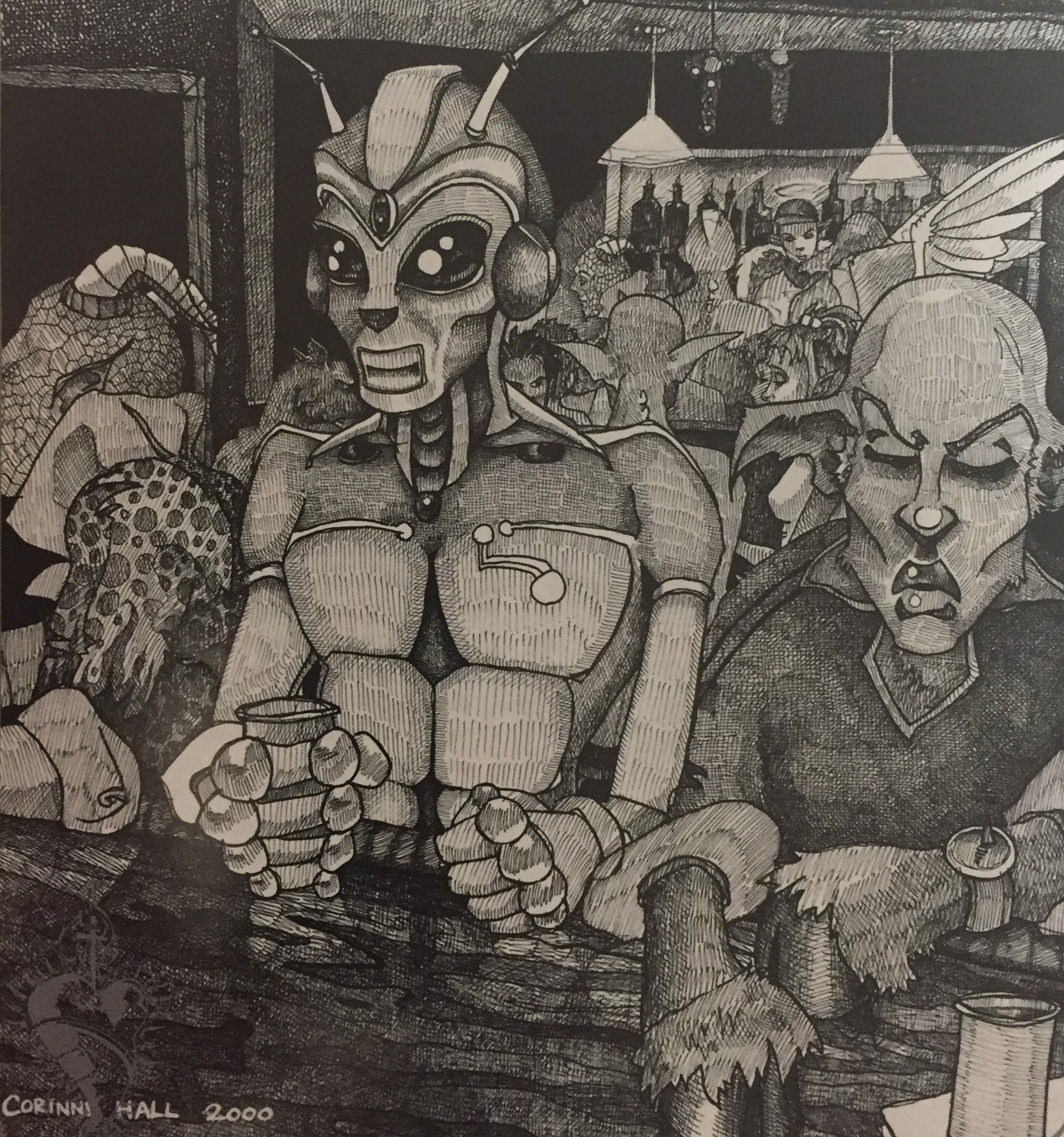
No, friend Goat Goblin, this unit does not understand how your watch tells time inside a bar
Art By: Corinne Hall
Thanks to one of these disadvantages I noticed that I might have interpreted one of the rules for stat distribution earlier incorrectly. I think you’re not supposed to get your Spiritual score in every stat while in Eden, rather, you have that many bonus points to split across the other stats. I.e., if you have 10 spiritual you can allocate 8 bonus points to Physical and 2 bonus points to Mental while in Eden but then you’re out instead of a free 10 to all three stats. It makes more sense to do this, but still makes Spiritual the best thing to dump 10 points into. I’m going to note now that the only statted NPCs in the game aren’t built using the Spiritual score this way, but they also fail to follow any of the other rules of this game so I should probably learn my lesson and just assume they don’t reflect the rules of the game at all.
Thankfully, once you finish reading the last of the advantages/disadvantages, the game just sort of decides it’s completely done having us build a character. It then ends the entire character creation section with three basically unrelated single paragraphs. The first explains how to calculate our health even though it’s almost verbatim copy pasted at the beginning of the system section. The second is two entire sentences telling you to make up your holy symbol as whatever you think is cool and telling you there is space on your character sheet to draw it since it has no mechanical impact at all. The third is an invitation to turn the page to learn how to play the game which isn’t actually true, there’s a two page art splash and fluff piece first, then the rules.
Fun fact about the last thirty four pages of the book entitled “System”:; only six of those pages are actually rules on the game’s mechanics.
Sigh, TTLESTIODASDSDF
Next Time: Wherein Everything Goes Horribly Wrong
*You can buy followers at character creation or earn them from the Director for being cool. If you buy them at character creation it costs one stat point per follower. It takes 10 followers to get any mechanical benefit. Instead of buying them using your stats, however, there is an advantage which grants 10 followers. TTLESTIODASDSDF
Wherein Everything Goes Horribly Wrong
Original SA post
Last Exodus the Interactive Story Arc of the Third and Last Dance is a roleplaying game from Synister Creative Systems published in 2001 and designed Sean and Joshua Jaffe. It’s a metaplot heavy, playing card deck using, religious themed urban grunge game. Unless I am otherwise notified it appears to be completely out of print with no digital versions available. Should this be incorrect I will update to include where it can be bought to give the original developers income.
Part 12: Wherein Everything Goes Horribly Wrong
We’re finally here. After one hundred and fifty-seven pages we are ready to be told how the game is actually played in the final section of the book, “System”. With only thirty eight total pages left in the book you’d be forgiven for thinking the majority of them are gameplay rules. Instead, even when being generous and including a roleplaying example of gameplay, there are only six pages of actual rules in this entire one hundred and ninety-six page book. There is so much wrong in the next six pages I had to make this two updates and I’m only going to discuss the most blatantly broken things. Let that wash over you then continue reading.
To start off with, unlike other Heartstakers, Last Exodus doesn’t use any dice, instead opting to use a single, regular deck of playing cards including jokers. When doing anything that requires a check, you simply draw and add the draw + your stat + your skill to determine your total, and compare it against the difficulty set by your Director. If you draw a joker, you draw another card and halve your total score and conversely if you draw a king you draw another and double your score. Same suite on the draw as the stat you’re using gives you a bonus +1 to the total and a king of the same suite as the stat you’re using is an automatic success no matter the total.
They never tell you when to reshuffle the deck.
I’m going to repeat that, in a game where the entire randomization mechanic is a deck of standard playing cards they never tell you when to reshuffle the deck. In fact, the word shuffle doesn’t even appear in this entire game. It gets more ridiculous; they must be assuming you are shuffling the deck between each and every draw and drawing the top card, all cards face down to the player but none of that is ever stated in the game or even mentioned in the examples of play. There is nothing in the rules indicating you couldn’t just put the cards in whatever order you want first, face up, and then hunt through them for the card you want.
TLETISAOTTALD
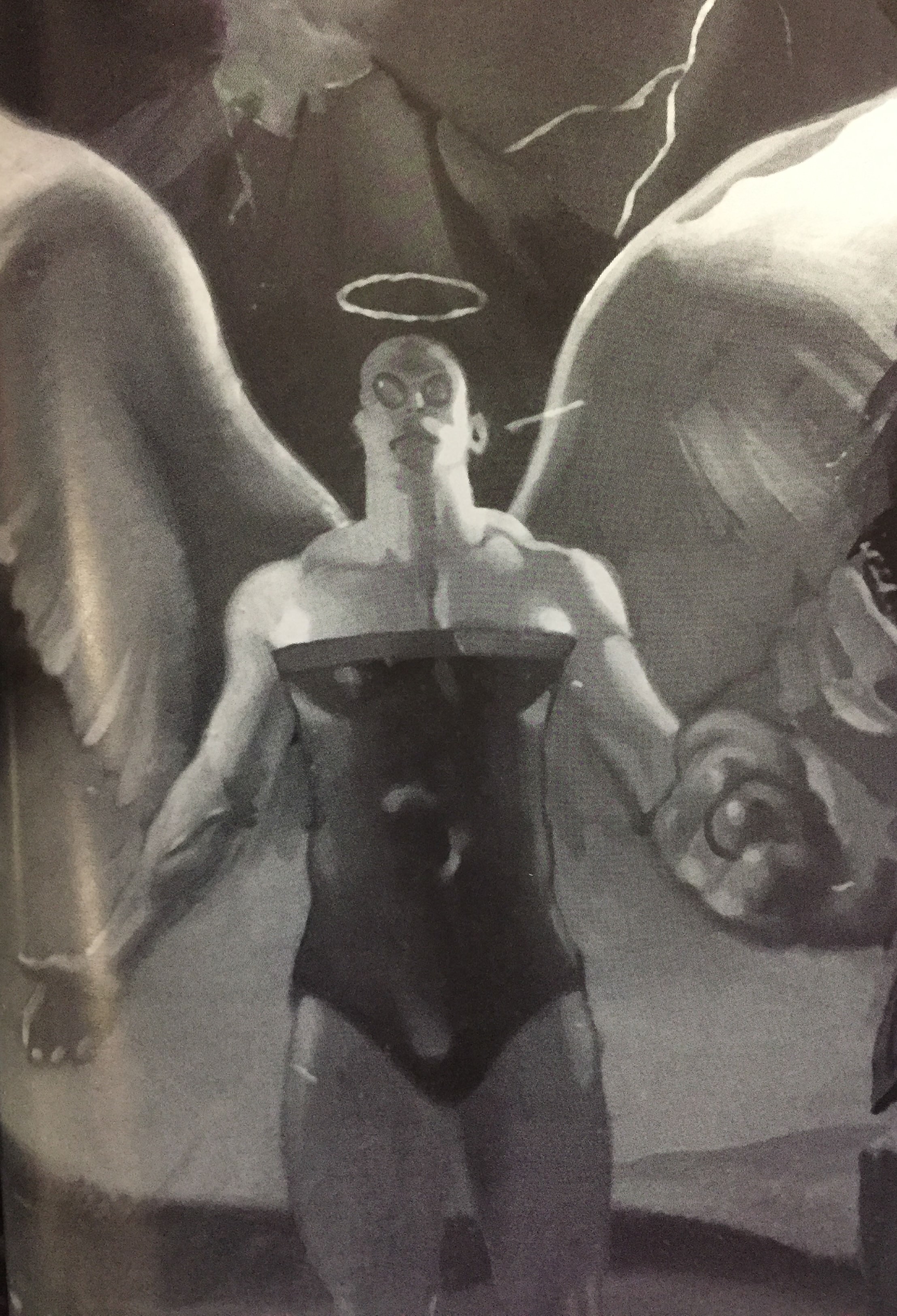
The size of my eyes when I realized it didn’t tell me when to shuffle. The strapless swimsuit was just for fun
Art By: Dennis Calero
Next up, remember how jokers halve your total score after they’re drawn? Well it turns out in literally the next paragraph that statement is a complete waste of your time because regardless of your total score after a joker you still automatically fail. The only exception is if you draw a non-suited king which just cancels out the joker and then you draw a third card and see if you pass the test or if you draw the suited king in which case you instantly succeed regardless. The game notes that drawing the suited king in such a scenario should be “the weakest possible success” so thanks game for shitting on my sub 4% chance to avoid critical failure. Math heads may note that even if we treat drawing any king from the deck as an automatic success after drawing a joker, drawing a joker is still 89% of the time going to be a failure for the player, so why even have them draw a second time unless you just like wasting time? I’m already shuffling a deck of cards for every single action in this game, I don’t need things to take even more time.
We now encounter the game’s difficulty scaling where we’ll learn rapidly you’re going to be hunting for kings. The game’s absolute easiest tasks have a score of ten, which means assuming you evenly invested your points at the start and don’t have a requisite skill, you only have about a 40% chance of failure on draw, which frankly, is pretty pleasant for an RPG like this. The problem is this system scales really badly due to our capped stat and skill scores. You maximize at ten in a stat and ten in a skill but challenges are encouraged to scale up to thirty.
Roughly speaking, each additional point needed from the draw to hit a score is roughly an 8% or so increase in failure chances for a player. If you’re more than twelve points below you can only succeed on a crit and even then, you still probably won’t because a king only doubles your total. For our thirty difficulty this is patently ridiculous; to get the gap down to only ten points needed from the draw requires investing more than half our stats into a single stat and a single skill of that stat, lucking out with that skill being the one used, and still having north of a 70% chance of failing. On Eden our stat maximum is six points higher so we could conceivably be over the target number before even drawing, so the Director certainly isn't going to have an incredibly, incredibly hard time figuring out what target numbers need to be.
Guess what, they're going to have a terrible time figuring it out because the game's examples of tasks and associated difficulties is absurd. A suggested Physical ten task is “cutting down a sapling”. Not caring what you look like when dressing yourself is a ten difficulty test. Dressing nicely for a high class party is a twenty challenge. To dress nicely for a party someone who invested a quarter of their starting points into Culture stat and all those skill points into the relevant skill* for just this one check, would only succeed without a king about 10% of the time.
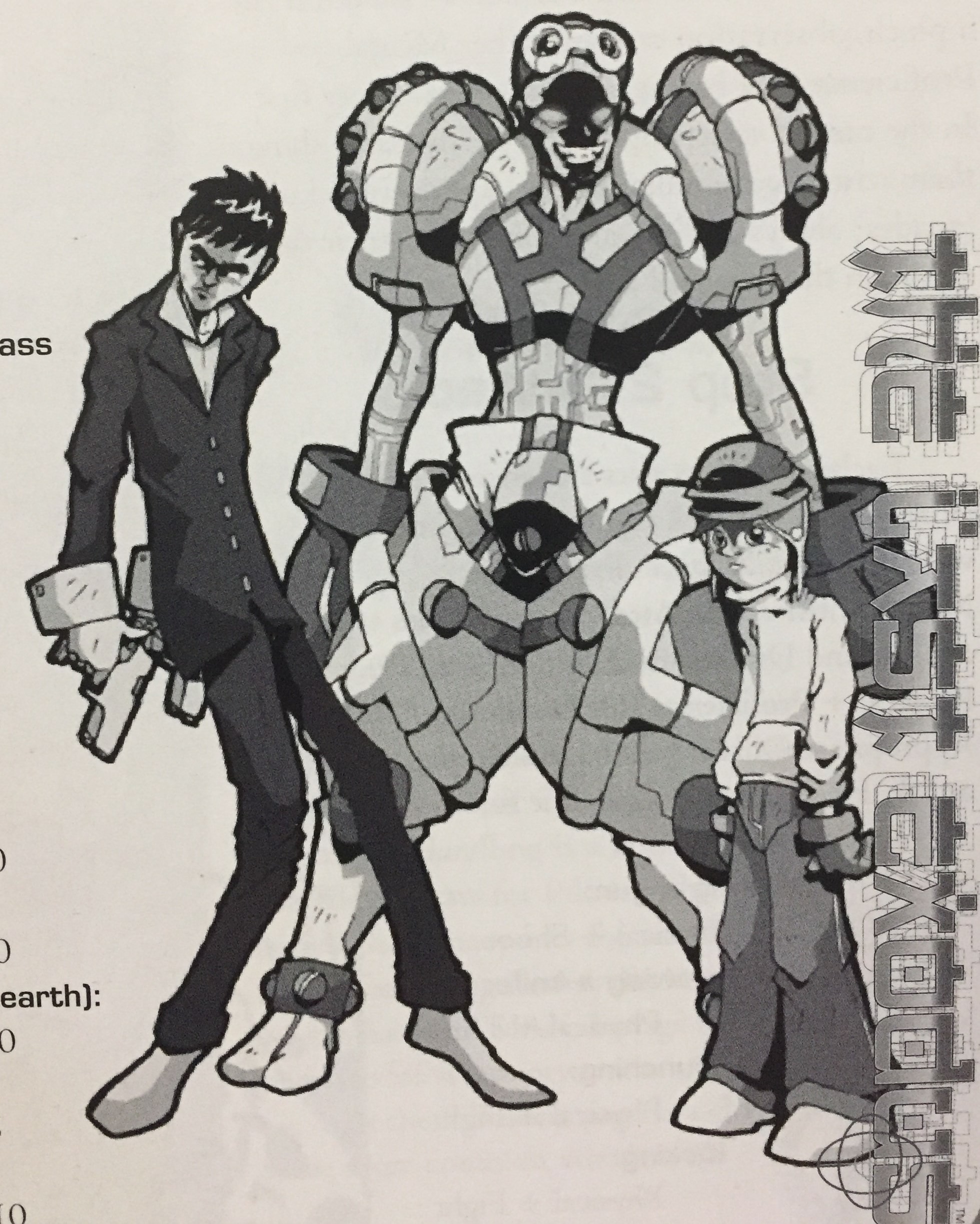
None of these dudes can do their taxes, a Mental 12 task
Art By: Clayton Graham
Ok, so maybe the games examples are extra harsh? No. Immediately after this list of suggested skill challenges like “finding a map online” being a difficulty ten test, the game drives the point home of just how lame your characters are. It states that Indiana Jones or James Bond should be considered the upper echelon for the kind of things PCs can ever hope to physically accomplish so set difficulties with that in mind. Oh man, I’m so glad that my character who can fly and download themselves into a computer in another dimension might one day after years of leveling up be powerful enough to still fail basic things like "resist fear of mundane snakes".
Fine, our party understands that if we’re going to regularly succeed at such tricky challenges as “intimidating a fourth grader” a challenge ten task, we’re going to want everyone to specialize as hard as they possibly can. After doing that though, we don’t have any real guarantees the skills we bought will ever come up and there are a lot of them per stat. Mental, for instance, has eleven skills it controls so you don’t even have enough to put one stat point into each. As one final “fuck you for wanting to reliably pass medium difficulty tests” don’t forget that you have to invest at least one point into physical or you’ll die instantly. Characters can’t actually maximize their Mental or Cultural stat at character creation, so those characters just have an extra 8% chance of failure on those tests out of the gate versus a Physical character.
For reference, this entire update is getting mad at what is two pages of this book. We still have four more pages of rules to go and they’re somehow more dense with issues.
Next Time: It Takes 5 Nuclear Bombs to Blow Up a Motorcycle, or Possibly Just One Rock
*The relevant skill under the Cultural Stat needed for this is called culture, which I assume is the Sanhedrin’s favorite skill that the True Sandhedrin had
It Takes 5 Nuclear Bombs to Blow Up a Motorcycle, or Possibly Just One Rock
Original SA post
Last Exodus the Interactive Story Arc of the Third and Last Dance is a roleplaying game from Synister Creative Systems published in 2001 and designed Sean and Joshua Jaffe. It’s a metaplot heavy, playing card deck using, religious themed urban grunge game. Unless I am otherwise notified it appears to be completely out of print with no digital versions available. Should this be incorrect I will update to include where it can be bought to give the original developers income.
Part 13: It Takes 5 Nuclear Bombs to Blow Up a Motorcycle, or Possibly Just One Rock
Two pages of rules down, four to go.
With the resolution system undercooked and the difficulty challenges way too high, it is time to start talking about combat which works even less correctly. There’s honestly so much wrong I’m just going to start this section with a list of things I don’t have time to get bogged down in discussing so we can talk about the really juicy stupid things.
- Remember how it said we could use magic on Earth if we have the appropriate skill? It flat out says the opposite here so figure out which section of the game is right.
- You defend against a type of magic in combat with the same skill. A caster according to the rules has to have at minimum six points invested between a stat and skill to cast the most basic spell, which is already tough unless you’re also a caster, but more likely to get the maximum benefit out of casting they invested every point available into it so good luck beating between an eighteen and thirty two point challenge not including the draw the caster gets on the attack.
- Every single combat action is based on either the Physical stat or the Mental stat. Did you think you’d help the team out by helping pass the insanely high difficulty checks for the Culture stat? TLE hopes you like dying a lot
- A ranged attack can be blocked by the defenders choice of the melee attack stats, as ranged attack stats can never be used to defend. You may note this means that a melee attacker will always be able defend extremely well against ranged attacks and 1/3rd of all melee attacks while a ranged attacker can defend well from exactly no types of attacks.
- Does it surprise you there are no movement rules or what ranged means or aggro mechanics, so in the above example the ranged guy is absolutely going to die the second combat starts?
- The NPCs in the back of the book use a different formula for calculating their health than the rules presented here which means that, officially, every single part of the NPC's stat block disagrees with the rules of the game.
- There is no time frame for actions in combat. Does it take six seconds to shoot a gun or six hours? Who knows! It may not sound important, but the time between “dying” and “dead” is measured in minutes.
- There are no rules for doing anything in combat except making attacks/using magic. If you want to say use a miracle, move, use an item, grab something, swap weapons, make a check, investigate, etc. etc. etc. you can’t.
- All attacks have to be lethal damage unless you use a TASER which can only stun, with stun not being a defined term anywhere in the rules
- In fact There are no rules for any status conditions. The game has abilities, powers, and attacks that inflict things like stunned, poisoned, and weakened. but not a single one of them means anything so none of those abilities do anything.
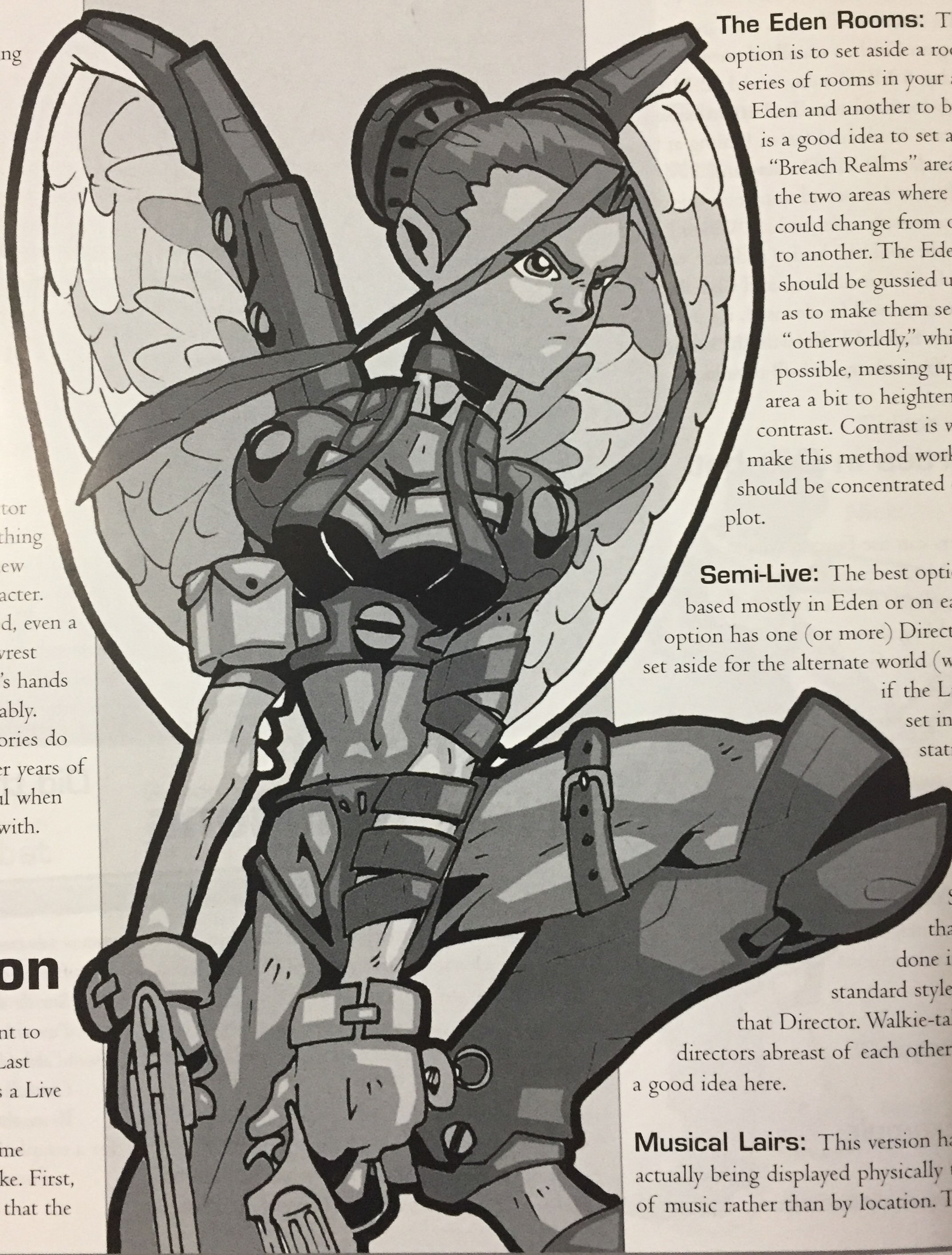
I’m not gonna bother pointing out all the things she has on her that have no rules in game because this update is long enough already
Art By:
So we established earlier that every check, and you’ll be doing a lot of them, requires you to draw at least one, and more than 10% of the time at least two cards. As if taking it as a challenge to bog the game down as much as possible every single attack is actually an opposed check. The attacker has their draw, the defender has their draw. The rules seem to, but don’t always so hell if I know, take for granted an infinitely deep deck for both sides of the draw, so for a combat between four players and four enemies, have fun shuffling the deck a minimum of sixteen times for a single round of combat.
Now, despite every single attack being a contest between the defender and the attacker, the game doesn’t say what happens if a defender gets a higher result than an attacker.
I’ll repeat, the game explains how defending works with regards to what skills you use to do so, but doesn’t tell us what happens if the defender beats the attackers total. Not only that, we can’t assume the attack just misses because the very next section on damage implies that some outcomes of defending are that the defender takes partial damage but there aren’t any rules for that. An extra maddening layer is in the example of play section one player fails to defend and another succeeds but the players agree they’ll figure out the damage later and then the dialog ends with no resolution. It’s like an entire section of the rules isn’t just missing, but purposefully excised like it walked along the riverfront with Stalin.
Fine, if every single round we’re going to get hit by an attack because defending doesn’t work, how does our health work? TLE decided that health had to be as absolutely confusing as possible and you have three separate health tracks that overflow into each other. MAX health is your Physical stat score, MOD health is your MAX*10, and MIN health is your MOD*20. A character with a single point in the Physical stat would therefore have health tiers of 1 MAX, 10 MOD, and 200 MIN. Weapons deal damage in the same tiering, MAX/MIN/MOD, and damage from a higher tier bypasses all lower health tiers and deals it directly to its tier; i.e. a MOD weapon deals no damage to MIN and takes directly from the MOD health track. When a character runs out of health in a tier all subsequent damage of that tier gets bumped up to the next level; i.e. if our example character took 200 MIN damage, and got hit for 10 more MIN damage they would instead take 10 MOD damage.
Of course with these basic rules established, TLE’s health system begins to collapse in on itself like a college communists club. First and foremost, you may notice characters have an obscene amount of MIN health compared to MOD or MAX. Min weapons don’t deal any larger numbers of MIN damage than MOD weapons do MOD damage. The most powerful MIN weapon is “Cue Ball in a Sock” and deals 35 MIN. The weakest MOD weapon is “a pipe” and it deals 10 MOD. One of these takes six turns to knock out our example character with the minimum health they can have and the other one takes only one turn.
Healing of course has the exact same issue as damage on weapons. You heal ½ MAX, 10 MOD, and 20 MIN a day at the peak of health regen while on Eden. It therefore take 10 days for our example character with one point in Physical to get all their MIN back, and Ahura Mazda help them* if they had sixteen total physical and needed to heal the full 3,200 MIN they need to faff about for 160 days. The only healing spell that can restore MIN maxes out at healing 10 MIN.
TLETISAOTTALD

It’s like a dude from accounting wanted to break his spine while posing with nerf guns
Art By: Peter Johnson
We’re not done yet, health gets even stupider when we look at what happens when a health tier depletes. If you run out of MIN health, you’re knocked unconscious and need medical attention. If you run out of MOD health, you’re unconscious, need medical attention and every hour you lose a point of MAX health. If you run out of MAX health you stop breathing after a number of minutes equal to your Physical stat.
That’s right, attacking MIN health is a complete suckers game and provides no benefit whatsoever that targeting the way easier to hurt MOD health wouldn’t and doesn’t put you on the death spiral track that losing your MOD or MAX health would. Your party will be decked out likely in MOD weapons, since MAX weapons are a little rarer as they are almost all universally strapped to vehicles and the two handheld MAX weapons have actual defined drawbacks. Unfortunately for everyone’s survivability the MAX weapons strapped to vehicles start at 30 MAX damage and most are described as hitting multiple people with a single shot so in theory they can kill the entire group of PCs in one attack.
Notice how the previous sentence said “in theory”? There are no definitions for the terms “unconscious” or “stop breathing” or “die” or “dead”. Like all other status effects that do nothing in this game, as far as TLE is concerned losing all your MAX health does nothing, and you can happily keep fighting forever.
Let’s assume now, for the sake of the rest of this stupid game, that the rules work as it seems they’re intended; running out of MIN or MOD health puts you at the complete mercy of other conscious players or enemies as you can no longer take any actions, and being out of MAX means you’re dead and your Soul goes to Eden or, if you died while on Eden, you’re dead forever and you need to make a new character.
With these sensible rules in place, the game is about to make combat in this game insanely deadly beyond just vehicle weapons exploding the party like a gore pinata. When you hit someone successfully with an Earth weapon regardless of what realm you’re in they have to draw a card, and funnily enough every weapon in the game except two that are buried in the appendix and not with the rest of the weapons in this section are Earth weapons. If the card drawn after dealing damage with an Earth weapon is a king, the recipient of the damage takes damage of one tier lower** than the weapon normally deals. A hand cannon, for example, normally deals 20 MOD would only deal 20 MIN on a drawn king. Conversely, if the drawn card is a joker, which reminder will get drawn a little under 4% of the time, the tier of the damage goes up one level, so our hand cannon would suddenly deal 20 MAX. You may now start to remember that the absolute highest possible Physical Stat is investing all sixteen of your stat points at character creation into Spiritual and Physical, gives you a combined 16 MAX health only while in Eden.

This is going to happen a lot
Art By: Peter Johnson
After watching our scion die instantly every 26 rounds or so in on foot combat, and instantly against a vehicle, maybe we want a little more protection and start eyeing some armor. Congratulations, armor only gives you extra health and only MOD or MIN and not both, so a joker elevating damage will still instantly murder you. To highlight just how badly thought out this game is consider the following: There is a box on the page with combat rules that show all four armors available in the game. You’d think the one that gives you an additional 30 MIN health would be thing they obviously didn’t think through but then you see that two of the armors give you 20 MOD health, but one has a penalty to wearing and the other doesn’t. That’s literally the only difference between them. TLE created two different kinds of trap items on a list of four things
Fine, if armor won’t save us, lets look at vehicles and hope they’ll protect us. Vehicles get one (1) paragraph of rules and you’re about to be blown away by the amount of issues they pack into a paragraph. First, vehicles have a stat Speed which isn’t a fixed or even defined speed, instead it’s just a number relative between a Bicylce at 1 and a Spaceship at 20. The idiocy of this system for speed is compounded when you remember the game has no rules for movement. Second, vehicles have a stat called “Handling” which while it functions logically as a flat bonus to piloting checks, the vehicle list has oddities like a civilian helicopter having handling 1 but a military helicopter having handling 0. Third, last, and most egregious, vehicles have a Body stat which is, and I quote, “how many hits a vehicle can take before being destroyed”.
I’m pretty sure they meant “damage”. We’re all pretty sure they meant “damage”. But that’s not what they wrote so let’s treat this section RAW. A nuclear bomb’s damage is listed on the damage table as “enough” which, again, isn’t defined so it technically does nothing, but I’ll assume it means it deals whatever it hits total amount of health as damage. Vehicles don’t have health though, they have hits. A nuclear bomb isn’t listed as hitting multiple times, just hitting multiple things. Thus, to destroy a motorcycle with its Body score of 5, it would take five nuclear bombs before the motorcycle was no longer operable. Conversely, since the damage of the weapon is irrelevant, you could take it out by throwing a handful of small rocks at it.
I’m sure you’re now yelling at me, “be reasonable, monsieur Barudak, let’s give them the benefit of the doubt and assume they meant that sentence to read damage not hits.” Fine, but this doesn’t make our problems with vehicles any less ridiculous. See, the game doesn’t note any resistance to damage inherent to vehicles and remember, damage goes up to the next tier if you don’t have any health left in the tier below. With this interpretation, suddenly hitting a car with a tiny rock wrecks a car with enough leftover to destroy a motorcycle, and one hit from a cue ball in a sock causes the immediate, catastrophic destruction of a commercial airliner.
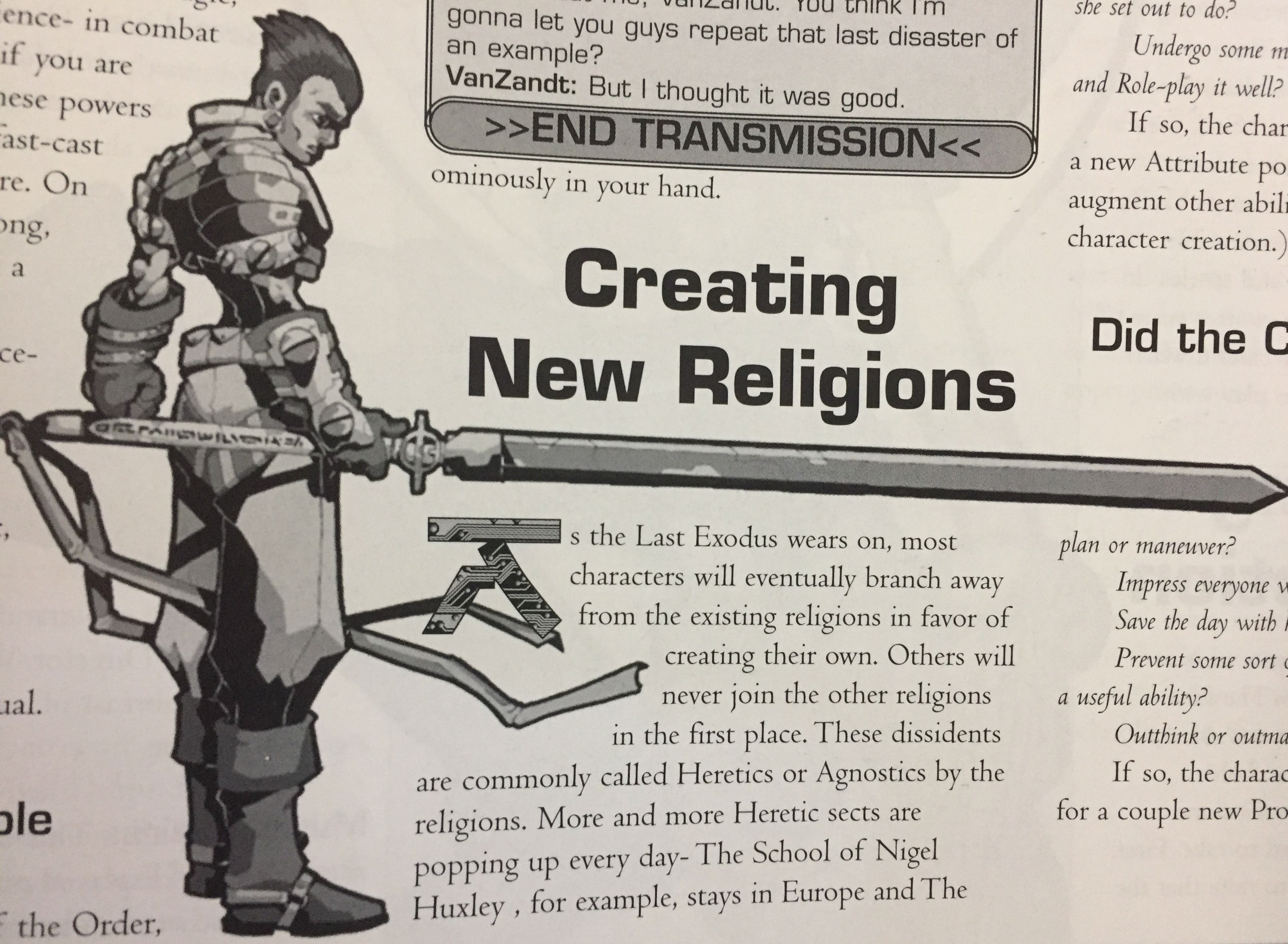
His sword is literally longer than the paragraph for the vehicle rules
Art By: Clayton Graham
So now that combat between two people is a game of rocket tag and combat between two vehicles is either a long, grinding stalemate between people throwing rocks at each other from their vehicles or a swift, explosive orgy of violence between two people in vehicles throwing rocks at each other, the game provides two narrative examples of combat. These examples provide absolutely no useful information or help interpreting the rules, except making it painfully clear TLE expects combat to take a really, really, really long time to resolve with checks at every opportunity to have checks including “successfully crouching behind a dumpster.” They also contain a plethora of godawful jokes like “He’s down like a White House intern in the late 90’s” and terrible references like “I’m gonna try and trap the spook in a Pokey-Ball”. I did double check and no, Jay Leno*** is not a listed writer for this game.
We’re nearly at the end of the six pages of rules but a sever bout of layout whiplash, the next section following the examples of play is a brief summary of how players can create their own religion. This has no bearing on how the game is played and is primarily more setting fluff shoved into two paragraphs which are then chased immediately by how to dole out experience points in game.
TLE, as it turns out, has no fixed XP scheme or rules, and it’s purely up to the Director to determine when they are awarded. The game provides examples of what actions are worthy to get specific benefits, but most of them are fairly in depth character moments like “Gain some form of self-actualization” or “take steps to personal change”. I don’t think things like that are going to happen more than once or twice an entire campaign so I hope you maximized your stat points at character creation. In the truest TLE fashion one of the lists of examples of play to earn benefits is for things you can do reliably like “entertaining people” and “roleplay well” except this is the one list they forgot to include any rewards for
TLETISAOTTALD
Next time: Not One But Two Lists of Influences on This Game
*They won’t do anything, they don’t care
**There are no rules on what happens if you draw a king on a MIN weapon so I dunno, maybe it heals you?
***#thisjokeisitselfjustasdated
Not One But Two Lists of Influences on This Game
Original SA post
Last Exodus the Interactive Story Arc of the Third and Last Dance is a roleplaying game from Synister Creative Systems published in 2001 and designed Sean and Joshua Jaffe. It’s a metaplot heavy, playing card deck using, religious themed urban grunge game. Unless I am otherwise notified it appears to be completely out of print with no digital versions available. Should this be incorrect I will update to include where it can be bought to give the original developers income.
Part 14: Not One But Two Lists of Influences on This Game
We come now to the end of this game, which isn’t so much a graceful endcap to what has come before as the game finally letting go and plunging into the chasm below. The entire end section is badly organized and unfocused which isn’t as bad as it should be because this section contains almost no useful information. Well, unless you are a registered crazy person like me and want to credit the artists you’ve been including in a review nearly two decades after this game first came out.
So in terms of pacing, this immediately follows the complete disaster that are the rules of the game which end with how to grant XP. Naturally, what that smoothly segues into are suggestions on how to run this as a live action role play aka LARP. I’ve never seen a book try to hype a LARP element before, much less hype a LARP element in a game where the characters they’re playing as would be less physically and mentally capable than the people playing them. TLE pitches itself to the LARP aficionado by saying its resolution system makes it uniquely suited to LARP because it uses cards instead of cumbersome dice, but since I still don’t know when to shuffle the deck in their game I disagree pretty strongly.
The suggestions for how to run this as a LARP start with advice that is flat out better than how TLE suggested to run the game when it was sitting at a table. The Director is encouraged to be a referee and simply help players guide the sort of story they want to tell and to use a strong hand to make sure nobody gets uncomfortable or upset. TLE helpfully suggests the Director can maintain order by never allowing players to hit each other, maybe not having everybody LARPing all get high at the same time, and reminding all the players to wear a condom when they have sex. No, I didn’t make any of that advice up, and yes, that advice is longer than the entire section on vehicle rules.
With that good advice out of the way the game encourages you to have two separate directors and two distinct rooms functioning as Eden and Earth for people to play with that all need separate ambience and props. Don’t wear KKK outfits when cosplaying it interjects, which is good, before promptly diving back into suggesting having two Directors for its two room setup and have them talk on walkie-talkies to each other, which is really bad. TLE is noticeably really, really insistent on music when discussing the setup for LARP be it ambient music, theme music, contextual music, your favorite music, whatever you must have music. TLE unashamedly recommends you, “[...]spend a few hours before each session grabbing appropriate tunes.”
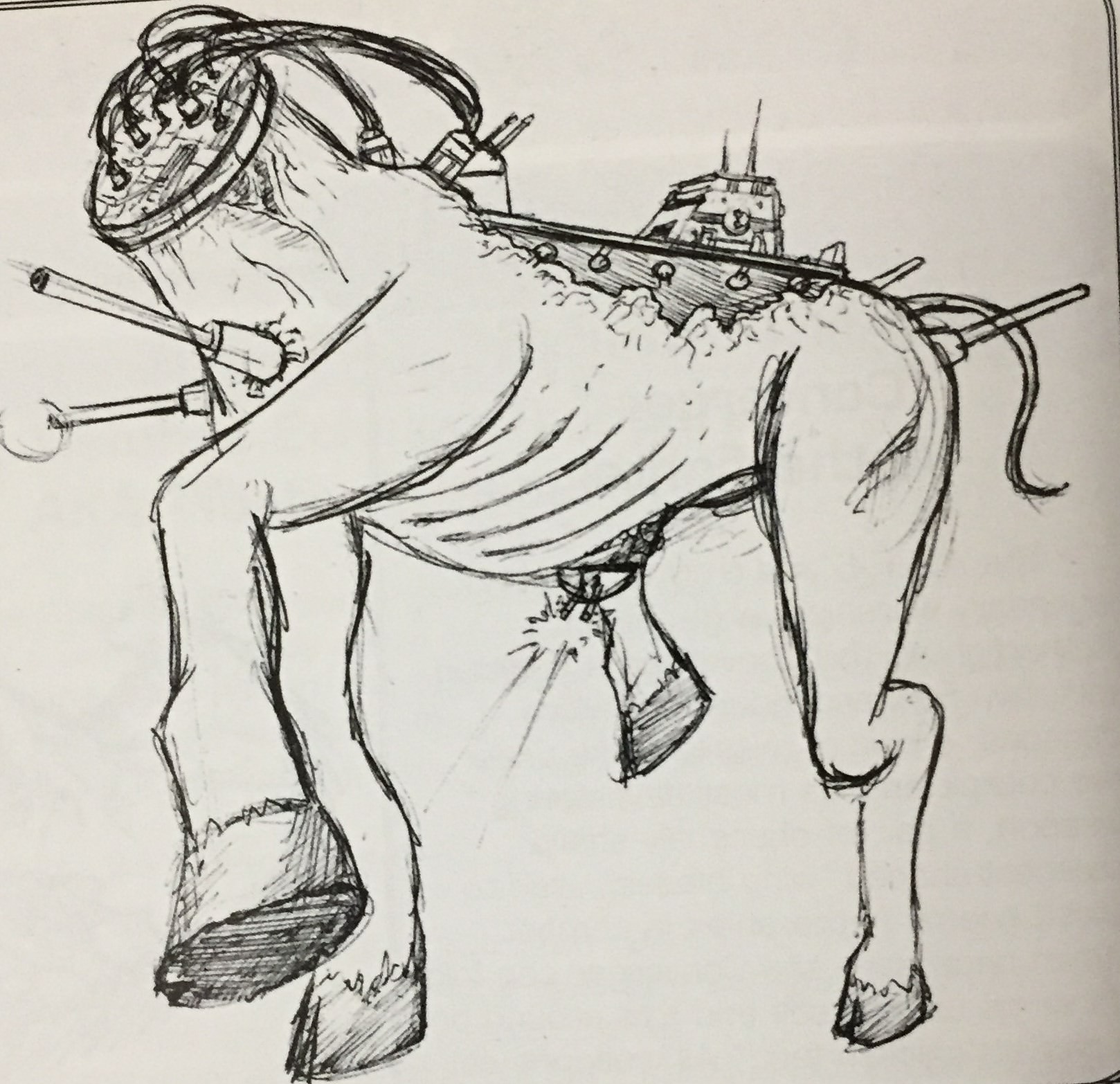
There’s compensating and then there’s this
Art By: Frank B. Fallon
So after buying walkie talkies, pot, and spending three hours on Kazaa searching for just the perfect song to roleplay a robot alien and bone down to, you might vaguely remember how we still don’t know exactly what you’re supposed to do in a game. Heck, you think, as you start picking out the perfect skull decorations for tonight’s session, the setting constantly undermines itself in all sorts of interesting new ways, how can that possibly work as a coherent game? Well never fear, TLE includes some helpful plot hooks but with a sliiiiight catch: all of the plot hooks are alternate universe “What If” scenarios and explicitly are intended to be unlike how the game proper should be played.
TLETISAOTTALD
Actually, I TLETISAOTTALD’d too early. One of the playable stories is one where the player characters get to replace the settings Apostles and play as their own very important(™) leaders of the Millenium religions and all around super cool people which sounds like it might actually be fun and have a discernable goal. Except, surprise surprise, this plot hook ends with the note that the PC versions of the Apostles will live their lives, quote, “knowing that they have to begin the war but are powerless to finish it”.
TLETISAOTTALD
The next twelve pages of the book are a mixture of items, NPCs, flying Eden cars, and locations like “McDonalds, but in Eden” which isn’t a joke it is literally called the Church of St. McDonald. The NPC stats in this section are built so incorrectly according to the game’s rules that every single part of the NPC’s stat block breaks the rules in some way. It’s not like they were designed for an earlier version and never updated so much as they were designed for an alternate dimensions finished product. The description of locales get in on the fun with the heaven sushi joint basically calling all non-Japanese asian food and culture trash out of completely nowhere and the Coke analog existing solely to make a “The Gods Must Be Crazy” reference. I’d write more about this, but in a book that features an unambiguous savage heart of darkness to represent Africa, who even cares anymore.
Following the hodgepodge of random things is a glossary and the index which I’m not going to go over in any detail since it is mostly a rehash and also forgets some terms, forgets pages terms appear, and includes references to terms by the wrong name. To one up this editing incompetence, the glossary manages to undermine elements of the game’s setting with regularity as well. Ahura Mazda is noted as capable of incarnating into a Soul, thus eliminating any reason for any player character to exist. For reference by the way, the glossary alone is four pages long, making a supposed reprinting of material from earlier in the book is 2/3rds the length of the games rules.
If you thought the game would end with the index, WRONG! The game next plops a final page of in-universe genre fluff at us by the brother of the Van Zandt that wrote the fluff at the beginning. I’m not copying any of this terrible story, as it is absolutely terrible. The funniest part is it tries very hard to be serious and emotionally affecting about how the author is grieving over their brother’s death before undermining it completely by pointing out the other brother is now in Eden in their words “flying dogfights, swinging on ropes, and fighting the good fight” and can presumably you know travel back to Earth at any time since he’s a PC and all.
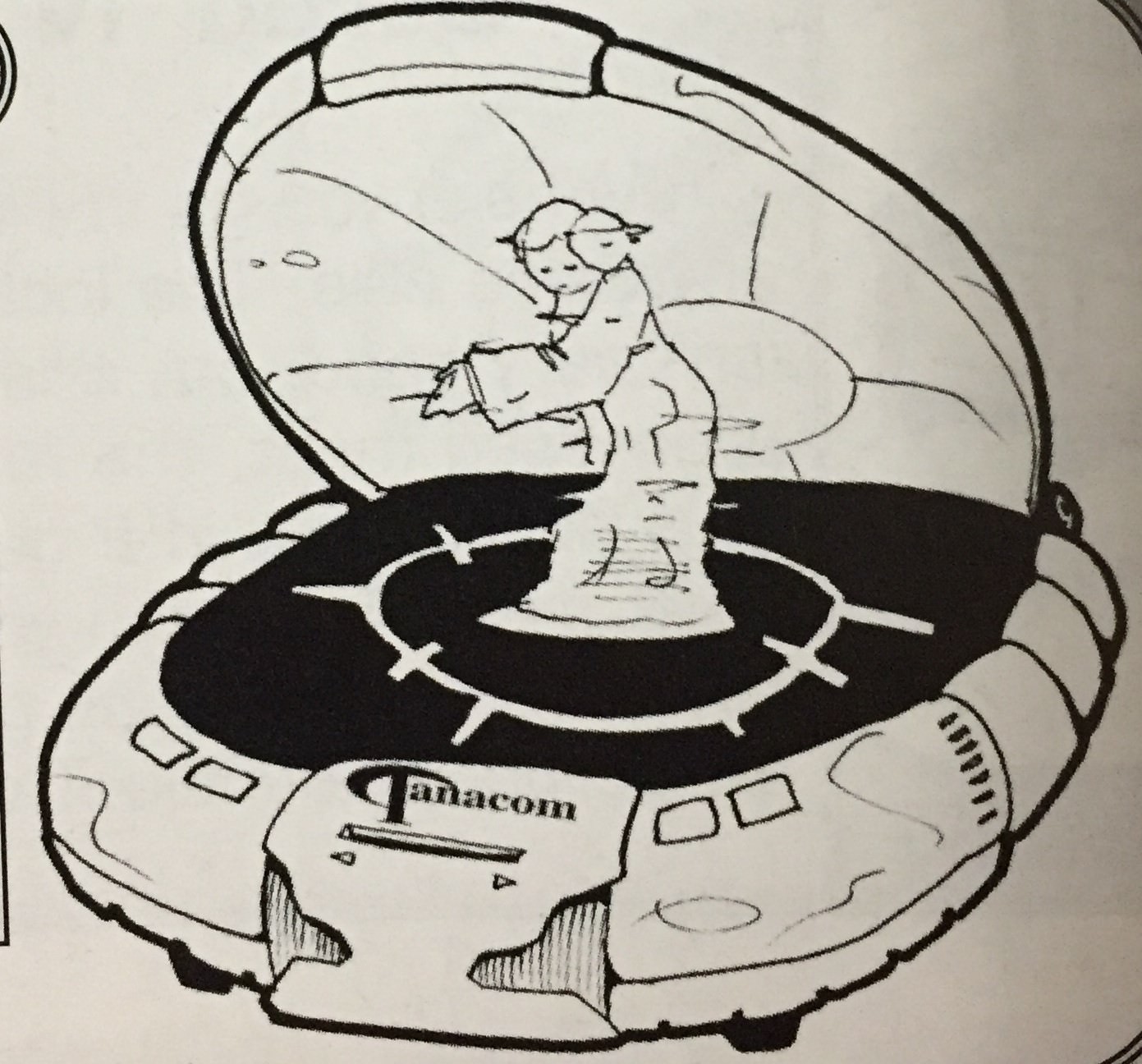
Pictured: The only reference to Star Wars I can find in this game
Art By: Clayton Graham
With the game’s fluff finally behind us, it’s time for the lead designers, the siblings Jaffe, to talk to us about why they made this game and what the influences are. These are basically long, blog-post style pages with almost no formating except to remember to include a bold “influences” header when they finally start focusing on that. Let’s dive in.
The first of the two, Sean Benjamin Jaffe refers to themselves as “Reverend Mother” which, whoa there bucko that title is for people who can manage to not undermine their own setting every twenty pages. Their section indicates that, pretty rightfully, they’re upset that as a society people pay more attention to celebrity gossip than actual tragedies. Unfortunately, the tack they take with this outrage is to encourage us, the reader, to play this game and it reads like Sean genuinely thought playing this game would somehow encourage real-world activism even though the game has absolutely none of that in it. Sean’s influence list carefully includes examples from all kinds of media and almost none of them have any cohesive relationship to each other, except, helpfully, the ones that Sean spends any time talking about beyond just name dropping. These discussed influences are Blood Music by Greg Bear, the band My Life With The Thrill Kill Cult, the comic Preacher, Kevin Smith’s oeuvre and specifically Dogma!, and then it teases a broadway play which they don’t name because it’s supposed to be so obvious what it is just by reading this game*.
The other sibling, Joshua Brain Jaffe who goes by “Pidge”, takes a very different approach to the personal thoughts section prefacing the list of influences. I’m not going to discuss the preface in depth or make any fun of it; it is a heartfelt outpouring of raw emotions for Joshua and Sean’s recently deceased mother. The influences list that follows, though, shows a very different focus from Sean, consisting of nearly an entire column of text consisting solely of uninterrupted musicians and bands. If you name an artists who released music but wasn’t mainstream pop in the 90s they’re probably on this list because it is exhaustive; who even remembers Dred Scott? The rest of Joshua’s list is a movie or two, Voltron, children’s cartoons and the one book author not even a specific book.
Taken separately, it’s hard to really see where the game came from other than a good portion of the music choices that pepper this book. Between the two of them, they don’t have a lot of overlapping media and even within those media their interests diverge. What helps though, is looking at what few things overlap. The only things on both their lists of influences are Star Wars, the Matrix, Kevin Smith Movies, My Life With the Thrill Kill Kult, and Wu-Tang Clan, which seems to succinctly explain everything wrong with this game in a lot less words than I took.
The rest of the book is shoutouts to their play testers, friends and family as well as a pizza parlor, and people and things from the online world they appreciate like rpg.net and a person named Michael Gentry who the game helpfully says, “if you don’t like anything about the book, it’s his fault”. Then it’s time for art credits, the “Upcming Products” section, promotion for a totally unrelated monthly pulp magazine called “Thrilling Tales” and the character sheet.
With the book finally done and closed out, I wish you warmest regards as I now begin the onerous task of emailing this analysis of TLE to every single human being named Michael Gentry.
*Seriously, I have no idea what it is. Any guesses?

